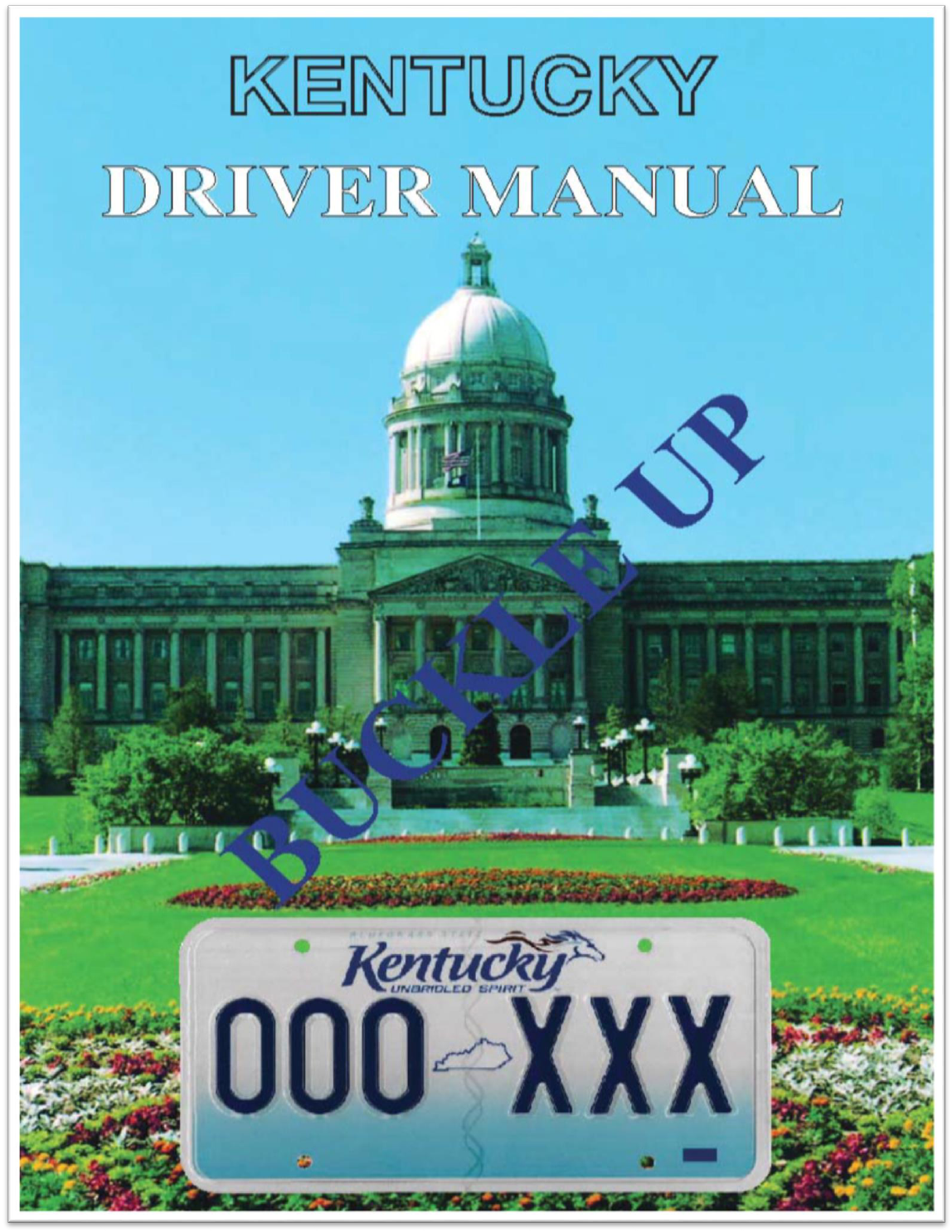
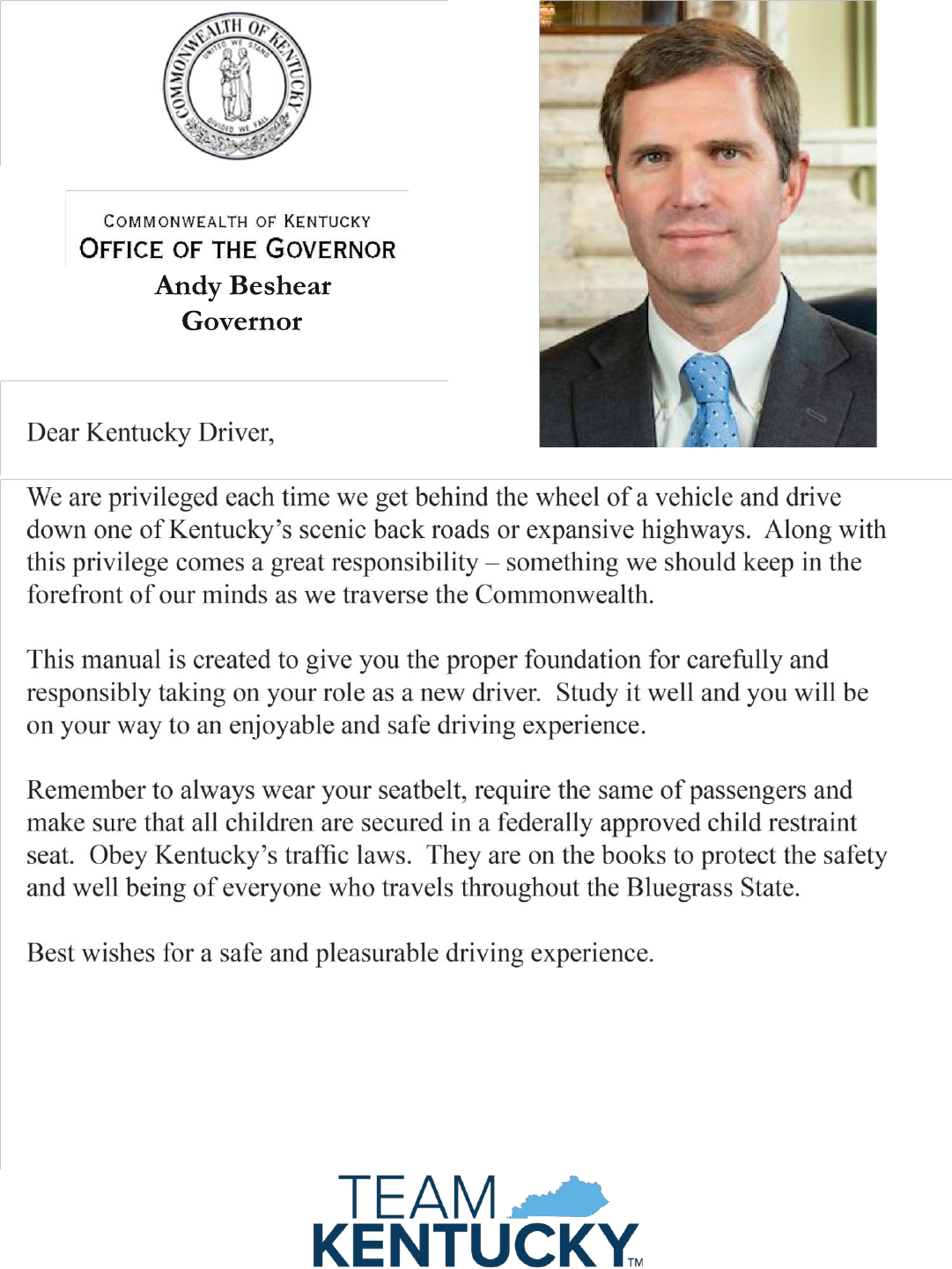
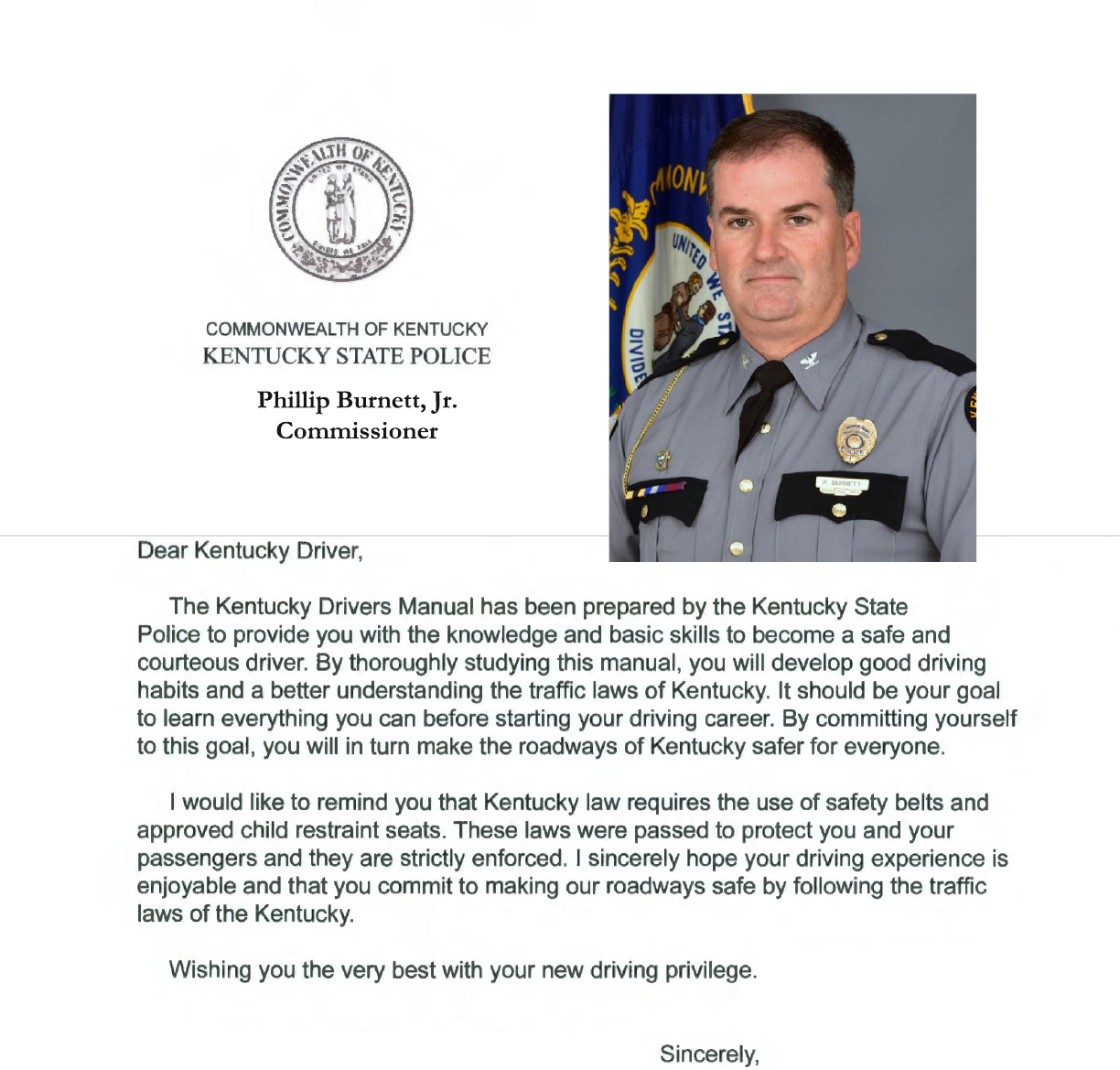
Phillip Burnett, Jr.
Commissioner
Kentucky State Police

Contents i
Table of Contents
Section One The Driver’s License ............................................................................................................ 1
About This Manual ...................................................................................................................................... 1
Types of Driver’s Licenses and Driver’s Permits ................................................................................... 1
Licensing Requirements ............................................................................................................................. 4
Testing Requirements and Preparation .................................................................................................. 10
Test Scheduling .......................................................................................................................................... 13
Out-of-State License or Driving on an Existing License .................................................................... 13
Driver License Renewal and Updates ..................................................................................................... 16
Loss of Driving Privileges ........................................................................................................................ 16
Section Two General Information ......................................................................................................... 19
Motor Vehicle Registration ..................................................................................................................... 19
Insurance Law ............................................................................................................................................... 19
Medical Review Board ................................................................................................................................. 20
Motor Vehicles and the Environment ......................................................................................................... 21
Organ Donation .......................................................................................................................................... 21
Section Three Be in Shape to Drive .......................................................................................................... 22
Vision ........................................................................................................................................................... 22
Hearing ........................................................................................................................................................ 22
Fatigue ......................................................................................................................................................... 22
Driver Distractions .................................................................................................................................... 23
Emotions, Aggressive Driving and Road Rage ..................................................................................... 23
Aging Drivers ............................................................................................................................................. 24
Alcohol, Other Drugs and Driving ......................................................................................................... 25
Section Four Before You Drive ............................................................................................................... 28
Inspecting Your Vehicle ............................................................................................................................
28
Adjusting Seat and Mirrors....................................................................................................................... 28
Using Safety Belts .......................................................................................................................................
29

Contents ii
Air Bags ....................................................................................................................................................... 30
Child Passenger Safety Laws .................................................................................................................... 31
Secure Your Load ...................................................................................................................................... 31
Advanced Driver Assistance Systems (ADAS) Safety Features ......................................................... 32
Section Five Basic Driving .................................................................................................................... 33
Starting the Engine .................................................................................................................................... 33
Moving the Vehicle ................................................................................................................................... 33
Stopping the Vehicle ................................................................................................................................. 33
Steering ........................................................................................................................................................ 33
Backing Up ................................................................................................................................................. 33
Section Six Rules of the Road ............................................................................................................. 34
Yielding Right of Way ............................................................................................................................... 34
Traffic Control Devices ............................................................................................................................ 34
Traffic Signs ............................................................................................................................................... 35
Pavement Markings ................................................................................................................................... 39
Other Lane Controls ................................................................................................................................. 39
Section Seven General Driving ................................................................................................................ 42
Turning and Turnabouts .......................................................................................................................... 42
Intersections ............................................................................................................................................... 43
Roundabouts and Traffic Circles ............................................................................................................ 44
Rules for School Buses ............................................................................................................................. 44
Parking......................................................................................................................................................... 44
Use of Lanes ............................................................................................................................................... 46
Entering a Multi-lane Highway ............................................................................................................... 47
Exiting a Roadway ..................................................................................................................................... 47
Passing ......................................................................................................................................................... 47
Section Eight Safe Driving Tips ...............................................................................................................49
Visual Search .............................................................................................................................................. 49
Speed Management .................................................................................................................................... 49
Stopping Distance ......................................................................................................................................
50
Space Management ....................................................................................................................................
51

Contents iii
Backing ........................................................................................................................................................
52
Communicating .......................................................................................................................................... 52
Section Nine Emergency Situations and Avoiding
Crashes
....................................................................54
Emergencies and Avoiding Crashes ....................................................................................................... 54
Collisions ..................................................................................................................................................... 55
Vehicle Malfunctions ................................................................................................................................. 56
Section Ten Sharing the Road .............................................................................................................. 58
Pedestrians .................................................................................................................................................. 58
Bicyclists ...................................................................................................................................................... 59
Motorcyclists .............................................................................................................................................. 61
Commercial Vehicles ................................................................................................................................ 62
Emergency Vehicles .................................................................................................................................. 63
Police and Traffic Stops ........................................................................................................................... 64
Move-Over Laws ....................................................................................................................................... 64
Slow-Moving Vehicles .............................................................................................................................. 65
All-Terrain Vehicles (ATVs) .................................................................................................................... 65
Section Eleven
Special Driving Situations
.................................................................................................
67
Night Driving ............................................................................................................................................. 67
Funeral Processions .................................................................................................................................. 67
Work Zones ................................................................................................................................................ 68
Rural Road Driving ................................................................................................................................... 68
Autocycles ................................................................................................................................................... 69
Safe Trailering ............................................................................................................................................ 69
Section Twelve Test Your Knowledge ....................................................................................................... 71

1 Section One: The Driver’s License
Section One
The Driver’s License
About This Manual
Any new or current resident of Kentucky who
plans to drive a motor vehicle on Kentucky
roadways must first secure a Kentucky
driver’s license. Kentucky issues a driver’s
license to ensure that each driver has the
basic skills necessary to be a safe, efficient,
and responsible driver. Safe driving may be
achieved by acquiring the necessary skills,
mastering those skills through practice,
being mindful of safe driving practices, and
adhering to Kentucky traffic laws. The
purpose of this manual is to help all drivers
achieve a basic understanding of safe
driving skills and best practices. It also
provides a review of the licensing process
and Kentucky traffic law. Studying the
contents of this manual is the best way to
prepare for the testing required to obtain a
Kentucky driver’s license.
Types of Driver’s Licenses and
Driver’s Permits
In Kentucky, there are several types of
driver’s licenses represented by classes, and
the vehicle driven determines the type of
license needed. The Class A, B, and C
licenses are types of commercial licenses.
The Class D license is the basic Operator’s
License. The Class E is for mopeds only,
and the Class M is for motorcycles.
Commercial Driver’s License (CDL) –
Class A, Class B, Class C
Commercial Motor Vehicle means a motor
vehicle or combination motor vehicle used
on a highway in interstate commerce to
transport passengers or property.
Commercial drivers are persons who
operate commercial motor vehicles whether
they are employed to do so or not.
This means the CDL requirements apply to
volunteer drivers, such as church bus
drivers, private and public-school bus
drivers, mechanics, salesmen, etc.
Commercial drivers must have one of the
following three classes of CDL:
Class A – Any combination of vehicles with
a gross combination weight rating of 26,001
pounds or more provided that the gross
vehicle weight rating of the towed vehicle is
in excess of 10,000 pounds.
Class B – Any single vehicle with a gross
combination weight rating of 26,001 or more
pounds or any such vehicle towing a vehicle
not in excess of 10,000 pounds gross
combination weight rating.
Class C – Any single vehicle with a gross
combination weight rating of less than
26,001, which is placarded for hazardous
materials or designed to transport more than
sixteen (16) people including the vehicle
driver.
A Commercial Driver’s License is not
required for:
Operators of passenger trucks and cars,
motorcycles, and mopeds that do not
meet CDL requirements and not used for
commerce.
Non-civilian operators of military vehicles
owned and operated by the military.
Operators of firetrucks and rescue
vehicles while such vehicles are being
used in emergency and related
operations.
This
Section
Covers
•
About This Manual
•
Types of Driver’s Licenses and Driver’s Permits
•
Licensing Requirements
•
Testing Requirements and Preparation
•
Test Scheduling
•
Out-of-State License or Driving on an Existing
License
•
Driver License Renewal and Updates
•
Loss of Driving Privileges

Section One: The Driver’s License 2
Operators of recreational vehicles not for
commerce.
A driver of vehicles used exclusively in
farm-to-market agricultural transportation,
owned, and operated by the farmer or his
employees, and used within 150 miles of
the point of origin.
Additional information can be found on the
Kentucky Transportation Cabinet (KYTC)
website drive.ky.gov and in the CDL Manual.
Operator’s License – Class D
A Class D Operator’s License is the driver’s
license required to operate a motor vehicle.
The Class D license is the class most
commonly held by Kentucky drivers and is
the primary focus of this manual. Any current
or new resident of Kentucky who plans to
drive a motor vehicle will need an operator’s
license. Applicants must be a Kentucky
resident and be at least 16 years of age. If
the applicant is under the age of 18, a parent
or legal guardian must sign the application.
All first-time applicants must pass the vision,
knowledge, and skills tests.
A Kentucky driver’s license is not required
for:
Any person in the Armed Forces of the
United States who has an operator’s
license from the United States, and who
is operating an official vehicle in the
course of service to our country.
Members of the military on active duty
and their dependents who hold a valid
license from another state.
Nonresidents working in Kentucky who
hold a valid license from another state.
Operators of road machinery, farm
tractors, or other farm implements being
used for the purpose for which they are
designed.
The following are not eligible for a license:
Anyone under 16 years of age.
Anyone whose license is currently
suspended or revoked.
Any person judged by a court to be
mentally incompetent.
Anyone who has a physical or mental
impairment which makes it unsafe to
drive.
Any person who is unable to understand
highway warnings or directions in the
English language.
Moped License – Class E
A moped is defined as either a motorized
bicycle whose frame design may include one
or more horizontal crossbars supporting a
fuel tank so long as it also has pedals, or a
motorized bicycle with a step-through type
frame which may or may not have pedals,
rated no more than two (2) brake
horsepower, a cylinder capacity not
exceeding fifty (50) cubic centimeters, an
automatic transmission not requiring
clutching or shifting by the operator after the
drive system is engaged, and capable of a
maximum speed of not more than thirty (30)
miles per hour.
If you are not sure about the vehicle, contact
your local County Clerk's office or a KYTC
Regional Office to determine the
classification of your vehicle and if the
vehicle needs to be licensed.
To be able to legally operate a moped in
Kentucky, you must be at least 16 years old
and already be holding a learner’s permit,
driver’s license, motorcycle permit, or
motorcycle license. If you currently do not
hold any of the above, you can apply for a
Class E license at any Driver Licensing
Regional Office.
Applicants are required to pass the general
knowledge and vision tests to be issued a
moped license. However, a skills test and
permit are not required.

3 Section One: The Driver’s License
Mopeds are more complicated to ride and
operate than bicycles, but simpler than
motorcycles. Familiarity with controls can be
learned by operating the vehicle in a parking
lot or other off-street area.
Since mopeds are not easily seen in the
traffic flow, it is vital that you surround
yourself with as large a “space cushion” as
possible. Riding with the headlight on and
bike flags will help others see you.
Moped operators are not required to wear
helmets or eye-protection devices, but they
are strongly recommended.
Mopeds CANNOT be operated on limited-
access highways where the minimum speed
is more than thirty (30) miles per hour.
Additional information can be found on the
Kentucky Transportation Cabinet website
drive.ky.gov.
Motorcycle Permit or License – Class M
A motorcycle is defined as any motor-driven
vehicle having a seat or saddle for the use of
the operator and designed to travel on not
more than three wheels in contact with the
ground but excluding mopeds, tractors, and
vehicles on which the operator and
passengers ride in an enclosed cab.
Motor bikes, minibikes, motor scooters and
any other small vehicles may not be
operated upon the street or highway without
first meeting the requirements for a regular
motor vehicle, such as registration plate; and
the operator must have a license to operate
the vehicle.
The only place a driver may legally ride or
operate this type of vehicle without an
operator’s license and other safety
equipment is on private property.
Motorcycle permits and licenses are issued
at any Kentucky Transportation Cabinet
Driver Licensing Regional Office. A person
who possesses a valid intermediate motor
vehicle operator’s license or a person who is
at least eighteen (18) years of age may
apply for an instruction permit to operate a
motorcycle. If the person is under the age of
eighteen (18), the instruction permit
application shall be signed by the applicant’s
parent or legal guardian who is willing to
assume responsibility. This is true even if the
parent or legal guardian has already signed
the Driver License Application allowing the
minor to drive a moped or motor vehicle. All
traffic laws and regulations apply equally to
passenger car and motorcycle operators.
To obtain a motorcycle license in Kentucky,
you must first apply for a motorcycle
instruction permit by providing the required
information for an application such as proof
of residency, full name, date of birth, and
social security number. The next steps in the
licensing process begins with a vision
screening test, and a general knowledge
permit test. After holding the permit for the
required time, the applicant may take the
road skills test administered by the Kentucky
State Police. Upon successful completion of
the road skills test and payment of the
applicable licensing fee, the instruction
permit can be upgraded to a full license.
Another way to obtain a motorcycle license
is to present a certificate of completion from
a motorcycle rider education course that is
approved by Kentucky’s motorcycle rider
safety education program, RideSmartKY,
and payment of the applicable licensing fee.
RideSmartKY
RideSmartKY is a motorcycle rider safety
education program administered through the
Kentucky Office of Highway Safety. In
addition to creating safer riders, it offers an
alternative way to obtain a motorcycle
license. RideSmartKY offers motorcycle rider
training courses designed to develop and
instill knowledge, attitudes, habits, and skills
necessary for proper operation of a
motorcycle. Rider training courses are open
to anyone interested in applying for a
license, and a motorcycle license or permit is
not required to sign up for the training.

Section One: The Driver’s License 4
Applicants for a motorcycle license will be
exempted from the licensing written and
skills tests if they present satisfactory
evidence of successful completion of an
approved rider training course. Completion
of a Kentucky Office of Highway Safety
approved rider training course will also allow
a person whose motorcycle instruction
permit has expired to apply for a motorcycle
operator’s license or endorsement by
presenting proof of successful completion.
For additional information on the entire
program, please visit the program website,
Ride.KY.gov, or call (502) 564-1568.
Licensing Requirements
To be eligible to apply for a Kentucky
Operator’s License, Motorcycle License, or
Moped License, you must have reached
your sixteenth birthday, and your driving
privilege must not have been withdrawn in
this state or any other state.
The process for obtaining a license varies
based on the applicant’s age and the type of
license desired. However, all applicants will
begin the process by completing an
application at a Kentucky Transportation
Cabinet Regional Driver Licensing Office.
After the Kentucky Transportation Cabinet
has prepared the application, the Kentucky
State Police will administer all required tests.
First, Kentucky State Police will administer a
vision-screening test to determine if you
meet minimum visual requirements and a
written knowledge test of the information
contained in the corresponding manual
(Driver, Motorcycle, or CDL). An applicant
for a moped license, who has no other type
of license, must take only the vision-
screening test and driver written test to
secure a license. For all other license
classes, the next step is to secure an
instruction permit.
After passing the required vision and
knowledge tests, you will return to the
Kentucky Transportation Cabinet Regional
Office where they will issue an instruction
permit. The instruction permit is valid for a
period determined by the type of license for
which you are applying. After you receive
your instruction permit, you will be required
to hold that permit for a designated time
before you are eligible to take the road test.
Your age at the time of application and the
type of license applied for will determine the
length of that waiting period. Use the permit
phase of licensing to practice skills and safe
driving practices covered in this manual.
After holding your instruction permit for the
designated waiting period, the Kentucky
State Police will then administer the skills
test, commonly referred to as the road test.
Upon successful completion of the road test,
you will return to the Driver Licensing
Regional Office where they will issue you a
license. Permit holders ages 16 and 17 are
subject to the additional requirements of the
Graduated Driver License Program. A step-
by-step guide for applying for a license,
including Graduated Driver License Program
requirements are listed below.
Applicants Under Age 18
(Graduated Driver License Program)
INFORMATION FOR TEEN DRIVERS AND
PARENTS / GUARDIANS
It is up to the Parents/Legal Guardians to
decide when their teen is ready to drive.
Drivers under the age of 18 cannot apply
for a permit or license without the
signature of a parent or legal guardian
accepting responsibility.
The parent/legal guardian is jointly liable
with the applicant for any damages by
signing the application form. The
parent/legal guardian must complete the
form at the testing location so that an
official can witness the signature and
verify guardianship. (A birth certificate or
guardianship papers signed by a judge
must be provided.)

5 Section One: The Driver’s License
A parent/legal guardian has the right to
withdraw their responsibility at any time.
The Parent/Legal Guardian Withdrawal of
responsibility form must be completed
and submitted to a Transportation
Cabinet Regional Office. Once this is
received and entered, the minor’s permit
or license will be canceled until another
application is signed.
Drivers under 18 must go through three
phases of licensing: a Learner’s Permit,
an Intermediate License, and then a Full
Unrestricted License.
Parents/Legal Guardians play a
significant role in their teen’s licensing
process. Parents become role models,
teachers, monitors, and supervisors
when their teen is learning to drive.
Additional information on the Graduated
Driver Licensing Program along with helpful
information for teens and parents can be
found at drive.ky.gov.
STEP 1: PERMIT PHASE
Drivers must be at least 16 years of age to
take the vision and written knowledge tests
and apply for a permit.
REQUIRED DOCUMENTS TO BRING
WHEN APPLYING FOR A PERMIT
1. Original Birth Certificate (or certified
copy)
2. Social Security Card (bring card as proof)
3. 1 proof of residency (2 – for a REAL ID)
4. School Compliance Verification Form
issued by their school. (No Pass/No
Drive Law)
5. Applicants under 18, need a parent or
legal guardian* to sign the application,
taking financial responsibility for the
applicant.
*A legal guardian must have a certified copy
of the Court Ordered Guardianship
documents. The documents must be signed
by a judge and entered into the court record.
PHOTOCOPIES WILL NOT BE ACCEPTED
FOR ANY REQUIRED DOCUMENTS
Here is a List of Valid Proof Documents
If you pass the written and vision tests:
A distinctive “under 21” permit will be
issued to all applicants.
Permit holders ages 16 – 20 must hold
the driving permit for a minimum of 180
days.
To be eligible for an intermediate license,
a driver must complete a Practice Driving
Log with a minimum of 60 hours of
practice driving. 10 hours must be
completed at night. For the Practice
Driving Log, click
here.
Permit Driving
Permit holders may only drive when
accompanied (in the front passenger
seat) by a licensed driver 21 years of age
or older and shall have the instruction
permit in possession at all times when
operating a motor vehicle.
Passenger restriction – limited to 1 (one)
unrelated person under 20 years of age.
Permit holders under the age of 18 may
not drive between the hours of midnight
and 6:00 a.m. unless the person can
demonstrate good cause for driving.
The driver will not receive credit toward
the 180-day permit period while
suspended for not complying with the No
Pass/No Drive Law (KRS 159.051). For
additional information regarding this law,
click here.
Click here for scheduling information.

Section One: The Driver’s License 6
Driving under the influence of alcohol or
drugs is prohibited. All drivers under 21
are subject to “Zero Alcohol Tolerance”
(Defined as .02 Blood Alcohol
Concentration)
Violations of the permit restrictions,
moving violations under KRS 189 (Traffic
Regulations), and violations under KRS
189A (Driving Under the Influence) are
not allowed for permit holders under the
age of 18. If a violation(s) of these laws
occurs, it will add an additional minimum
of one hundred eighty (180) days from
the date of the violation before the driver
may apply for an intermediate license.
A driver under the age of 18 who
accumulates more than six points may
have their driving privilege suspended.
STEP 2: INTERMEDIATE LICENSE PHASE
After holding the permit for 180 days, the
driver may schedule an appointment with the
Kentucky State Police Driver Testing Branch
to apply for their intermediate license. The
intermediate license is obtained by passing
the skills/road test.
Requirements for the Road Test
Vehicles used for testing must be
properly registered, and proof of liability
insurance is required. One of the
following will be required as proof:
■
A proof-of-insurance card furnished
by the insurance company.
■
A current insurance policy for that
vehicle.
■
A binder from an insurance agent, in
writing, stating that insurance is in
force.
■
NOTE: Rental cars must have the
driver’s name listed on the rental
contract as an operator.
The Practice Driving Log, signed and
certified by the parent/legal guardian, that
lists 60 hours of practice driving, 10 of
those hours being at night.
The Graduated Driver License Skills Test
Eligibility Letter – Ensure the letter is
within seven days of the print date.
When a permit holder is operating a
motor vehicle, they are required to be
accompanied by a person with a valid
operator’s license who is at least 21
years of age occupying the front
passenger seat beside the operator at all
times. Therefore, it is unlawful for
applicants to drive themselves to their
road test appointment without meeting
this requirement. Violations of this or
other traffic laws at the test site will cause
the test to be rescheduled.
If you fail the road skills test, you must
wait at least one week from the date of
the failure before attempting the test
again. Applicants are encouraged to
practice during this time.
If you pass the skills/road test:
After successfully completing the road
test, the Kentucky State Police examiner
will place an “Intermediate License”
sticker on the driver’s permit.
After holding the intermediate license for
180 days and completing the required
driver education course (see Driver
Education Training), the driver will be
eligible for a full unrestricted license.
Intermediate License Driving
The driver shall have the intermediate
license in possession at all times when
operating a motor vehicle.
The driver is not permitted to drive
between 12:00 a.m. and 6:00 a.m. unless
the driver can demonstrate a good cause
for driving, such as emergencies, school,
or work-related activities.

7 Section One: The Driver’s License
Passenger restriction if the driver is
under 18 – limited to 1 (one) unrelated
person under 20 years of age.
Driving under the influence of alcohol or
drugs is prohibited. All drivers under 21
years of age are subject to “Zero Alcohol
Tolerance” (Defined as .02 Blood Alcohol
Concentration).
Violations of the intermediate license
restrictions, moving violations under KRS
189 (Traffic Regulations), and violations
under KRS 189A (Driving Under the
Influence) are not permitted. If a
violation(s) of these laws occurs, it will
add an additional minimum of one
hundred eighty (180) days from the date
of the violation before the driver may
apply for a full unrestricted license.
A driver under the age of 18 who
accumulates more than six points may
have their driving privilege suspended.
STEP 3: FULL UNRESTRICTED LICENSE
PHASE
After completing the graduated licensing
education course and holding the
intermediate license for the full 180-day
period, you may schedule an appointment at
any Driver Licensing Regional Office to have
your full unrestricted license issued. The
office will issue a temporary license printed
on paper to use until the license card is
delivered by U.S. mail.
One valid proof of residency (two for REAL
ID) is required if the address listed on your
intermediate license is not up to date.
DRIVER EDUCATION TRAINING AND
FULL LICENSURE
Kentucky has Graduated Licensing laws to
improve traffic safety and reduce traffic
accidents, injuries, and fatalities by
controlling a young driver's exposure and
progressively moving the driver into more
complex driving experiences before full
licensure. Drivers whose permits were
issued under 18 shall, before the person’s
eighteenth birthday, enroll in an approved
driver training program, and must complete
the program before moving to the full,
unrestricted licensing phase.
Acceptable methods of training:
The classroom version is offered free of
charge to KY drivers. Enroll for
Classroom Version
The online version costs $11.00. Enroll
for Online Version
Driver Education Course at a high
school.
Private Driver Training course at a
Division of Driver License approved
driver training school (see below). Must
include four (4) hours of classroom
training.
Approved Driver Training Schools:
ABC Driving School
3002 Taylorsville Road
Louisville, KY 40205
(502) 451-2222
Green Light Driving School
13501 Aiken Road
Louisville, KY 40245
(502) 254-1414
Kentucky Driving School
4809 Poplar Level Road
Louisville, KY 40213
(502) 456-5266
Preferred Driving School
8172 Mall Road, Suite 234
Florence, KY 41042
(859) 525-4005
Sure-Drive, Inc.
3033 Dixie Highway
Building A, Suite 207
Edgewood, KY 41017
(859) 331-0007

Section One: The Driver’s License 8
It is the responsibility of the young driver and
the parents/legal guardians to ensure that
the driver enrolls in and completes one of
the programs listed above.
If the driver completed a class offered by
Alive at 25 or through the online provider
RightLane, they do not need to submit their
completion to the Division of Driver
Licensing. Completions will take two full
business days for processing before the
driver can be issued a full unrestricted
license.
All other completions can be mailed to the
address below. Please ensure that the
driver's license/permit number, name, and
date of birth are on the completed form or
transcript. It is the driver's responsibility to
supply the Division of Driver Licensing with
the completed information.
Kentucky Transportation Cabinet
Division of Driver Licensing Driver Education
Attn: Driver Education
200 Mero Street
Frankfort, KY 40622
(502) 564-1257
Applicants Age 18 – 20
STEP 1: PERMIT PHASE
Drivers must schedule an appointment with
the Kentucky State Police (KSP) to take the
written and vision test to apply for a permit.
To schedule a written and vision test
appointment with KSP, click here. Bring the
required documents listed below with you to
your KSP written and vision test
appointment.
REQUIRED DOCUMENTS TO BRING
WHEN APPLYING FOR A PERMIT
1. One (1) proof of identity document –
original Birth Certificate or certified copy.
2. One (1) proof of Social Security
number – Bring Social Security Card as
proof.
3. One (1) proof of applicant’s Kentucky
residency dated less than one year.
Two (2) are required for a REAL ID.
4. If your current legal name, date of birth,
or gender is different than what is
displayed on your identity or lawful status
document, you must show legal proof of
the changes. Your name must be
updated on your Social Security card
before applying for a driver’s license.
PHOTOCOPIES WILL NOT BE ACCEPTED
FOR ANY REQUIRED DOCUMENTS
Here is a List of Valid Proof Documents
Once you pass the written and vision tests,
get in line with the Transportation Cabinet
Regional Office to apply for your permit
credential. You will be issued a temporary
permit printed on paper to use until the
credential arrives in the mail. This permit is
valid for three years and may be renewed. If
the permit is not renewed within one year
of the expiration date, the written and
vision tests must be repeated.
You must hold the permit for 180 days
before you are eligible to take the road test.
The permit phase should be used by the
permit holder to practice the safe driving
skills and best practices covered later in this
manual. Remember, all permit holders must
be accompanied by a person with a valid
operator license who is 21 years of age or
older and always occupying the passenger
seat beside them while driving.
STEP 2: FULL-UNRESTRICTED LICENSE
After holding the permit for 180 days, you
may schedule an appointment with the
Kentucky State Police to take the road skills
test to apply for your full-unrestricted license.
To schedule a road skills test appointment
with KSP click here.
Click here for scheduling information.

9 Section One: The Driver’s License
Requirements for the Road Test
Vehicles used for testing must be
appropriately registered, and proof of liability
insurance is required. One of the following is
required as proof of liability insurance:
A proof-of-insurance card from the
insurance company
A current insurance policy for that vehicle
A binder from an insurance agent, in
writing, stating that insurance is in force
When a permit holder is operating a motor
vehicle, they are required to be
accompanied by a person with a valid
operator’s license who is at least 21 years of
age occupying the front passenger seat at all
times. Therefore, it is unlawful for applicants
to drive themselves to their road test
appointment without meeting this
requirement. Violations of this or other traffic
laws at the test site will cause the test to be
rescheduled.
If you fail the road skills test, you must wait
at least one week from the date of the failure
before attempting the test again. Applicants
are encouraged to practice during this time.
After passing the road skills test, you will get
in line at the Transportation Cabinet
Regional Office to apply for your license
credential. You will be issued a temporary
permit printed on paper to use until the
credential arrives in the mail. *If your current
address differs from what is listed on your
permit, make sure to bring a valid proof of
residency with you (Two (2) forms of proof
will be required if applying for a REAL ID).
Applicants Age 21 and Over
STEP 1: PERMIT PHASE
Drivers must schedule an appointment with
the Kentucky State Police to take the
written and vision test to apply for a permit.
To schedule your test appointment, click
here.
Bring the following documents with you to
your vision and written test appointment:
REQUIRED DOCUMENTS TO BRING
WHEN APPLYING FOR A PERMIT
1. One (1) proof of identity document –
original Birth Certificate or certified copy
2. One (1) proof of Social Security
number – Bring Social Security Card
3. One (1) proof of applicant’s Kentucky
residency dated less than one year.
Two (2) are required for a REAL ID.
4. If your current legal name, date of birth,
or gender is different than what is
displayed on your identity or lawful status
document, you must show legal proof of
the changes. Your name must be
updated on your Social Security card
before applying for a driver’s license.
PHOTOCOPIES WILL NOT BE ACCEPTED
FOR ANY REQUIRED DOCUMENTS
Here is a List of Valid Proof Documents
After passing the written and vision tests, get
in line at the Transportation Cabinet
Regional Office to apply for your permit
credential. You will be issued a temporary
permit printed on paper to use until the
credential arrives in the mail. This permit is
valid for three years and may be renewed. If
the permit is not renewed within one year
of the expiration date, the written and
vision tests must be repeated.
You must hold the permit for 30 days before
you are eligible to take the road test.
Practice is encouraged during this 30-day
period. Remember, all permit holders must
be accompanied by a person with a valid
operator license who is 21 years of age or
older and always occupying the passenger
seat beside them while driving.
Click here for scheduling information.

Section One: The Driver’s License 10
STEP 2: FULL-UNRESTRICTED LICENSE
After holding the permit for 30 days, you may
schedule an appointment to take the road
skills test to apply for your full-unrestricted
license. To schedule a road test appointment
with Kentucky State Police, click here.
Requirements for the Road Test
Vehicles used for testing must be properly
registered and proof of liability insurance is
required. One of the following will be
required as proof of liability insurance:
A proof-of-insurance card furnished by
the insurance company.
A current insurance policy for that
vehicle.
A binder from an insurance agent, in
writing, stating that insurance is in force.
When a permit holder is operating a motor
vehicle, they are required to be
accompanied by a person with a valid
operator’s license who is at least 21 years of
age occupying the front passenger seat at all
times. Therefore, it is unlawful for applicants
to drive themselves to their road test
appointment without meeting this
requirement. Violations of this or other traffic
laws at the test site will cause the test to be
rescheduled.
If you fail the road skills test, you must wait
at least one week from the date of the failure
before attempting the test again. Applicants
are encouraged to practice during this time.
After passing the road skills test, you will get
in line at the Transportation Cabinet
Regional office to apply for your license
credential. You will be issued a temporary
permit printed on paper to use until the
credential arrives in the mail. If your current
address differs from what is listed on your
permit, make sure to bring a valid proof of
residency with you (Two (2) forms of proof
will be required if applying for a REAL ID).
Testing Requirements / Preparation
Vision Screening
A vision screening is required for all first-time
applicants. A minimum visual acuity of 20/40
(corrected or uncorrected) is required before
the applicant will be allowed to move on to
the written test. If corrective lenses are
needed to achieve this standard, the
applicant’s driving privileges will be restricted
to mandate the use of corrective lenses.
If the applicant does not meet the minimum
visual acuity standards, they will be referred
to a vision specialist for further examination.
After the referral has been completed,
applicants whose visual acuity is 20/60 or
better shall be eligible to test for an
instruction permit or operator’s license.
If corrective lenses were prescribed by the
vision specialist, the person’s driving
privileges shall be restricted to mandate the
use of the corrective lenses.
Applicants whose visual acuity is less than
what is described above may qualify to
participate in the Kentucky Bioptic Driving
Program, which is administered by the
Kentucky Office of Vocational Rehabilitation.
Applicants can receive special training from
this certified driver training program, allowing
them to drive with a bioptic telescopic device
restriction. Visit the Kentucky Bioptic Driving
Program website for additional information
about the program. Contact the program by
phone at 1-800-346-2115.
Written Test
The written test is based on the type of
license for which the applicant has applied.
The test will contain questions regarding
driving rules, regulations, procedures, and
highway signs. Applicants should study the
manual specific to the type of license they
desire (Operator, Motorcycle, or CDL). For
the operator test, you will find all information
for the test in this manual.

11 Section One: The Driver’s License
Review of the manual in its entirety is
recommended. Applicants must make a
minimum score of 80% to pass this test.
Tests can be given orally for applicants who
cannot read the English language. However,
the signs portion of the test must be
answered by applicants from their own
knowledge and understanding. All testing
offices are equipped with tablet devices that
will present the test audibly in English and
several foreign languages. A special
appointment is not needed to utilize this
feature. However, a special appointment will
be needed for the test to be orally
administered or if an interpreter is needed.
The written test is available in the following
languages:
Albanian Kinyarwanda
Arabic* Korean
Bosnian Laotian
Burmese* Pashto
Cambodian Polish
Chinese* Romanian
Croatian Russian
Dari Somali*
Farsi Spanish*
French* Swahili
German Thai
Hindi Turkish
Japanese* Vietnamese
*These languages are available on the
testing software and may be taken
electronically upon request. Additionally,
these languages are available in audio form.
Road (Skills) Test
The Examiner will first inspect the vehicle,
which includes examining the vehicle
registration and insurance documents.
Rental vehicles are allowed only if the
applicant’s name appears on the rental
contract as an operator of the vehicle.
An Examiner will accompany you on the
road test and will occupy the passenger side
of the front seat. Therefore, the passenger
compartment, seat, and floor area must be
clean or the vehicle may be rejected.
Both driver and Examiner must wear seat
belts, if the vehicle was factory equipped
with seat belts. The seat belts must be clean
and in working order.
Applicants will be required to drive in traffic,
encountering normal situations. The
Examiner will not play tricks during the road
test, and you will not be required to do
anything unlawful or illegal.
Interpreters are not permitted in the vehicle
during the road test. However, an interpreter
may be present both before and after the
test to assist as needed.
Preparing for the Vehicle Inspection
For the vehicle inspection, the examiner will
first review the vehicle registration and
insurance documents. The applicant will
then be required to demonstrate a
knowledge of how to operate the following:
Headlights
Turn Signals
Dimmer Switch
Emergency Brake
Horn
Emergency Flashers
Windshield Wipers
Brake Lights
The vehicle will also be physically inspected
to insure it can be safely and lawfully
operated. Therefore, a review of the
following equipment items is recommended:
Brakes. A motor vehicle shall be equipped
with brakes adequate to control the
movement of, and to stop and hold, the
vehicle. There shall be separate means of
applying the brakes, each of which shall be
effective to apply the brakes to at least two
wheels. If the separate means are in any
way connected, they shall be so constructed
that failure of any one part of the operating
mechanism shall not leave the motor vehicle
without brakes on at least two wheels.

Section One: The Driver’s License 12
Lights. Your vehicle must have two
headlights and two taillights. Headlights on
high beam must be strong enough to light
the road sufficiently to reveal a person 350
feet ahead, and 100 feet ahead on low
beam. They must not shine a glaring light
into the eyes of an oncoming driver.
The rear light, or taillight, must be red and
must be lighted and placed so it can be seen
500 feet behind your vehicle.
All motor vehicles must have brake lights.
Motor vehicles are required to be equipped
with a mechanical signal device that would
indicate an intention to stop or suddenly
decrease speed by illuminating at least two
red lights on the rear of the vehicle.
License Plate. The vehicle must be properly
registered with the license plate properly
displayed and unobstructed. The registration
plate shall be kept legible at all times and
must be illuminated at night.
Windshield. The vision of the driver should
be unobstructed. It is unlawful to operate a
motor vehicle with any sign, sun screening
material, product or covering on the
windshield. Only certificates or papers
required by law and sun screening material
along a strip at the top of the windshield are
acceptable.
A windshield wiper is also required on the
driver’s side of the windshield. The
windshield on every motor vehicle shall be
equipped with a device for cleaning rain,
snow, or other moisture from the windshield.
Horn. Every motor vehicle, and bicycle,
when in use on a highway, must be
equipped with a horn or other device
capable of making an abrupt sound
sufficiently loud enough to be heard under
ordinary traffic conditions.
Muffler. A muffler must be on the exhaust to
reduce noise and annoying smoke, while
protecting the occupants from poisonous
fumes.
Mirrors. Mirrors must be located and
adjusted so the driver can see to the rear of
the vehicle. A vehicle must be equipped
with one mirror mounted on the left side of
the vehicle, and one mirror mounted either
inside the vehicle approximately in the
center or on the right side of the vehicle.
Steering. Steering must not be defective
and in good condition.
Turn Signals. Mechanical turn signals are
required equipment on your vehicle and
must be in working order.
Safety Belts and Shoulder Belts. A person
shall not operate a motor vehicle
manufactured after 1981 on the public
roadways unless the driver and all
passengers are wearing a properly adjusted
and fastened seat belt.
Unlawful and Impermissible Equipment
The examiner will inspect your vehicle to
make sure it can be safely and lawfully
operated on Kentucky roadways. Missing or
inoperable equipment that would render the
vehicle unlawful or unsafe may cause your
test to be canceled or rescheduled.
Unlawful or impermissible equipment on
your vehicle, such as excessive window tint,
flashing lights other than the turn signals, or
any item that obstructs vision through the
windshield could also cause the examiner to
reject the vehicle for use during a road test.
Road Test Scoring
When a permit holder is operating a motor
vehicle, they shall be accompanied by a
person with a valid operator’s license who is
at least 21 years of age occupying the front
passenger seat at all times. Therefore, it is
unlawful for applicants to drive themselves to
their road test appointment without meeting
this requirement. Violations of this or other
traffic laws at the test site will cause the test
to be rescheduled.

13 Section One: The Driver’s License
The test will consist of stops, backing,
turning the car around, stopping and
starting on a hill, parallel parking,
intersection approaches, clutch use (if
applicable), speed, turns, lane use, right-
of-way use, and overall vehicle control.
Any collision, traffic violation, or
dangerous act may result in automatic
failure, and the test will not be completed.
Failure to follow the Examiner’s
instructions two times during the test will
result in being disqualified.
The applicant will be given a score sheet
at the completion of the test, indicating
whether he or she passed or failed.
There will not be a numerical score on
the score sheet.
Should you not pass the road test, you
must wait at least one week before taking
the test again. Practice during this time is
encouraged.
Test Scheduling
The Kentucky State Police offers testing
services at mulitple offices regionally located
across the state. All testing is conducted by
appointment only. To schedule an
appointment for either the written test or the
road test, please visit our website
http://kentuckystatepolice.org/driver-testing/
and use our online scheduling tool.
PLEASE NOTE: Appointments are released
Monday – Friday at 8 a.m. and many
locations will fill up quickly, so it is important
to check the website early in the day to
secure the desired appointment. When all
available appointments have been
scheduled, a “No Availability” message will
appear for the location. If you see this
message, simply check back the next
morning at 8 a.m. for the release of new
appointments.
Additionally, the schedule is maintained
three weeks out. Therefore, if you desire a
particular testing date, a sixteenth birthday
for example, you should check the website
three weeks in advance of the desired date.
Remember, check the website early to
secure your appointment.
Applicants who require interpretive services
or special assistance of any kind should
contact the testing site directly prior to
making an appointment. Find contact
information for each testing location at
http://kentuckystatepolice.org/driver-testing/.
Out-of-State License or Driving on
an Existing License
Transferring From Another State
Persons moving into Kentucky must obtain a
Kentucky Driver's License within 30 days of
establishing residence. Kentucky Driver's
Licenses and Identification Cards are issued
at any Kentucky Transportation Cabinet
Driver Licensing Regional office.
If your out-of-state license is valid or has
been expired for less than one (1) year when
you transfer to Kentucky, you will not be
required to test. However, if the license has
been expired for more than one (1) year at
the time of transfer, you will be required to
obtain a full, certified Driver History Record
(DHR) or clearance letter from the previous
state and will be required to take both the
written and eye exams before being issued a
Kentucky operator's permit or license. If
testing is required, click here to schedule an
appointment with the Kentucky State Police.
If you have lost your out-of-state license but
the license has not been expired for more
than one (1) year, you need to obtain a DHR
or Clearance letter from the previous state.
Documents required to transfer out-of-state
license:

Section One: The Driver’s License 14
The applicant will be required to provide one
(1) form of proof of the applicant's Kentucky
residency. (Two (2) forms of proof will be
required if the applicant is applying for a
REAL ID). Additionally, the applicant will
need to present valid proof documents for
the following:
Legal presence in the United States such
as a birth certificate or U.S. passport;
and
Social Security card (must bring your
social security card as proof)
Valid out-of-state license
If applicable, proof of any name change,
gender change, or any additional
documents.
Out-of-state Permit Holders
You must be at least 16 years of age to
transfer a driving permit or license to
Kentucky.
Out-of-State permit holders transferring to
Kentucky must transfer their permit and be
issued a Kentucky permit before applying
for a Kentucky Driver's License. If the out-
of-state test scores are not submitted, then
the permit/license holder will be required to
take the Kentucky road test.
If under age 18, you must present a School
Compliance Verification Form signed by the
out-of-state school (reference: No Pass/No
Drive Law). This form can be obtained from
the student's school district of residence.
College Students
A college student may drive on their valid
out-of-state license and is not required to
transfer that license to Kentucky if:
They are a citizen of the United States;
They are enrolled as a full-time or part-time
student at a university, college, or technical
college located in Kentucky; and they must
have a student identification card from the
university, college, or technical college
located in Kentucky in their immediate
possession when driving in Kentucky.
Non-US-Citizen Applicants
All non-U.S. citizens and permanent
residents may apply for a Kentucky driver's
permit/license/ID card at any Driver
Licensing Regional Office. If any testing is
required, an appointment will need to be
scheduled first with the Kentucky State
Police by visiting the website here.
All non-U.S. citizens may drive in the U.S. on
their valid foreign license and International
Permit for up to one year from the date of
admission into the U.S. provided their home
country is part of the Foreign License
Reciprocity.
Drivers must obtain a Kentucky license
within 30 days of establishing residency in
Kentucky.
Permanent residents are eligible to apply
for a REAL ID. For more information on a
REAL ID, click here.
Non-U.S. citizens are not eligible to apply
for a REAL ID.
Permanent Residents
A permanent resident who holds an
International Driver Permit from a Foreign
License Reciprocity Country will be required
to successfully pass the written knowledge
drivers test and vision test.
A permanent resident who holds an
International Driver Permit but is not from a
from a Foreign License Reciprocity Country
will be required to successfully pass the
written knowledge drivers test, vision test
and road test. The applicant must start the
driver licensing process with a driver’s
permit.

15 Section One: The Driver’s License
A permanent resident who holds an
International Driver Permit but holds a valid
license from another United States state is
not required to test in order to transfer a
valid out of state license to a Kentucky driver
license.
A permanent resident who holds an
International Driver Permit, and the license
has expired within one year and holds a
valid license from another United States
state is not required to test in order to
transfer a valid out of state license to a
Kentucky driver license.
A permanent resident who does not hold an
International Driver Permit will be required to
successfully pass the written knowledge
drivers test, vision test and road test. The
applicant must start the driver licensing
process with a driver’s permit.
All testing is scheduled through the Kentucky
State Police. Click here to schedule an
appointment and bring all required
documentation with you to your appointment.
Non-Permanent Residents
A non-permanent resident who holds an
International Driver Permit from a Foreign
License Reciprocity Country will be
required to successfully pass the written
knowledge drivers test, vision test and road
test.
A non-permanent resident who holds an
International Driver Permit but is not from a
Foreign License Reciprocity Country will be
required to successfully pass the written
knowledge drivers test, vision test and road
test. The applicant must start the driver
licensing process with a driver’s permit.
A non-permanent resident who holds an
International Driver Permit but holds a valid
license from another United States state is
not required to test in order to transfer a
valid out of state license to Kentucky.
A non-permanent resident who holds an
International Driver Permit, and the license
has expired within one year and holds a
valid license from another United States
state is not required to test to transfer a valid
out of state license to a Kentucky driver
license.
A non-permanent resident who does not
hold an International Driver Permit will be
required to successfully pass the written
knowledge drivers test, vision test and road
test. The applicant must start the driver
licensing process with a driver’s permit.
All testing is scheduled through the Kentucky
State Police. Click here to schedule an
appointment and bring all required
documentation with you to your appointment.
Residents Serving in the Military
Kentucky residents currently serving in the
United States military who are stationed or
assigned to a base or other location outside
the boundaries of the Commonwealth may
renew a Class D operator’s license by mail.
If a Kentucky resident has been serving in
the United States military and has allowed
their operator’s license to expire, they shall,
within 90 days of returning to the
Commonwealth, be permitted to renew their
license without having to take a written test
or road test.
A Kentucky resident serving in the United
States military who does not renew their
expired license within 90 days of returning to
the Commonwealth shall be required to
comply with all procedures of renewing a
license that has expired.
For additional information on military
licenses, please visit drive.ky.gov.

Section One: The Driver’s License 16
Driver License Renewal / Updates
Renewals and Duplicate Licenses
If the driver is under age 21, the license
expires 90 days after the driver’s 21
st
birthday.
Age 21 and older, the license expires 31
days after the driver’s birthday and may
be renewed up to six months before the
expiration date.
No testing is required for a person with
credentials expired less than 5 years.
Any driver whose credential is expired
more than 5 years must start over as a
new driver.
A Kentucky operator’s license is valid for
four (4) years or eight (8) years. Eight-
year credentials are only available for
new standard licenses and REAL IDs.
When drivers physically lose their
operator’s license, permit, or
identification card, they will need to
request a replacement credential by mail
or by visiting any Transportation Cabinet
Driver Licensing Regional Office.
For further information on renewing a license
or replacing a lost or stolen license, please
visit drive.ky.gov.
Change of Address or Name
If you change your address or name for any
reason, you must obtain a duplicate license
within 10 days. You may be cited by a
police officer for not changing your address
or name.
Drivers may apply for a duplicate with the
updated address listed by mail or in
person at any Transportation Cabinet
Driver Licensing Regional Office.
To change your name on your license,
one (1) proof of the name change is
required. (Birth Certificate, Name
Change Court Order, Marriage License,
Divorce Decree, or other legal
documents).
A Social Security card is not acceptable
as proof of name change. However, you
must provide proof of a new Social
Security card with your new name to
prove you have updated your name with
the Social Security Administration.
For further information on changing an
address or name on your license, please
visit drive.ky.gov.
Loss of Driving Privileges
Suspension or Revocation of License
Your driver’s license may be suspended or
revoked for any of the following reasons:
Perjury or false affidavit of information to
the Transportation Cabinet;
Operating a motor vehicle, motorcycle, or
moped without a license;
Operating a motor vehicle in violation of
restrictions imposed by the
Transportation Cabinet;
Failure to maintain liability insurance;
Failure to enroll in or complete State
Traffic School upon sentence by the
Court;
Failure to satisfy a citation or court
summons;
Failing to pay child support;
Fraudulent use of a driver’s license to
purchase or attempt to purchase
alcoholic beverages;
Reckless driving – three (3) convictions
within twelve (12) months;

17 Section One: The Driver’s License
Driving under the influence of alcohol or
other substances (DUI);
Refusing to take a chemical test when
lawfully asked to do so by a law
enforcement officer;
Fleeing or evading police;
Leaving the scene of a crash, failure to
stop and disclose identity or render aid;
Theft of gasoline;
Theft of a motor vehicle or any part
thereof;
Felony involving use of a motor vehicle;
and
Manslaughter resulting from the
operation of a motor vehicle.
Cancellation of Your Driving Privilege
If you are under 18 years of age, the parent
or legal guardian who signed your driver
license application can withdraw
responsibility, resulting in the cancellation of
your license. If the parent or legal guardian
withdraws responsibility, you will have to
wait until you are 18 years of age to obtain a
permit and license. The Parent/Legal
Guardian Withdrawal of responsibility form
must be completed and submitted to a
Kentucky Transportation Cabinet Regional
Office. Once this is received and entered,
the minor’s permit or license will be canceled
until another application is signed or the
applicant reaches 18 years of age.
Voluntarily Surrender Your Driver
License
A driver may choose to voluntarily surrender
a Kentucky driver’s license by completing
the appropriate Transportation Cabinet form
at any KYTC Driver Licensing Regional
Office. To surrender a driver license, submit
the completed form and your driver’s license
to the clerk at the regional office.
Unsatisfied Judgement
Any person failing to satisfy a judgment
rendered against him for damages resulting
from the operation of a motor vehicle, within
60 days from the date of said judgment shall
have his driving privilege suspended by the
Transportation Cabinet. The suspension will
remain in effect indefinitely or until the
judgment has been satisfied. Upon
satisfaction, a court-attested copy of the
satisfaction is to be sent to the
Transportation Cabinet, and the necessary
reinstatement procedures must be followed.
The Kentucky Point System
The purpose of the point system is to identify
and assist drivers who need improvement
before it becomes necessary to suspend
their driving privilege. It serves to protect the
safe and sensible drivers and to correct
those who are reckless and irresponsible.
Under the point system, a driver starts with
no points but accumulates points for various
offenses. Upon the accumulation of 12
points (7 points if under age eighteen) within
a two-year period, a driver’s privilege to
operate a motor vehicle may be suspended.
Individuals are given an opportunity to meet
with a hearing officer prior to any possible
suspension.
Points assessed under this system expire
two (2) years from the date of conviction.
However, the conviction entry remains part
of the driver’s record for a period of five (5)
years from the conviction date.
Upon the accumulation of twelve (12) or
more points against a driver age eighteen
(18) or older or 7 points against a driver
under age 18, the Transportation Cabinet
conducts a hearing concerning the driver’s
privileges to operate a motor vehicle. Failure
to appear for the hearing results in a driving
suspension for a period of six (6) months for
the first such accumulation of twelve (12)
points, one (1) year for the second such

Section One: The Driver’s License 18
accumulation of twelve (12) points, and two
(2) years for any subsequent accumulation
of twelve (12) points within the two (2) year
period.
After a hearing, the department may require
the driver to be placed on “probation” in lieu
of suspension and attend a driver
improvement clinic (State Traffic School)
approved by the Transportation Cabinet.
Once a driver has been placed on
“probation” by the department, he/she shall
not be considered for probation again until a
lapse of two (2) years from the ending date
of any previous probation period granted,
whether served or not.
Additional information regarding the point
system can be found on the Transportation
Cabinet website at drive.ky.gov.
Kentucky State Traffic School Program
Kentucky State Traffic School is available
online, in-person, and in a virtual classroom.
The primary purpose of State Traffic School
is to promote safe and responsible driving.
The goal of State Traffic School is to provide
an educational program that renews a
driver’s outlook regarding traffic safety and
to instill a positive attitude toward highway
and traffic safety by encouraging an
understanding and recognition of personal
driving behaviors, which result in a reduced
number of deaths and injuries related to
vehicular crashes and moving hazardous
violations.
Eligibility:
A driver cannot be under suspension at the
time of the citation.
A driver cannot attend State Traffic School
for a conviction carrying mandatory license
suspension. A driver can only attend with
minor traffic violations.
A driver can only complete State Traffic
School once every twelve (12) months.
Non-licensed and Out-of-State drivers
are not eligible to attend State Traffic
School.
All State Traffic School referrals must
come from the Kentucky District or
Federal court where the violation
occurred.
Process:
The District Court where the citation was
received must refer a driver to Kentucky
State Traffic School. The District Court
will send the referral to the Division of
Driver Licensing.
The Division of Driver Licensing will mail
a letter to the driver’s address printed on
their license at the time of referral. Follow
the instructions listed in the letter
carefully to enroll in the class.
Once referred to Kentucky State Traffic
School, it becomes a court order. If the
driver does not comply with the court
order to attend traffic school, it will
suspend the driver’s driving privileges.
For more information on State Traffic School
and class options, please visit drive.ky.gov.
Driver Substance Abuse Education Program
Every offender convicted of DUI must be
assessed in a program licensed and certified
by the Cabinet for Human Resources (CHR).
After the assessment, every individual must
attend a CHR approved alcohol education or
treatment program. Satisfactory completion
is required before reinstatement of driving
privileges may occur. The individual must
pay all mandatory alcohol assessment,
education, or treatment fees to the program.
With payment of the required fee for license
reinstatement, a notice of completion from
an approved DUI program, and after
expiration of the period of license
suspension, an individual convicted of DUI is
eligible to get his license reissued.

19 Section Two: General Information
Section Two
General Information
Motor Vehicle Registration
Kentucky law requires that before the owner
of a motor vehicle may operate or permit its
operation upon a highway, the owner must
apply for registration with the county clerk in
the owner’s county of residence.
Additionally, a person who purchases a
motor vehicle, or brings a motor vehicle into
Kentucky from another state must make
application for registration within fifteen (15)
days.
Once registered, the owner shall again
register the vehicle on or before the date on
which the certificate of registration expires.
There is no grace period for renewing your
vehicle registration. At least forty-five (45)
days prior to the expiration of registration,
the owner shall be notified by mail of the
date of expiration. Note that non-receipt of
this notice does not constitute a defense to
failing to register the vehicle on or before the
expiration date. There is no grace period for
renewing your registration.
All registration requirements must be met for
any vehicle to be operated upon Kentucky
highways, and to be used for the driver
license road test. For additional information
regarding the registration process and
related fees, please visit drive.ky.gov.
Insurance Law
An owner may not operate a vehicle in
Kentucky until insurance has been obtained.
Also, if your vehicle has a current, active
registration, you must maintain insurance on
that vehicle. Failure to maintain insurance is
a criminal offense, and any owner who fails
to maintain insurance on his vehicle shall
have his vehicle registration revoked. In
addition, the vehicle owner and driver are
subject to a fine of $500.00 to $1,000.00, up
to 90 days in jail, or both.
All motor vehicle owners in Kentucky must
carry minimum liability coverage. This
means liability coverage of $25,000.00 for all
claims for bodily injury damages sustained
by any one person and not less than
$50,000.00 for all bodily injury damages
sustained by all persons as a result of an
accident, as well as $25,000.00 for all
property damage as a result of any one
accident. Alternatively, a policy with a single
limit of $60,000.00 is acceptable.
Furthermore, the policy must provide basic
reparations benefits unless the insured
vehicle is a motorcycle.
All motor vehicle owners and operators must
maintain in the vehicle written proof of
minimum liability coverage. Written proof, in
the form of an insurance card, can be a
paper insurance card or a portable electronic
device to download the insurance card.
Attending College Inside or Outside of
Kentucky
Students can use their home-state
registration and insurance to drive in
Kentucky if they keep a current student
identification card from a Kentucky college,
university, or technical college.
If you (or your child) are attending a school
outside the state of Kentucky, you should
check with that state to verify that state’s
registration and insurance requirements.
Active-Duty Military
Active-duty military personnel can use out-
of-state insurance to title and register any
vehicle in their name here in Kentucky.
When registering a vehicle, if it is recorded
as a standard personal policy at the County
Clerk’s office rather than a military personnel
This
Section
Covers
•
Motor Vehicle Registration
•
Insurance Law
•
Medical Review Board
•
Motor Vehicles and the Environment
•
Organ Donation

Section Two: General Information 20
policy it will cause the vehicle to be flagged
as possibly uninsured. If you are currently
on active military duty and receive an
uninsured notice letter, show proof of your
active military service (pay stub, ID) to the
County Clerk’s office to resolve the issue.
For additional information regarding
Kentucky Insurance law, please visit
drive.ky.gov.
Medical Review Board
Upon request, the Kentucky State Police will
provide reasonable accommodations
necessary to afford an individual with a
disability an equal opportunity to participate
in all testing phases. Additionally, the
Kentucky State Police enlists the assistance
and advice of the Medical Review Board,
which identifies drivers with physical or
mental impairments that hamper their ability
to operate a motor vehicle safely.
The Medical Review Board consists of
ophthalmologists, neurologists, psychiatrists,
and rehabilitation specialists. Board
members provide medical advice to the
Division of Driver Licensing on license
applicants and licensees reported to the
Board.
Seizures, Blackout, Loss of Conscience
or Altered Awareness, and Driving
A license applicant or licensee must be free
of seizures, blackout, loss of conscience, or
an altered state of awareness for 90 days to
obtain or maintain driving privileges. To
report a driver that has experienced a
seizure, blackout, loss of conscience, or an
altered state of awareness, submit an
affidavit to the Medical Review Board.
Vision Requirements for Driving
In Kentucky, visual requirements for driving
require an individual to have visual acuity of
at least 20/60 or better in at least one eye.
The driver’s horizontal field of vision must be
at least 35 degrees to both the left and the
right, and their vertical field of vision must be
at least 25 degrees above and below
fixation.
The Medical Review Board reviews
applicants who do not meet the minimum
requirements. Some applicants whose visual
acuity does not meet the minimum
requirements, may qualify to participate in a
certified driver training program, allowing
them to drive with a bioptic telescopic device
restriction.
The Kentucky Bioptic Driving Program is a
certified driver training program that can
provide the specialized training necessary to
allow applicants to drive with a bioptic
telescopic device restriction. The minimum
vision requirements for the program are:
Distance visual acuity of 20/200 or better
with corrective lenses in the applicant’s
better eye.
Distance visual acuity of 20/60 or better
using a bioptic telescopic device.
A visual field of 120 degrees horizontally
and 80 degrees vertically in the better
eye.
No ocular diagnosis or prognosis that
indicates the likelihood of significant
deterioration of visual acuity or visual
fields to a level below the minimum
standards above.
This program is administered by the
Kentucky Office of Vocational Rehabilitation.
Individuals interested in receiving this
training can visit the Kentucky Bioptic Driving
Program website for additional information,
or contact the program by phone at 1-800-
346-2115.
Reporting a Driver
Drivers may be reported to the Medical
Review Board for the following reasons:

21 Section Two: General Information
If the driver has indicated that they have
experienced a blackout, a loss of
consciousness, or suffered a seizure.
If the driver has been reported by a
physician, Commonwealth Attorney,
County Attorney, County Clerk, Circuit
Clerk, Sheriff, or judge as incapable of
driving safely due to a physical or mental
condition.
If the driver’s official record, indicates the
possibility of physical/mental impairment.
If the driver has been named in an
affidavit to the Medical Review Board by
at least two citizens as incapable of
properly operating a motor vehicle due to
a physical or mental impairment.
Drivers may be reported to the Medical
Review Board by submitting the Medical
Review Board Affidavit.
Once a case for the driver is created,
appropriate medical forms will be sent to the
driver to have completed by their physician.
After the Medical Review Board has
received this information, the individual will
be notified of the Board’s decision by mail.
The Kentucky State Police does not
discriminate on the basis of race, color,
national origin, sex, religion, age or disability.
Motor Vehicles and the
Environment
Motor vehicles are major contributors to
ground level ozone. Ozone pollution
contributes to health problems such as
chronic lung and heart disease, allergies,
and asthma. Younger children, older adults,
and people who work or play outside are at
the highest risk for health issues related to
ground-level ozone. Although today’s new
vehicles emit fewer pollutants than older
vehicles, their emission levels will increase
unless they are carefully maintained. As a
vehicle ages, its performance and fuel
economy diminishes. Vehicle emissions
testing programs in major population centers
of the state identify vehicles with increased
emission levels, alerting the owner to
needed maintenance. As vehicles are
repaired, vehicle emissions are reduced, and
the vehicle owner will usually see
improvements in performance and fuel
economy.
Plan your driving. Allow enough driving time
to reach your destination safely. Avoid rush
hours and congested areas when possible.
Avoid quick starts and stops. Drive smoothly
and at moderate speeds. Pace your driving
to the traffic and traffic signal timing so you
can keep braking and acceleration at a
minimum. Drive less and consider other
means of travel, driving only when
necessary. Combine as many trips as you
can. Your vehicle is the safest and most
economical when it is parked. Consider
carpooling, taking a bus, using a bicycle, or
walking.
For more information about air pollution,
vehicle emission programs, and alternative
transportation options visit these websites:
Kentucky Division for Air Quality
Jefferson County Air Pollution control District
Organ Donation
If you or a family member needed a kidney
or other vital organs to live would you be
able to get a lifesaving organ? In Kentucky
licensed drivers can sign up as an organ
donor when their initial driver’s license is
issued or when the license is renewed.
Information regarding organ donation
registration can be found on the Donate Life
Kentucky website at https://donatelifeky.org/.

Section Three: Be in Shape to Drive 22
Section Three
Be in Shape to Drive
Driving is one of the riskiest tasks that you
will do during your lifetime. Your ability to
drive safely depends on good health and
making correct decisions.
Vision
Good vision is important for safe driving. If
you cannot see clearly, you will have trouble
identifying traffic and roadway conditions,
spotting potential trouble, and responding to
problems in a timely manner.
Because seeing well is so important to safe
driving, you should have your eyes checked
regularly by an eye doctor. If you are
required to wear corrective lenses, always
wear them when driving. Also, avoid using
dark or tinted corrective lenses at night.
You need to see “out of the corner” of your
eyes. This lets you spot vehicles creeping up
on either side of you while you are looking
straight ahead.
You must be able to judge distances in
addition to seeing clearly. Good distance
judgment is important in knowing your
location on the roadway in relation to other
vehicles and objects, spotting trouble on the
roadway, and engaging in defensive driving
if you need to.
Many people who can see clearly in the
daytime have problems seeing at night.
Some people cannot make things out in a
dim light. Others may have trouble with the
glare of oncoming vehicle headlights.
Hearing
Hearing is more important to driving than
many people realize. Your hearing can warn
you of danger, the sound of a horn or siren,
screeching tires, etc. Sometimes you can
hear vehicles that you cannot see.
Hearing problems, like bad eyesight, can
occur slowly that you do not notice the
hearing loss. Drivers who know they are
deaf or have hearing problems can adjust by
relying more on their visual abilities.
Someone with an undiagnosed hearing
problem is taking a chance each time they
drive. A person may never know about a
hearing problem unless the driver has a
hearing test periodically.
Fatigue
Fatigue is physical or mental tiredness that
can be caused by physical or mental strain,
repetitive tasks, illness, or lack of sleep.
Fatigue can affect your vision and increase
the time to make decisions. Avoid driving if
you are tired or fatigued. You do not want to
fall asleep when you are driving.
Before a Trip, Do the Following:
Get adequate sleep – most people need
7 to 9 hours to maintain proper alertness
during the day.
Plan to stop about every 100 miles or 2
hours during long trips.
Arrange for a travel companion, someone
to watch your driving.
Check the labels of your medications and
be aware if they cause drowsiness.
Do not use alcohol and other drugs when
driving.
Ways to Avoid Fatigue:
If you start feeling tired, stop driving, and
pull off at the next exit or rest area to take
a 15-to-20-minute nap or find a place to
sleep for the night.
This
Section
Covers
•
Vision
•
Hearing
•
Fatigue
•
Driver
Distractions
•
Emotions, Aggressive
Driving and Road Rage
•
Aging Divers
•
Alcohol, Other Drugs,
and Driving

23 Section Three: Be in Shape to Drive
Try consuming caffeine before taking a
short nap to get the benefits of both.
Try not to drive late at night.
The best way to avoid fatigue is to get
plenty of rest.
Driver Distractions
The National Highway Traffic Safety
Administration (NHTSA) describes distracted
driving as “a specific type of driver
inattention that occurs when drivers divert
attention from the driving task to focus on
some other activity.” Many people will
associate distracted driving with using a cell
phone to complete a number of activities
including calling and texting. However, be
aware that distracted driving also includes
many other activities such as eating,
grooming, adjusting vehicle controls, or even
having a conversation with a passenger.
Drivers can be uniquely affected by these
distractions or combination of distractions,
and NHTSA places distractions into one or
more of the following categories:
Visual Distraction – Tasks that require
the driver to look away from the roadway
to visually obtain information;
Manual Distraction – Tasks that require
the driver to take one or both hands off
the steering wheel to manipulate a
control, device, or other non-driving-
related item;
Cognitive distraction – Tasks that are
defined as the mental workload
associated with a task that involves
thinking about something other than the
driving task.
The American Association of Motor Vehicle
Administrators (AAMVA) adds, “Although
cellphone use is not the only reason for
driver distraction, it poses a significant risk to
roadway safety. Texting is especially
concerning because it combines visual,
manual, and cognitive functions.
Sending or receiving a text takes a driver’s
eyes from the road for an average of 4.6
seconds; at 55 mph, this is the equivalent of
driving the length of an entire football field
[or 100 yards].”
This data helps to illustrate the danger in
texting while driving. According to another
study, engaging in visual-manual subtasks
(such as reaching for a phone, dialing and
texting) associated with the use of hand-held
phones and other portable devices
increased the risk of getting into a crash by
three times.
Simply put, a distraction is anything that
takes your attention away from driving.
Distracted driving can cause crashes,
resulting in injury, death, or property
damage. Taking your eyes off the road or
hands off the steering wheel presents
obvious driving risks. Mental activities that
take your mind away from driving are just as
dangerous. When driving:
Do not talk or text on
a cell phone.
Avoid arguments
and stressful or
emotional
conversations with
passengers.
Avoid eating while driving.
Be sure children are properly and safely
buckled up.
Properly secure pets in a pet carrier or
portable kennel.
Pay attention to the driving task. You are
responsible for operating your vehicle safely.
Emotions, Aggressive Driving and
Road Rage
Emotions can increase your risk by
interfering with your ability to think, creating
a lack of attention, and interrupting your
ability to process information. You may not

Section Three: Be in Shape to Drive 24
be able to drive well if you are overly
worried, excited, afraid, angry, or depressed.
There are ways of dealing with your
emotions:
If you are angry or worried, give yourself
time to cool off. If necessary, take a short
walk or nap, but stay off the road until the
symptoms have passed.
Give yourself extra time for your driving
trip. Leave a few minutes early allowing
extra time for delays or other unexpected
problems.
Learn not to become upset when other
drivers make a mistake or take
advantage of you in certain driving
situations. Getting mad can only cause
you to make similar mistakes.
If you are angry or upset with another
person or driver, DO NOT vent your
feelings through use of your vehicle. Be
calm and careful in the operation of your
vehicle.
Have someone else drive. Do not drive
until you have control of your emotions.
Aggressive driving and road rage are not the
same thing. Aggressive driving occurs when
an individual intentionally commits an action
that endangers other persons or property.
Aggressive driving includes tailgating,
changing lanes abruptly and speeding.
These potentially dangerous behaviors are
primarily traffic offenses that could lead to
criminal behavior.
Road rage is uncontrolled anger that results
in violence or threatened violence on the
roadway. Road rage is a criminal behavior
and is prohibited.
Some behaviors typically associated with
aggressive driving include speeding,
following too closely, unsafe lane changes,
improperly signaling, and failing to obey
traffic control devices (stop signs, yield
signs, traffic signals, and so on).
To prevent the occurrence of road rage,
drive safely and be courteous to other
motorists. Do not tailgate, cut off other
motorists in traffic, or engage in other
aggressive driving habits. If you should
become involved in a road-rage incident, do
not retaliate, or engage in an argument with
the enraged driver. Doing so will only worsen
the problem. For your safety you should
safely pull off the roadway in a well-lit, public
area and call for police assistance.
Aging Drivers
We all want to keep our ability to drive and
go wherever and whenever we want to drive.
However, we should be aware of the
warning signs that our driving may not be as
safe as it once was. Please find warning
signs listed below. If more than one of these
signs has happened to you or to someone
you care about you may wish to have a
driving evaluation if:
A friend or family member has expressed
concern about your driving;
You sometimes get lost while driving on
routes that were once familiar;
You have been pulled over by a law
enforcement officer and warned about
poor driving behavior, regardless of
whether you were given a ticket or
citation;
You have had several moving violations,
near misses, or actual collisions in the
past one to three years;
Your doctor or other health caregivers
have advised you to restrict or stop
driving.
To schedule a driving evaluation or to obtain
additional information please contact the
Kentucky Transportation Cabinet, Division of
Driver Licensing, Medical Review Board at
502-564-1257 or visit the Transportation
Cabinet website drive.ky.gov.

25 Section Three: Be in Shape to Drive
Alcohol, Other Drugs, and Driving
Alcohol and other impairing drugs are
involved in approximately 40% of all traffic
crashes in which someone is killed each
year. Nationally, thousands of people die
each year in alcohol related collisions. If you
drink alcohol or use other impairing drugs
and drive, even a little, your chances of
being in a crash are much greater than if you
did not drink any alcohol or use other drugs.
If You Are Under 21
If you are under the age of 21, it is illegal to
purchase, possess, and drink alcoholic
beverages. Alcohol and other impairing
drugs affect a person’s ability to perceive
their surroundings, react to emergencies,
and skillfully operate a motor vehicle. For
new drivers learning complex skills, the
effects of alcohol and other impairing drugs
is greater. All states have “zero tolerance”
laws (no alcohol in the circulatory system) or
similar laws for drivers under the age of 21.
Effects of Alcohol and Other Impairing
Drugs
Alcohol and other impairing drugs reduce
your:
Judgment: Judgment is a brain-centered
activity that stores all your experiences
and knowledge so it can be used quickly
when you face a new problem.
Vision: Blurs your vision, slows your
ability to focus, causes double vision, and
reduces the ability to judge distance,
speed, and the movement of other
vehicles. Vision is impacted at 0.02 blood
alcohol content (BAC) for all drivers. The
most important sense you use in driving
is vision.
Color distinction: Reduces your ability
to distinguish colors.
Reaction time: Slows your ability to
process information and respond to the
driving task.
The best advice is not to drive a vehicle of
any kind if you have consumed alcohol or
drugs. Impairment starts with the first drink.
Even one drink of alcohol can affect a
person’s ability to drive. With one or more
drinks in the bloodstream, a person is visibly
impaired and could be arrested for driving
under the influence of alcohol or other drugs.
Never let a friend or relative drink and drive.
Other Impairing Drugs and Driving
Besides alcohol, many other drugs can
affect your ability to drive safely. These
drugs can have effects like those of alcohol
or even worse. This is true of many
prescription drugs and even many of the
drugs you can buy over the counter without
a prescription.
Never drink alcohol while you are taking
other drugs. These drugs could multiply the
effects of alcohol or have additional effects
of their own. You cannot drink alcohol or use
other impairing drugs and operate a vehicle
safely.
Over-the-Counter Drugs
Over-the-counter drugs taken for
headaches, colds, hay fever, or other
allergies or those to calm nerves can make
you drowsy and affect your driving. Pep pills,
“uppers,” and diet pills can make you feel
nervous, dizzy, and unable to concentrate,
and they can affect your vision. Check the
label on the product before you take an over-
the-counter drug for warnings about its
effect. If you are not sure if it is safe to take
the drug and drive, ask your doctor or
pharmacist about any side effects.
Prescription Drugs
Some prescription drugs can impact your
driving and can affect your reflexes,
judgment, vision, and alertness in ways like
alcohol. Prescription drugs, such as
antidepressants, pain reducers, sleep aids,

Section Three: Be in Shape to Drive 26
and sedatives, have an impact on driving
safely. Check the label on the prescription
and packaging before you take a drug for
warnings about its effect. If you are not sure
if it is safe to take the drug and drive, ask
your doctor or pharmacist about any side
effects.
Illegal Drugs
Illegal drugs can impact your driving and can
affect your reflexes, judgment, vision, and
alertness in ways like alcohol. If you are
found guilty of a drug violation while driving
and it is your first conviction within a ten (10)
year period, you will be fined not less than
$200 nor more than $500 plus court costs,
imprisoned in the county jail for not less than
forty-eight (48) hours nor more than thirty
(30) days, and your license suspended for
30 to 120 days. For second and subsequent
convictions within a ten (10) year period, the
penalties are much worse.
Alcohol and the Law
In Kentucky, a person shall not
operate or be in physical control
of a motor vehicle while having
an alcohol concentration of 0.08
or above, or while under the
influence of alcohol, a controlled
substance, or other substance which impairs
driving ability. In other words, you are in
violation of the DUI law if you operate a
vehicle with an alcohol concentration of 0.08
or above. However, you could still be in
violation of the law with an alcohol
concentration under 0.08 if there is evidence
of impaired driving while under the influence
of alcohol or other substances. If you are
under the age of twenty-one (21), you are in
violation of the law with an alcohol
concentration of 0.02 or more.
If you are stopped by a law enforcement
officer and suspected of operating a motor
vehicle under the influence of alcohol or
other substance, the officer may request
you to submit to a test of your blood,
breath, urine, or any combination of these
tests. These tests are used for the purpose
of determining alcohol concentration or the
presence of a substance which may impair
a person’s driving ability, and based on
Kentucky’s implied consent law, a driver is
required to take any test lawfully requested
by a law enforcement officer. Kentucky
implied consent law is based on the
principle that when you operate a vehicle,
you have implicitly consented to a lawfully
requested test of your blood, breath, urine,
or any combination of these tests. Although
implied consent laws vary by state, the law
applies to the state where you are arrested,
not the state where you got your license.
If a police officer requests that you submit to
a test of your breath, blood, or urine, or any
combination of these tests and you refuse to
submit to any requested test, your refusal
may result in the suspension of your driver’s
license by the court and if you are convicted
of violating KRS 189A.010 (DUI), will result
in your license being suspended by the
Transportation Cabinet.
If you refuse to submit to the breath, blood,
or urine tests, this refusal may be used
against you in court as evidence of your
violation of KRS 189A.010 (DUI). In addition,
if you are subsequently convicted of KRS
189A.010, for a second or greater offense
within a ten (10) year period, your refusal of
a breath or urine test will be considered an
aggravating circumstance and you will be
subject to a mandatory minimum jail
sentence which is twice as long as the
mandatory minimum jail sentence imposed if
you submit to the tests.
If you take the test or tests, the results of any
test taken may be used against you in court
as evidence of violating KRS 189A.010
(DUI). If you take the test or tests, you have
the right to have a test or tests of your blood
performed by a person of your choosing
described in KRS 189A.103 (a physician,
registered nurse, phlebotomist, medical
technician, or medical technologist not
otherwise prohibited by law) within a

27 Section Three: Be in Shape to Drive
reasonable time of your arrest and at your
expense.
Although your license will be suspended,
you may be eligible immediately for an
ignition interlock license allowing you to drive
during the period of suspension and, if you
are convicted of violating KRS 189A.010
(DUI), you will receive a credit toward any
other ignition interlock requirement arising
from this arrest.
During the period immediately preceding the
administration of any test, you will be
afforded an opportunity of at least ten (10)
minutes but not more than fifteen (15)
minutes to attempt to contact and
communicate with an attorney.
Kentucky law states in KRS 189A.010 if you
are found guilty of an alcohol violation and it
is your first conviction within a ten (10) year
period, you will be fined not less than $200
nor more than $500 plus court costs,
imprisoned in the county jail for not less than
forty-eight (48) hours nor more than thirty
(30) days, and your license suspended for
four (4) to six (6) months. For a person
under the age of eighteen (18), the license
suspension may be longer. For second and
subsequent convictions within a ten (10)
year period, the penalties are much worse.
Aggravating Circumstances
Mandatory jail time is required when certain
aggravating circumstances exist:
Operating a motor vehicle in excess of 30
mph above the posted speed limit;
Operating a motor vehicle in the wrong
direction on a limited access highway
Operating a motor vehicle that causes a
collision resulting in death or serious
physical injury;
Operating a motor vehicle while the
alcohol concertation in the operator’s
blood or breath is .15 BAC or higher
within two (2) hours of cessation of
operation of a motor vehicle;
Refusing to take a blood, breath, or urine
test requested by a police officer;
Operating a motor vehicle while
transporting a passenger under the age
of twelve (12) years of age.
Repeat Offenders
Drivers convicted of Driving Under the
Influence will forfeit their license plates to the
Courts during the period in which the driver’s
license is suspended, unless the person has
been issued an ignition interlock license or a
hardship license. The Court may order an
ignition interlock device to be installed on the
violator’s vehicle. The ignition interlock
device prevents a driver from operating that
vehicle if the driver’s breath-alcohol
concentration exceeds .02.
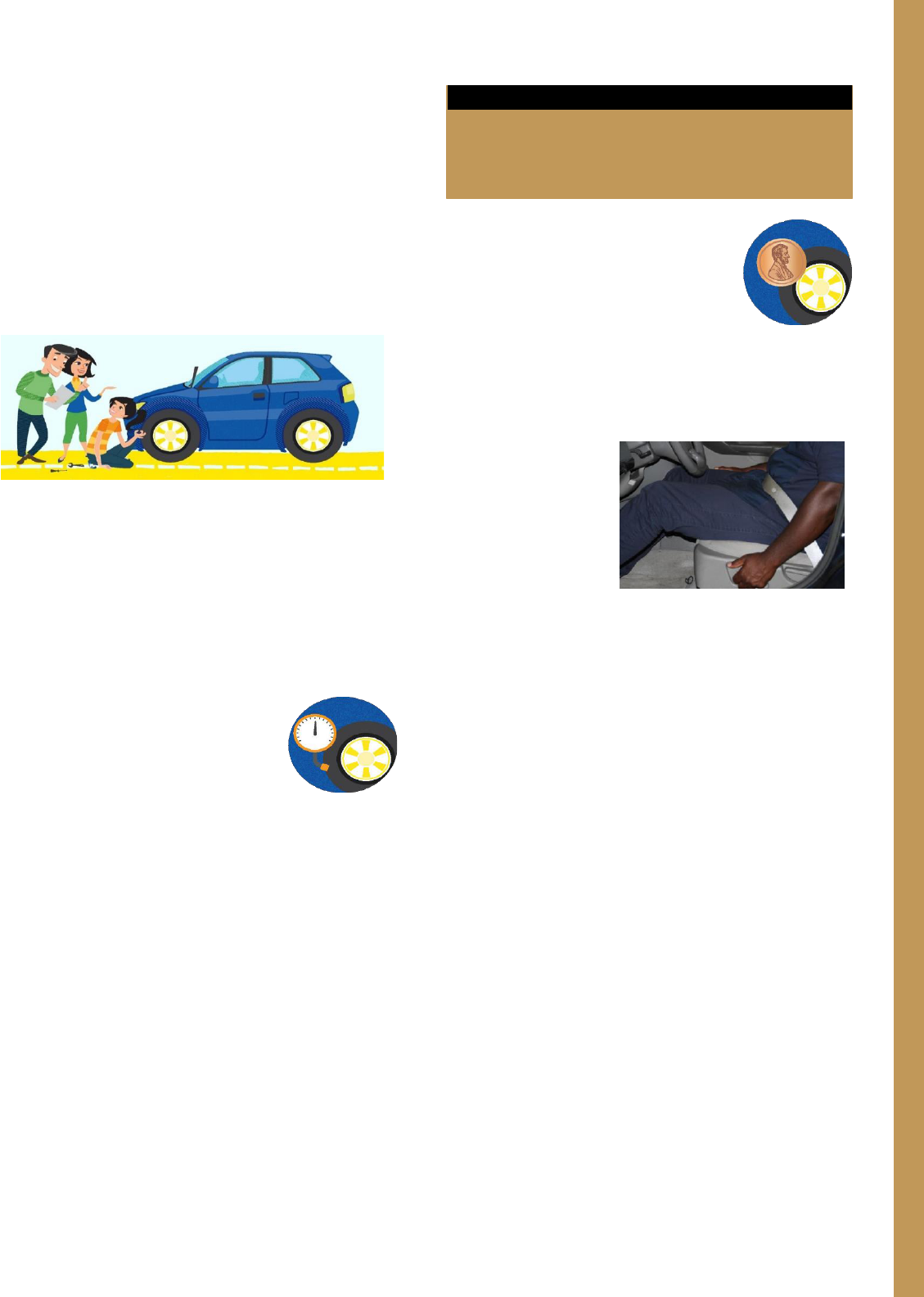
Section Four: Before You Drive 28
Section Four
Before You Drive
Inspecting Your Vehicle
When it comes to road safety, you can’t
control other drivers or road conditions, but
one thing you can control is proper
maintenance of your vehicle and tires.
Crashes due to tire maintenance are
preventable, and simple steps can save
lives. Driving on underinflated or overinflated
tires or tires with low tread can lead to safety
issues on the road.
Check Tire Pressure with a Pressure
Gauge Monthly
Buy a tire pressure gauge if
you don’t have one already.
Open your car door; on the
inside jamb, you should see
a sticker. Write down or take a picture of
the number that says “PSI” (the
measurement for tire pressure).
Remove the cap from the valve stem and
use the pressure gauge to check the tire
pressure (make sure you check when
they are cold).
Compare the number on the gauge with
the number you wrote down. If the
number is too high, let air out of your
tires. If the number is too low, inflate your
tires until the numbers match.
Check Tread Depth with a Penny
Hold a penny with Abraham Lincoln’s
body between your thumb and forefinger.
Place Lincoln’s head first into
the deepest- looking groove.
Can you see all of his head?
If yes, your tires are too
worn—don’t drive on them, and
make sure to get them replaced.
Adjusting Seat and Mirrors
You should be
seated upright
with your back
against the seat
and feet on the
floor. Improper
seating positions,
such as slouching, can result in reduced
effectiveness of the vehicle’s restraint
system. Adjust your seat and mirrors before
you start to drive so you can see clearly and
have full control of the vehicle’s foot pedals
and steering wheel with appropriate space
for airbag deployment.
Your foot should be able to pivot
smoothly from brake to accelerator while
your heel is kept on the floor.
The top of the steering wheel should be
no higher than the top of your shoulders
and below chin level.
There should be 10 inches between your
chest and the steering wheel. Do not
move the seat so far forward that you
cannot easily steer and do not recline the
seat.
Head restraints are designed to prevent
whiplash. Head restrains should be
adjusted so the head restraint contacts
the back of your head and not below the
level of your ears.
This
Section
Covers
•
Inspecting Your Vehicle
•
Adjusting Seat and Mirrors
•
Using Safety Belts
•
Air Bags
•
Child Passenger Safety Laws
•
Secure Your Load
•
ADAS Safety Features

29 Section Four: Before You Drive
Adjusting Your Mirrors
The inside mirror is the primary mirror for
view to the rear. Adjust your rearview mirror
so that it frames the rear window. You
should be able to see traffic flow to the rear
of the vehicle with the rearview mirror. A
day/night mirror should be set for the time of
day you are driving.
Adjust outside mirrors to reduce blind spots
and to provide maximum visibility to the side
and rear on both sides of the vehicle. You
are encouraged to use the following method
for adjusting your outside mirrors:
To set the left side mirror, the driver must
rest his or her head against the closed
window and set the mirror to barely show
the rear edge of the vehicle.
To set the right side mirror, the driver
should lean to the right so his or her head
is directly below the rearview mirror or
above the center console. The mirror
should be adjusted the same way as the
left side, so that the edge of the right side
of your vehicle can barely be seen.
The driver will not see the left and right
sides of the vehicle when glancing in the
outside mirrors; however, this adjustment
adds 12 to 16 degrees of additional
viewing area to each side of the vehicle.
Having Clean Windows and Mirrors
It is important that you be able to see clearly
through the windows, windshield, and
mirrors.
Keep the windshield clean because
bright sun or headlights on a dirty
windshield decreases vision.
Keep your windshield washer fluid
container full. During winter, this will also
help to prevent freezing.
Smoking while driving causes a film to
build up on the glass inside your vehicle.
Clean the inside of your windows
frequently, especially if you smoke.
Remove snow, ice, and frost from all
windows before you start to drive.
Do not hang anything from your rearview
mirror. Do not clutter up the windshield or
rear window with decals. They are
unlawful and block your vision.
Excessive window tinting is not allowed.
Using Safety Belts
Kentucky law states a
person shall not operate a
motor vehicle manufactured
after 1981 on the public
roadways of this state
unless the driver and all
passengers are wearing a properly adjusted
and fastened seat belt, unless the passenger
is a child who is secured in a child restraint
system of type meeting federal motor vehicle
safety standards.
Always fasten your safety belt and make
sure all your passengers are using safety
belts or child restraints. Studies have shown
that if you are in a crash while using safety
belts, your chances of injury or death are
greatly reduced. Safety belts keep you from
being thrown from the vehicle during a crash
or roll over and help you keep control. Your

Section Four: Before You Drive 30
chances of surviving a crash are five times
greater if you stay inside the protection of
your vehicle. Safety belts will hold you in the
seated position during sudden stops and
turns while preventing you from impacting
the steering wheel or dashboard during a
collision. Your body moves toward the
steering wheel or dashboard during a frontal
collision. If you are not belted in properly and
you are traveling at 55 miles per hour when
a collision occurs, your body will impact the
steering wheel at the same speed. The
odds of you surviving this type of crash
without a proper safety belt is small.
In Kentucky, it is illegal to drive or to be a
passenger without wearing safety belts.
Seat Belt Law is primary in Kentucky and
drivers can be stopped by law enforcement
officers if observed driving while not wearing
seat belts.
It is important to wear the safety belt
correctly.
A shoulder harness is worn across the
shoulder and chest with minimal, if any,
slack. The shoulder harness should not
be worn under the arm or behind the
back. Wearing the shoulder harness the
wrong way could cause serious internal
injuries in a crash.
The lap belt should be adjusted so that it
is snug and lies low across your hips
after fastening. Otherwise, in a crash,
you could slide out of the belt, resulting in
injury or death.
Safety belts should be worn even if the
vehicle is equipped with air bags.
Air Bags
Air bags are supplemental restraints typically
designed to deploy in moderate to severe
crashes, and they may even deploy in a
minor crash. Air bags are designed to inflate
if the sensors detect a severe crash and are
designed to work best in combination with
safety belts. Safety belts help to properly
position your body to maximize the air bag’s
benefits and help restrain you during the
initial and any after crashes. In a crash, air
bags and safety belts reduce the chance that
your head and upper body will strike some
part of the vehicle’s interior. It is extremely
important that safety belts are always worn,
even in air bag-equipped vehicles.
The entire air bag deployment process takes
about 1/20
th
of a second – faster than the
blink of an eye. The speed of deployment for
side-impact air bags is even faster. In the
event your airbag deploys, it is common for a
powder-like substance to fill the vehicle
compartment. This substance is only a
drying agent for the airbag but could be
mistaken for smoke. Here are some things to
remember to avoid serious injury related to
air bag deployment:
Move the seat back. The driver’s seat
should be as far back from the steering
wheel as possible while still being able to
operate the vehicle safely.
The passenger seat should be set as far
back as possible from the dashboard.
Passengers should also avoid placing
arms, legs, or any personal items on the
dashboard.
Drivers should place their hands on the
outside of the steering wheel – never
across the steering wheel where the
airbag deploys.
Children 12 years of age and under
should ride in the back seat in a safety
belt or child restraint system.

31 Section Four: Before You Drive
Never place a rear-facing child safety
seat in front of an active passenger air
bag. Turn off the airbag if your vehicle is
equipped with the factory installed
disabling switch.
Read your vehicle owner’s manual for
specific information about the air bags in
your vehicle.
Child Passenger Safety Laws
If using a child safety seat, make sure it is
installed properly in your vehicle and used
correctly. Check to be sure that all children
age 12 and younger are properly restrained
in the back seat and that a rear - facing child
safety seat is never placed in front of an
active passenger air bag.
Kentucky law requires that any driver of a
motor vehicle, when transporting a child of
forty (40) inches in height or less in a motor
vehicle operated on the roadways, streets,
and highways of this state, shall have the
child properly secured in a child restraint
system of a type meeting federal motor
vehicle safety standards. Any person who
violates the provisions of Kentucky’s Child
Restraint Law shall be fined fifty dollars
($50) and shall pay an additional fee of ten
dollars ($10) which shall be deposited in the
Traumatic Brain Injury Trust Fund.
Any driver of a motor vehicle, when
transporting a child under the age of eight
(8) years who is between forty (40) inches
and fifty-seven (57) inches in height in a
motor vehicle operated on the roadways,
streets, and highways of this state, shall
have the child properly secured in a child
booster seat. A child of any age who is
greater than fifty-seven (57) inches in height
shall not be required to be secured in a child
booster seat.
The Safety Seat will not provide the
maximum protection if not properly installed.
The Safety Seat should ideally be placed in
the middle of the rear seat and anchored to
prevent any movement in the event of a
collision. Assistance with the installation of
your Child Safety Seat may be found at a
Child Safety Seat Inspection Site at your
local Kentucky State Police Post.
A "child restraint system" means any device
manufactured to transport children in a
motor vehicle which conforms to all
applicable federal motor vehicle safety
standards.
A "child booster seat" means a child
passenger restraint system that meets the
standards set forth in 49 C.F.R. Part 571 that
is designed to elevate a child to properly sit
in a federally approved lap-and-shoulder belt
system.
Unattended Children
Each year children are injured or tragically
die as a result of being left unattended in a
vehicle. When you leave a child in the
vehicle alone, you risk the child moving the
vehicle and causing a collision. When you
leave a small child in the vehicle for an
extended time during hot weather, you risk
the life of that child.
In Kentucky, it is illegal to leave a child under
the age of eight (8) years in a motor vehicle
under circumstances which manifest an
extreme indifference to human life, and
which create a grave risk of death to the
child, thereby causing the death. There are
several laws in Kentucky that makes it illegal
to endanger the life or health of a child.
Secure Your Load
Driving with an unsecured load is both
against the law and extremely dangerous.
Drivers who fail to properly secure their load
may face a costly fine and jail time if they
cause a crash. A load must be securely
fastened and is only considered secure
when nothing can slide, shift, fall, or sift onto
the roadway or become airborne.

Section Four: Before You Drive 32
To secure your load in your vehicle or trailer:
Tie it down with rope, netting, or straps.
Tie large objects directly to your vehicle
or trailer.
Consider covering the entire load with a
sturdy tarp or netting.
Do not overload your vehicle or trailer.
Always double check your load to make
sure it is secure.
Do not forget that animals should also be
properly secured.
Before you drive, ask yourself these
questions:
Is there any chance of debris or cargo
falling or blowing out of my vehicle?
Is my load secured at the back, sides,
and top?
What would happen to my load if I had to
brake suddenly, I hit a bump, or another
vehicle hit me?
Would I feel safe if I were driving behind
my vehicle?
Advanced Driver Assistance Systems
(ADAS) Safety Features
Many newer vehicles on the road today have
driver assistance safety features designed to
save lives and prevent injuries, if used
properly. Some of the driver assist safety
features sense and monitor conditions;
identify present and potential dangers; and
may help you avoid a potential crash. These
safety features may provide alerts, such as
sounds or vibration or may take control of
the vehicle, such as adjusting the braking or
steering. Safety features include, but are not
limited to blind spot warning, back up
camera, forward collision warning, automatic
emergency braking, lane keeping
assistance, and active parking assist.
When taking your
driving test, you will
not be allowed to
use certain safety
features, such as
parking assist and
cruise control.
Safety features are
meant to assist you
with driving tasks,
not to drive the vehicle. Remain engaged
and always focused on the driving task. It is
your responsibility to be aware of everything
around you by performing head checks and
using mirrors and cameras to observe traffic
and other roadway users. You are
responsible for the safe operation of your
vehicle at all times. Do not rely on safety
features alone. Follow these important tips
when driving vehicles with safety features:
It is your responsibility to always stay
focused when driving.
Read your Vehicle Owner’s Manual to
learn how your vehicle’s safety features
operate.
Know the limitations of your vehicle’s
safety features.
Be aware that safety features may not
work properly in certain conditions such
as rain, snow, ice, fog, hills, and curves.
Always keep vehicle sensors clean and
damage free.
Always keep software technology up to
date and follow your vehicle
manufacturer’s recommendations.
ADAS safety features provide many benefits
and have great potential to assist drivers in
reducing crashes, injuries, and fatalities
when used properly. Click the links below for
additional information:
https://mycardoeswhat.org/
Traffic Safety Education Foundation
https://www.nhtsa.gov/
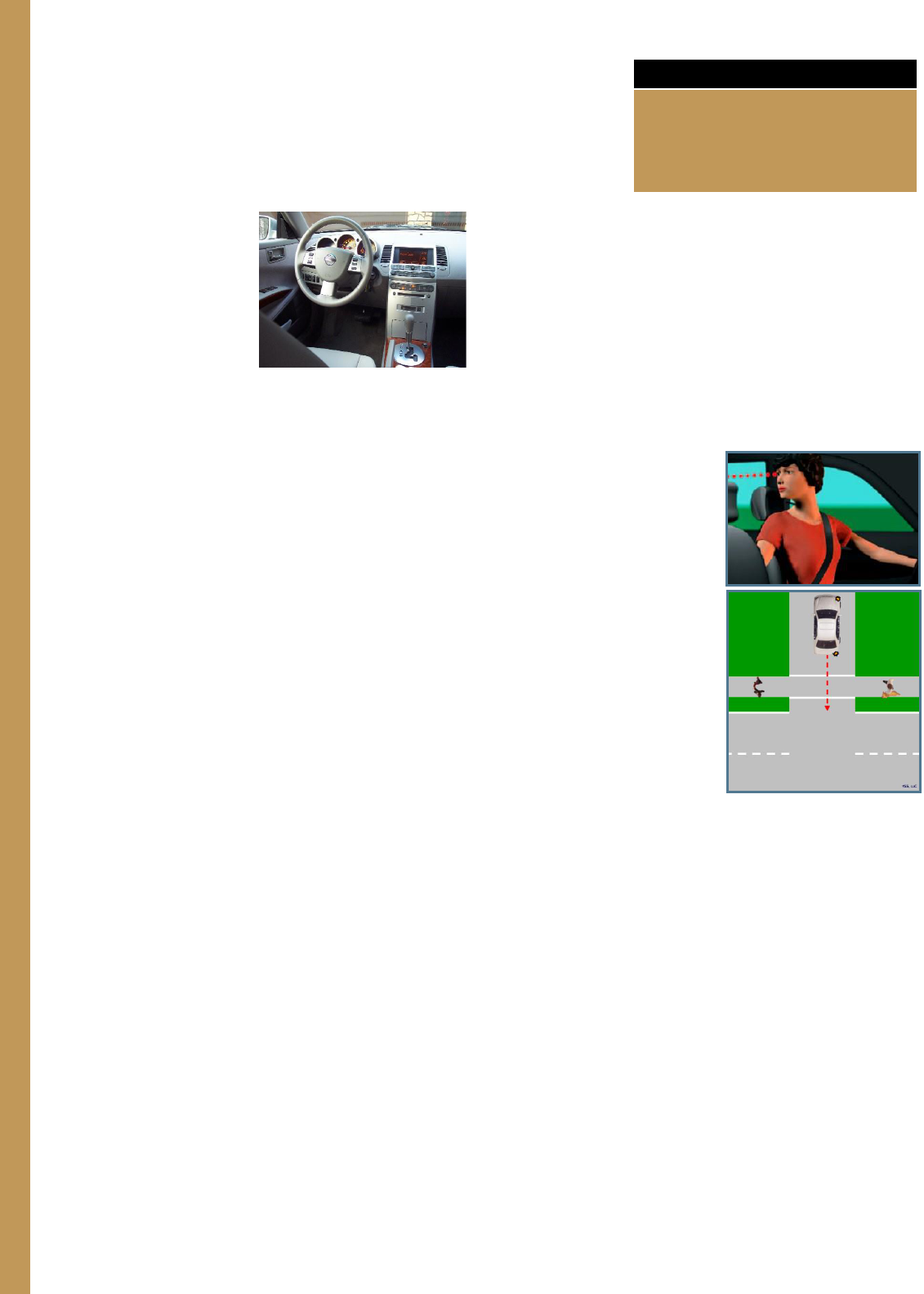
33 Section Five: Basic Driving
Section Five
Basic Driving
Starting the Engine
Check the vehicle
owner’s manual for
how to start the
vehicle. To start
the engine, place
your right foot on
the brake pedal
and check the gear
selector lever for park. Place the key in the
ignition and turn the ignition switch to the on
position. Check indicator lights and gauges
(fuel level, ABS, air bags, and so on).
Moving the Vehicle
Move gear selector lever to “D” (drive) while
keeping your foot on the brake pedal. Check
forward for a safe path and check for traffic
to the sides and behind. Signal and if safe;
move your foot to the accelerator and press
gently. Accelerate gradually and smoothly
with the top of your foot on the pedal and the
heel of your foot on the floor.
Stopping the Vehicle
Check your mirrors for traffic to the rear of
your vehicle. Move your foot from the
accelerator to the brake pedal. Press with
steady pressure until your vehicle comes to
a stop.
Steering
The steering wheel is always turned in the
direction you want the vehicle to move,
whether moving forward or in reverse.
Hand Position
Placing your hands at the 2 and 10 o’clock
positions is no longer recommended
because it can be dangerous in a vehicle
equipped with air bags. Instead, both hands
should be placed on the outside of the
steering wheel on opposite sides, at the 3
and 9 o’clock positions, to maintain control of
the vehicle. Your grip on the steering wheel
should be firm but gentle. Use your fingers
instead of the palms of your hands and keep
your thumbs up along the face of the
steering wheel. Never turn the wheel while
gripping it from the inside of the steering
wheel.
Backing Up
To safely back up
your vehicle, you
should:
Check behind
your vehicle
before you get
in. Children and
small objects
cannot be seen
from the driver’s
seat.
Place your foot
on the brake and shift to reverse. Grasp
the steering wheel at the 12 o’clock
position with your left hand. Place your
right arm on the back of the seat and look
directly through the rear window. Use
your mirrors for backing up but keep in
mind that these mirrors do not show the
area immediately behind your vehicle.
Accelerate gently and smoothly, keeping
your speed slow. Your vehicle is much
harder to steer while you are backing up.
Steer slightly in the direction the rear of
the vehicle should move. If backing up
while turning, make quick checks to the
front and sides. Continue looking to the
rear until coming to a complete stop.
This
Section
Covers
•
Starting the Engine
•
Moving the Vehicle
•
Stopping the Vehicle
•
Steering
•
Backing Up

Section Six: Rules of the Road 34
Section Six
Rules of the Road
Yielding Right of Way
Yielding right-of-way rules provide drivers
with guidance for situations when other
drivers or pedestrians are present. These
rules determine which driver should yield the
right of way and the sequence for entering
and driving through an intersection or other
driving scenarios.
Although yielding right-of-way rules provide
a guide to determine who should yield the
right of way, no one should assume he or
she automatically has the right of way. The
situation and circumstances at the
intersection must always be considered.
You should yield the right of way to:
The driver who is
at or arrives
before you at the
intersection;
Drivers in the
opposing traffic
lane when you are
making a left turn.
This includes vehicles turning right;
The driver on your
right at a four-way
intersection
controlled by stop
signs if both of you
arrive at the
intersection at the
same time;
Drivers on a public highway if you are
entering the highway from a driveway or
a private road;
Drivers on a minor road must yield to
drivers on a main road.
Drivers already on a limited access or
interstate highway if you are on the
entrance or acceleration ramp; and
Pedestrians, bicyclists, and other drivers
who are still in the intersection.
Traffic Control Devices
Traffic control devices include traffic signals,
signs, pavement markings, and directions
provided by law enforcement, highway
personnel, and school crossing guards.
Upon approaching an intersection where a
police officer is directing traffic, do what the
officer instructs you to do regardless of
traffic-control devices or signs. An
intersection is any place where two roads
meet. At an intersection there may be traffic
signals, signs, or right-of-way rules to control
traffic.
Traffic Signals
Traffic signals are lights
that tell you when or
where you should stop
and go. Traffic lights are
usually at intersections
and are red, yellow, and
green from top to
bottom, when on the same signal. There are
some intersections and other locations
where there are single green, yellow, or red
lights. In some metropolitan areas, traffic
lights are horizontal, instead of vertical, and
the red light is on the left, the yellow light is
in the middle, and the green light is on the
right.
This
Section
Covers
•
Yielding Right of Way
•
Traffic Control Devices
•
Traffic Signs
•
Pavement Markings
•
Other Lane Controls

35 Section Six: Rules of the Road
GREEN Traffic Light – If the roadway
is clear, after yielding the right of way
to other vehicles and pedestrians
lawfully within the intersection, you
may go straight or turn left or turn
right, unless such turns are prohibited.
Left turns on a green light must yield
to through traffic coming from the
opposite direction.
YELLOW Traffic Light – A yellow light
means the traffic signal is about to
turn red. Stop if you can do so safely.
A vehicle may clear an intersection
on a red light, if the vehicle entered
the intersection while the signal was
yellow; but it is against the law to
enter an intersection after the light
turns red.
RED Traffic Light – A red light means
“stop” behind a crosswalk or stop line
until the green light appears. You may
turn right after stopping if there is no
approaching traffic unless a sign is
posted prohibiting such right turns.
Even though the light is red, a turn is
permitted from a one-way street into
the nearest lane of another one-way
street running in the direction of that
turn.
Right turns on red – If not prohibited by
signs, and you are in the proper lane, you
must first stop, and then turn right when
the roadway is clear of vehicle or
pedestrian traffic.
Left turns on red – Left turns on red are
permitted only when turning from a one-
way street onto a one-way street. You
must first stop then turn left when the
roadway is clear of vehicle or pedestrian
traffic.
Flashing Lights
A flashing yellow light means you must slow
down and watch for others. It is found at
intersections, construction areas, and on
some vehicles, like tow trucks.
A flashing red light means you must come to
a full stop and proceed only when it is clear.
Two flashing red lights mark a railroad
crossing. Stop and proceed only after the
red lights stop flashing and you determine no
train is approaching. The familiar cross-buck
sign near the tracts is a regulatory sign that
means the same as a yield sign.
Lighted Arrows
Some intersections have lighted arrows in
addition to the regular lights. A green arrow
means you may go in the direction of the
arrow, if you are in the proper lane.
A flashing yellow arrow means proceed with
caution in the direction of the arrow.
A green arrow pointed upward means you
may go “straight ahead”.
A red arrow means no turning in the
direction of the arrow, until it turns green.
When there is more than one traffic light,
obey the one that is over your lane.
Traffic Signs
Traffic signs tell you about traffic rules,
hazards, roadway location, roadway
directions, and the location of roadway
services. The shape, color, symbols, and
words of these signs give clues to the type of
information they provide.
Warning Signs – These signs tell a driver of
possible danger that might be ahead, and
alert the driver to slow down and be
prepared to stop if necessary. Warning
signs may also alert the driver to a hazard or
special situation on the roadway that is
ahead. These signs are usually yellow with
black lettering or symbols and are diamond
shaped. Some warning signs may be
fluorescent yellow, such as school zones,
school crossing, and pedestrian crossing.
Some common warning signs are shown
below.

Section Six: Rules of the Road 36
Railroad Crossing Warning Signs – Many
railroad crossings have signs or signals to
caution you about highway-railroad grade
crossings. Some common railroad crossing
warning signs and signals are shown below.
A round yellow warning sign
with an “X” symbol and black
“RR” letters is placed along
the road before a highway-
railroad grade crossing. The
sign cautions you to slow down, look and
listen for a train or railroad vehicle, and
be prepared to stop if a train is
approaching.
A white, X-shaped sign with
“Railroad Crossing” printed on
it is located at the highway-
railroad grade crossing. When
a train or railroad vehicle is approaching
the intersection, you must stop behind
the stop line or before the intersection
until the intersection is clear.
At highway-railroad grade
crossings with more than one
train track, the number of
tracks will be posted. These
signs warn you that there is more than
one track and there may be more than
one train crossing. Not all highway-
railroad grade crossings with more than
one train track will have these signs, so it
is important to check for more than one
track, train, or railroad vehicle at each
highway-railroad grade crossing. Not all
railroad grade crossings have lights.
When you need to cross railroad tracks, look
both ways and cross the tracks quickly,
without stopping. If a train is crossing the
highway, you must wait to cross a highway-
railroad grade crossing until the train is well
down the track or railroad devices, such as
lights and gates, indicate it is safe to cross. If
you are approaching railroad tracks and you
need to stop for traffic or a signal, stop at the
stop line before the railroad tracks.

37 Section Six: Rules of the Road
If you do get boxed in or stalled on a railroad
crossing, abandon your car immediately and
run away from the railroad track in the
direction the train is coming, in order to avoid
being hit by flying debris. Once you are at a
safe distance, call the 800 number posted on
or near the crossbuck, or call 911, to alert
the dispatcher of your stalled vehicle. Do not
attempt to restart your vehicle until a
dispatcher indicates it is safe and no trains
are approaching.
The stopping distance for an average freight
train at 55 miles per hour may be a mile or
more. Trains cannot stop quickly; cars can. If
you are stopped at a railroad crossing where
there is more than one track, do not start up
as soon as the train passes. Wait until you
have a clear view in both directions before
you start across. A second train could be
approaching from the other direction. Never
attempt to cross a railroad crossing until
there is ample space to get completely
across and off the tracks. Stopping on a
railroad crossing is very dangerous.
Expect a train when approaching any
railroad track. Crossing a railroad track after
the warning lights are flashing or the
crossing gates are down is against the law,
and you could be cited.
Work Zone Signs – These are generally
diamond or rectangular shaped and orange
with black letters or symbols. These
construction, maintenance, or emergency
operation signs alert you to work zones
ahead and warn you that people are working
on or near the roadway.
These warnings include workers ahead,
reduced speed, detours, slow-moving
construction equipment, and poor or
suddenly changing road surfaces.
In work zones, traffic may
be controlled by a person
with a sign or flag to tell
you which direction to
travel or to slow down or
stop. You must follow
their instructions.
Barriers, such as drums, cones, and tubes
(panels), are used to keep traffic out of
hazardous work zones. Along with signs and
road markings, they guide you safely
through the work zone. Barriers may be
used to keep drivers from entering closed
roads or other areas where it is dangerous to
drive. Temporary traffic signals may be used
in work zones. You may see a warning sign
showing a symbol of a traffic signal. Stop at
the white line, if present.
Cone
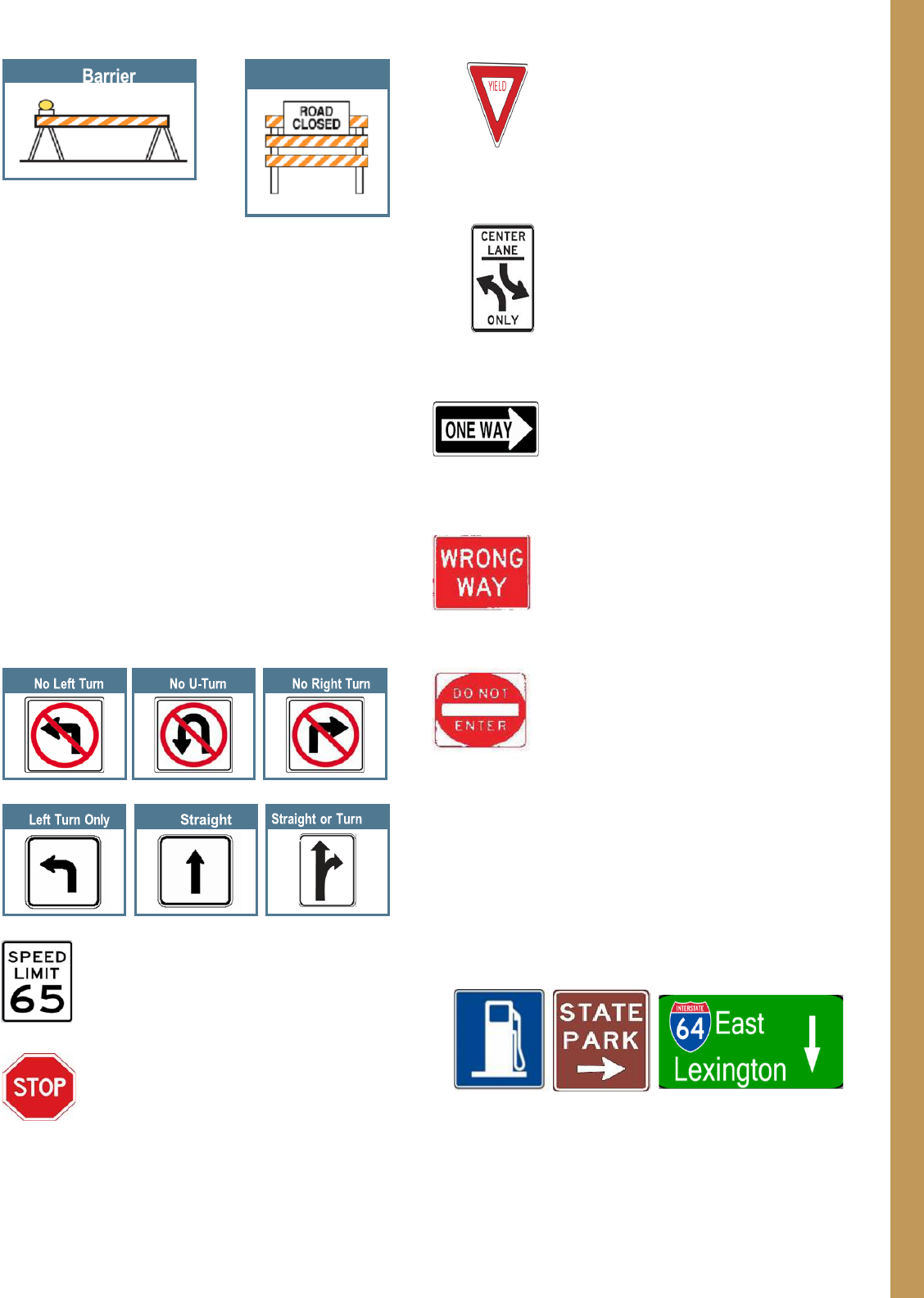
Section Six: Rules of the Road 38
Give construction workers a “brake.” Reduce
your speed in work zones and be prepared
to stop suddenly. Do not tailgate in work
zones. Fines for speeding in a work zone are
doubled.
Regulatory Signs – These signs are square
or rectangular or have a special shape and
are white with black, red, or green letters or
symbols. These signs tell you about specific
laws that you must obey, such as rules for
traffic direction, lane use, turning, speed,
parking, and other special situations. Some
regulatory signs have a red circle with a red
slash over a symbol, which prohibits certain
actions.
Common types of regulatory signs are:
Speed Limit Signs – These black
and white signs indicate the
maximum legal speed allowed in
ideal conditions.
Stop Sign – A stop sign has eight
sides and is red with white letters.
You must stop behind the stop line
or crosswalk if one is present. Yield
the right of way to crossing
vehicles and pedestrians in all
directions.
Yield Sign – A yield sign is a red
and white downward-pointing
triangle with red letters. It means
you must slow down and allow
traffic that has the right of way to
cross before entering.
Shared Center Lane Left Turn
Only – This sign tells you where a
lane is reserved for the use of left
turning vehicles from either
direction and is not to be used for
through traffic or passing other
vehicles.
One-Way Street – These signs
tell you that traffic flows only in
the direction of the arrow. Do not
turn in the opposite direction of
the arrow.
Wrong Way – This sign tells that
you are going in the wrong
direction. It is often found at exit
ramps and at the beginning of
one-way streets.
Do Not Enter – This sign tells you
that you cannot enter a street or
roadway. It is often found at exit
ramps and at the beginning of
one-way streets.
Guide Signs – These signs are square and
rectangular and are green, brown, or blue.
They give information on intersecting roads,
help direct you to cities and towns, and show
points of interest along the highway. Guide
signs can also help you find hospitals,
service stations, restaurants, and hotels.
Road Closed
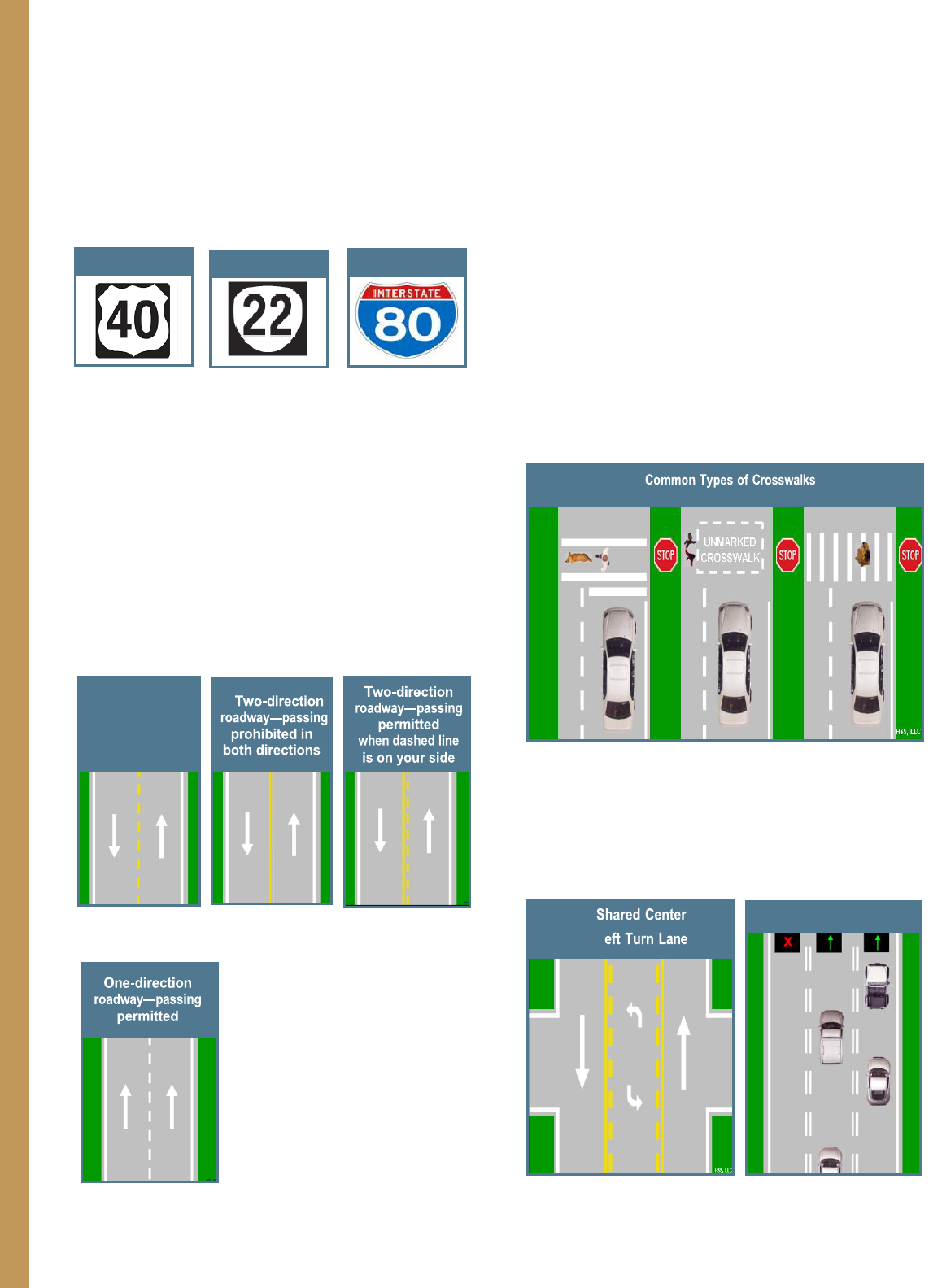
39 Section Six: Rules of the Road
Route Number Signs – The shape and
color of route number signs indicate the type
of roadway: interstate, U.S., state, city,
county, or local road. When planning a trip,
use a road map to determine the route.
During the trip, follow the route signs to
prevent you from getting lost in an unfamiliar
area.
Pavement Markings
Pavement markings are lines, arrows,
words, or symbols painted on the roadway to
give you directions or warnings. They are
used to divide lanes, tell you when you may
pass other vehicles or change lanes, tell you
which lanes to use for turns, define
pedestrian walkways, and show where you
must stop for signs or traffic signals.
Yellow Lane Markings
White Lane Markings
Crosswalks and Stop Lines
Crosswalks define the area where
pedestrians may cross the roadway. When
required to stop because of a sign or signal,
you must stop behind the stop line,
crosswalk, or stop sign or signal. You must
yield to pedestrians entering or in a
crosswalk. Not all crosswalks are marked.
Be alert for pedestrians when crossing
intersections. If crosswalks are not apparent,
then you must stop before entering the
intersection. If there is a stop line before the
crosswalk, the stop line must be obeyed first.
The following are some of the most common
types of crosswalk markings:
Other Lane Controls
Shared Center Left Turn Lane &
Reversible Lanes
State Route
US Route
Interstate
Route
L
Reversible Lanes
Two-direction
roadway—passing
permitted
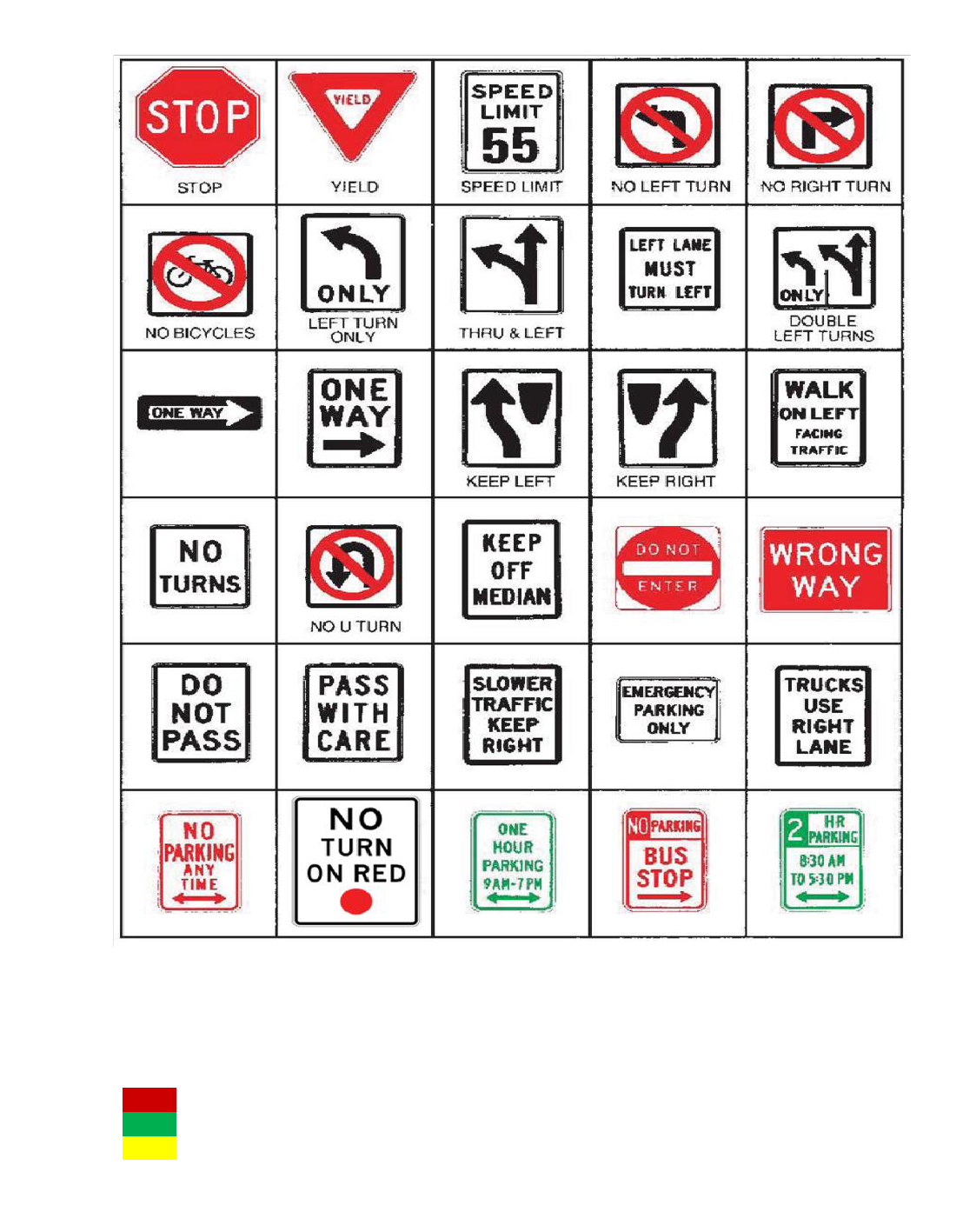
Section Six: Rules of the Road 40
STANDARD COLORS
RED
=
Stop or forbidden.
GREEN
=
Indicates movement permitted, directional guidance.
YELLOW
=
General warning.
REGULATORY SIGNS
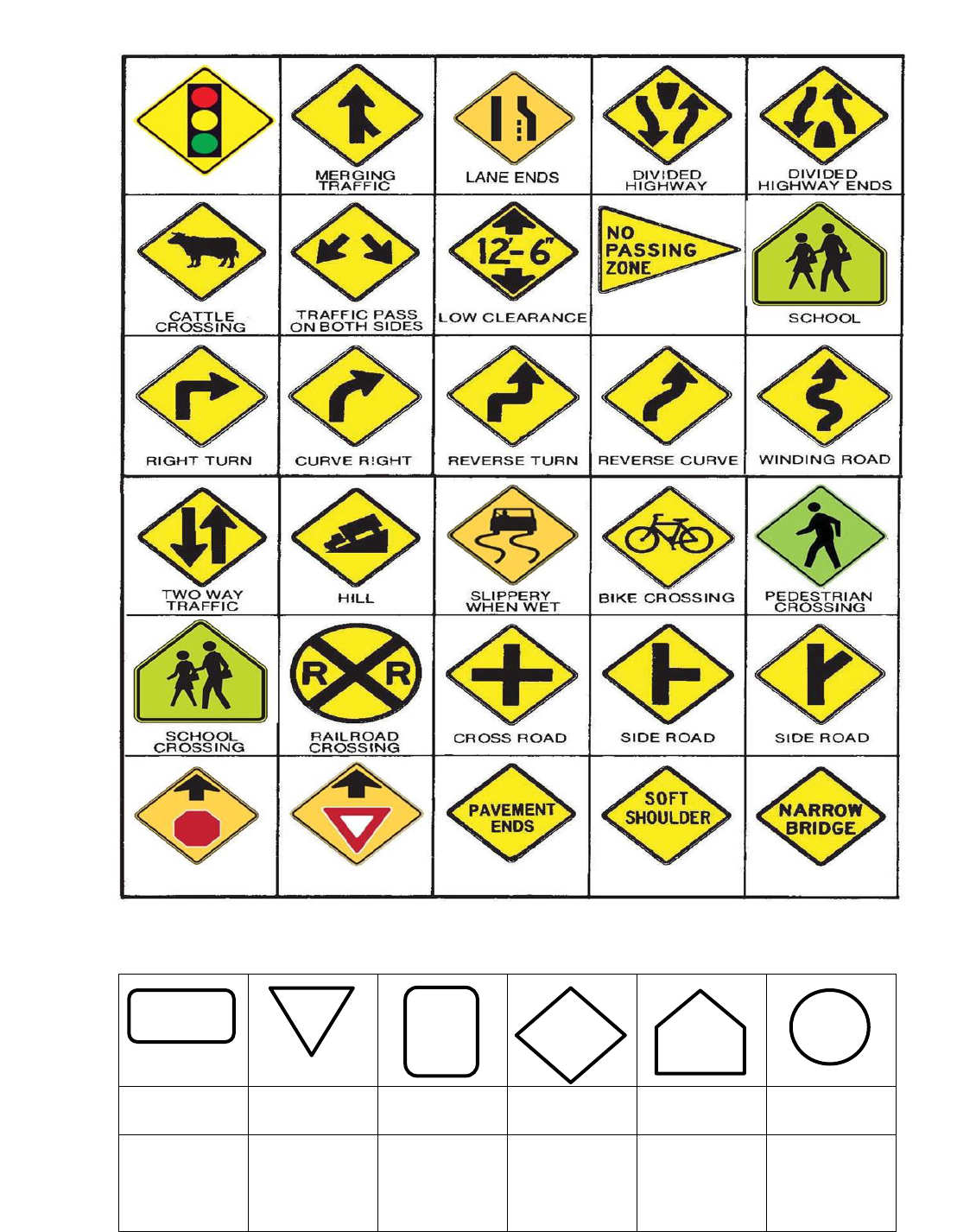
41 Section Six: Rules of the Road
STANDARD SHAPES
Horizontal
Rectangle
Equilateral
Triangle
Vertical
Rectangle
Diamond
Pentagon
Round
Generally
guide signs.
Used only
for yield
signs.
Generally
regulating
signs.
Existing or
possible
hazards on
roadway.
School
signs.
Railroad
and
advance
warning.
WARNING SIGNS
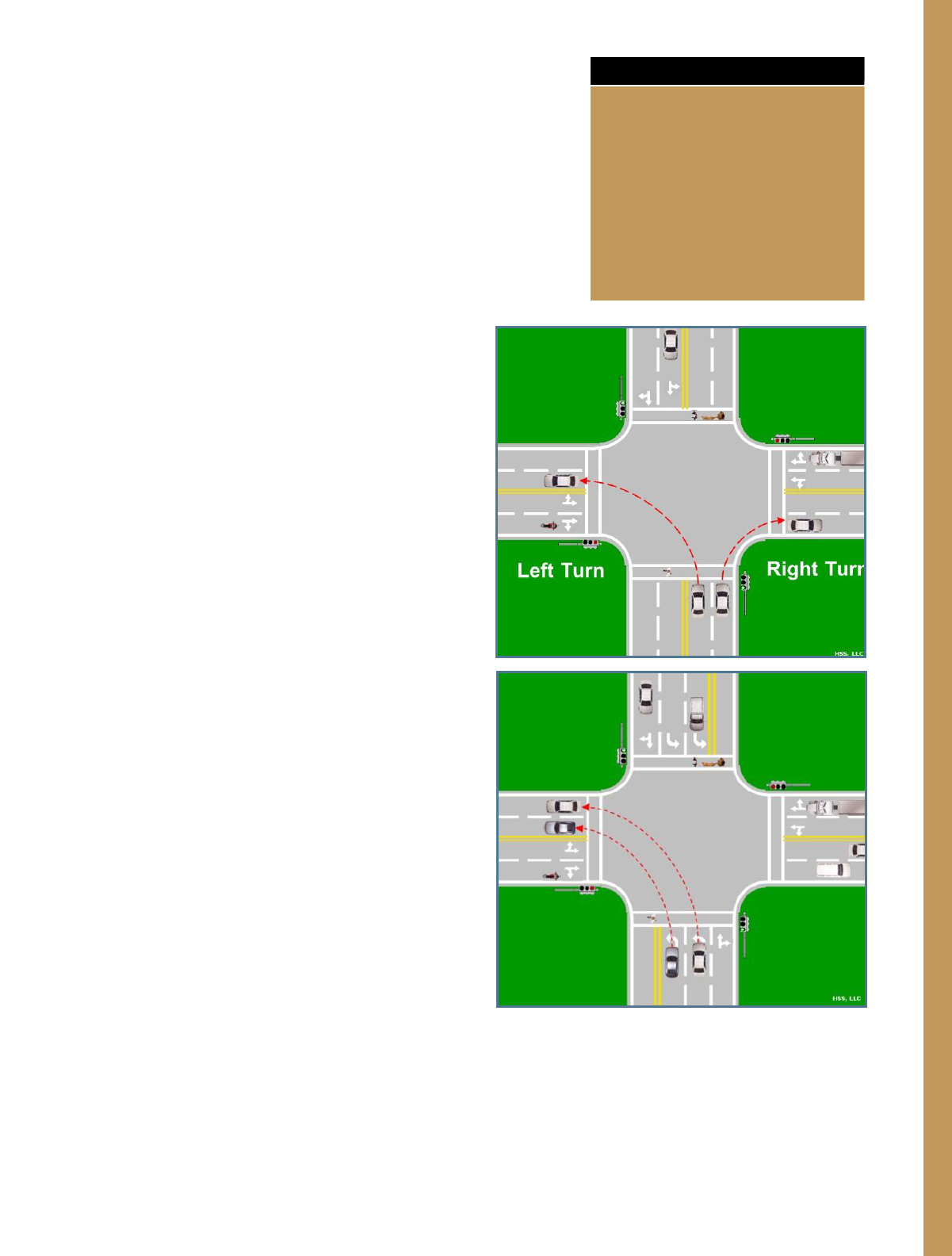
Section Seven: General Driving 42
Section Seven
General Driving
Turning and Turnabouts
When turning, you should:
Search all corners for traffic controls,
pedestrians, other vehicles, and so on
and signal your intentions.
Enter and maintain proper position in the
lane that is closest to the direction you
want to go.
Look through the turn to the farthest point
possible along the intended path.
Accelerate smoothly to an appropriate
speed, make sure your turn signal is
cancelled, and check traffic to the rear.
If you plan to turn at an intersection,
signal 100 feet before the turn.
If the driver in front of you is signaling for
a turn, do not signal unless you are also
going to turn.
Right Turns
Avoid swinging wide to the left before
making the turn.
Always turn right from the right-most
portion of your lane.
Left Turns
When making a left turn, yield to
oncoming traffic.
Always turn left from the left-most portion
of your lane.
Multiple Lanes Turning
Identify and enter the lane from which
you will turn.
Stay in that lane until the turn is
completed.
This
Section
Covers
•
Turning and Turnabouts
•
Intersections
•
Roundabouts and Traffic Circles
•
Rules for School Buses
•
Parking
•
Use of Lanes
•
Entering a Multi-lane Highway
•
Exiting a Roadway
•
Passing
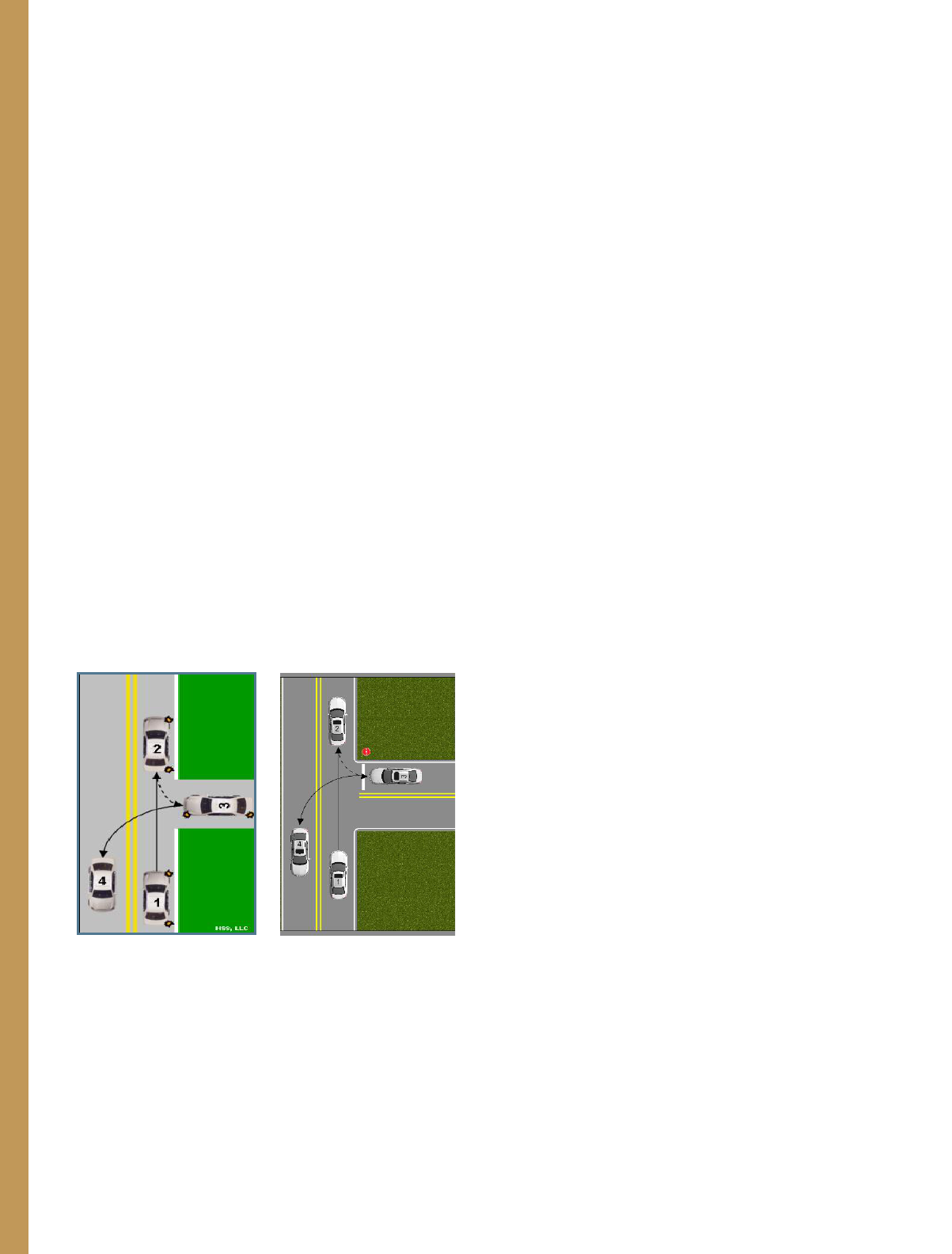
43 Section Seven: General Driving
Turnabouts
A turnabout is a type of turn in which a
street, alley, or driveway is used to legally
reverse the direction you are traveling when
it is not practical or possible to drive around
a block. When you need to turnaround and
go the other direction, a turnabout is a safe
and legal way to do it.
Make sure your car can be seen for 500 feet
in either direction. Signal your intention to
turn right; stop and check traffic to the sides
and rear of the vehicle. Move back until the
rear bumper of the vehicle reaches the near
edge of the driveway. While backing slowly,
steer rapidly all the way to the right. As the
vehicle centers in the driveway (Figure 1),
straighten the wheels and stop. If backing
onto a two-lane road, do not center the
vehicle in the roadway. Instead, position the
vehicle to the right of the center line (Figure
2), or stay on your side of the roadway if
there is no center line. Shift to drive and
check in both directions; if clear, signal and
turn left into the proper lane and accelerate
as appropriate.
Applicants should master this maneuver
in preparation for the skills test.
Intersections
At all intersections, reduce your speed and
search for:
Traffic control devices;
Oncoming and cross traffic;
Pedestrians and bicyclists;
The roadway condition;
Areas of limited visibility;
Do not rely on others to obey traffic control
signals or signs. They may not yield the right
of way. Be prepared to avoid a crash.
Before moving after stopping at an
intersection, take the extra time to check for
crossing traffic and bicyclists. Look left and
then right and left again before entering the
intersection. At a traffic signal when the light
turns green, avoid immediately moving into
the intersection. Take the time to make sure
your path of travel is clear and there is no
crossing traffic. You need a large enough
gap to get your vehicle across the roadway.
You need enough space to turn into the
appropriate lane and get up to speed.
At an intersection, look both ways, even if
other traffic has a red light or a stop sign.
Someone may disobey traffic control
devices. Make sure you have a good view. If
your view of a cross street is blocked by a
building or a row of parked vehicles, edge
forward slowly until you can clearly see. If
traffic in one lane is blocking your view of
another lane, wait until it clears. If you try to
look by placing the front of your vehicle into
the other lane you may get hit.
Never assume another driver will share
space or give your vehicle any additional
space. Do not turn into a lane just because
an approaching vehicle has a turn signal
active. The driver with an active turn signal
may plan to turn after they go past your
vehicle or may have forgotten to turn the
signal off from a prior turn.
Figure 1 Driveway
Figure 2 Two-Lane Road

Section Seven: General Driving 44
Roundabouts and Traffic Circles
A roundabout or traffic circle is a circular
intersection with design features that
promote safe and efficient traffic flow.
Vehicles travel counterclockwise around a
raised center island, with entering traffic
yielding the right of way to circulating traffic.
When using roundabouts or traffic circles:
Slow down to enter the
roundabout or traffic circle. A
sign, like the one shown,
warns of a roundabout or
traffic circle.
Yield to the traffic in the
roundabout/circle.
Enter a roundabout or traffic circle in a
counterclockwise direction.
Proceed to the appropriate exit, signal
intent, and exit.
Rules for School Buses
Where there are school buses, there are
usually children. Children are likely to do
something unexpected, so be prepared.
When you come to a school or church bus
that is stopped on any roadway to load or
unload passengers you must stop. By law
you must remain stopped until all people are
clear of the roadway and the bus is in
motion.
A stop is not required when approaching a
stopped bus from the opposite direction
upon a highway of four or more lanes.
However, a stop is required when following a
bus that is stopped on a two lane road or
you are going in the opposite direction of the
bus on a highway that has less than four
lanes, as they are generally not divided.
Do not attempt to pass any school or church
bus when the bus is stopped upon a
highway to receive or discharge passengers,
with the stop arm and signal lights are
activated. The operator of a vehicle
approaching a school or church bus from
any direction must bring the vehicle to a
complete stop, and cannot proceed until the
bus has completed receiving or discharging
passengers and the bus is in motion. This
requirement applies to all vehicles
approaching a school or church bus.
Parking
You are responsible for making sure that
your vehicle is not a hazard when it is
parked.
Always park in a designated area.
When parking along the roadway, park
your vehicle as far away from the flow of
traffic as possible. If there is a curb, park
as close to it as possible.
No-Parking Zones – There are
many areas where you cannot
park. Check for signs or
painted curbs that may prohibit
or limit parking. Some parking
restrictions are indicated by colored curb
markings.
Perpendicular and Angle Parking
Entering a Perpendicular or Angle Parking
Space:
Identify the space in which you will park
and check traffic.
Signal your intentions.
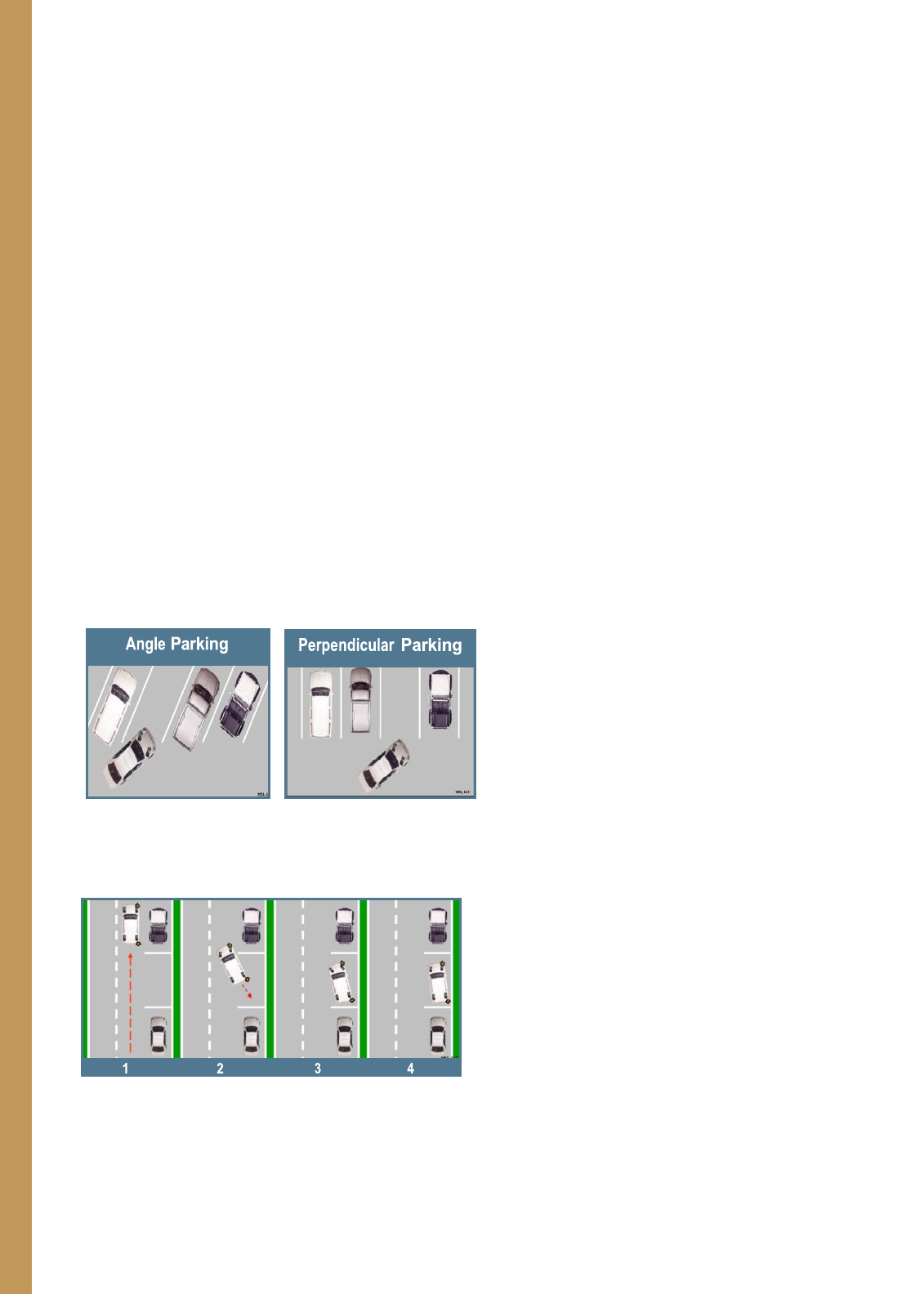
45 Section Seven: General Driving
Move forward slowly, turning the steering
wheel left or right as appropriate, until the
vehicle reaches the middle of the space.
Center the vehicle in the space.
Move to the front of the parking space,
stop, and secure the vehicle.
Exiting a Perpendicular or Angle Parking
Space:
Check for traffic in all directions.
Continue to check traffic and move
straight back until your front bumper
clears the vehicle parked beside you.
Then turn the steering wheel sharply in
the direction that the rear of your vehicle
should move.
When the vehicle clears the parking area
space, stop and shift to drive.
Accelerate smoothly, steering as needed
to straighten the wheels.
Parallel Parking
ENTERING A PARALLEL PARKING SPACE
Identify the space where you will park,
check traffic, and signal.
When traffic is clear, shift to reverse and
look to the rear in the direction the
vehicle will be moving.
Back slowly while turning the steering
wheel rapidly in the appropriate direction.
Continue backing up until your front
bumper is in line with the rear bumper of
the vehicle you are parking behind.
Back up slowly while turning the steering
wheel rapidly to center the vehicle into
the space.
Stop before touching the bumper of the
vehicle to the rear. Shift to drive and
adjust the vehicle in the parking space.
Make sure your vehicle cannot move. Set
your parking brake and shift to “park” (or
reverse in a manual shift car).
It is safest to get out of your vehicle on
the curb side. If you must use the street
side, check traffic before getting out.
The law requires you to turn off the
engine and remove the key when you
leave a vehicle. Always lock your vehicle
when leaving it, even if you are only
going to be away for a short period of
time.
EXITING A PARALLEL PARKING SPACE
Check traffic in all directions, place your
foot on the brake, shift to reverse, and
back as much as possible to the vehicle
parked behind you.
Check for traffic and signal. Shift to drive
and move forward slowly, steering into
the lane.
Make sure that the front bumper of the
vehicle will clear the vehicle ahead; if not,
reverse and correct steering.
Move forward into the appropriate lane of
traffic when the door post of the vehicle
clears the rear bumper of the vehicle
parked ahead of you.
Applicants should master this maneuver
in preparation for the skills test.

Section Seven: General Driving 46
Parking on a Hill
If you are parked on a hill, turn your wheels
so that your vehicle will touch the curb if the
vehicle begins moving. If there is no curb,
turn the wheels so the vehicle will go off the
road should it roll.
Turn off the engine and remove the key
when you leave a vehicle. Always lock your
vehicle when leaving it, even if you are only
going to be away for a short period of time.
Handicapped Parking
Unauthorized parking in designated
handicapped parking areas is unlawful and
is punishable by a fine. Persons requiring or
needing handicapped parking privileges
should apply to the County Clerk’s Office for
special decals or plates. Handicapped
Parking is only for vehicles displaying an
official permit and transporting a disabled
person.
Use of Lanes
Smooth driving allows you to keep more
distance between yourself and other drivers
and helps improve fuel economy. If there are
three or more lanes in one direction, the
middle lane or lanes are for through traffic.
The left lane is for drivers who want to pass
or turn left. The right lane is used by drivers
who want to go slower or who are entering
or turning right. If a road has only two lanes
in one direction, the right lane generally has
the smoothest traffic flow, with the left lane
being reserved for the passing of other
vehicles. Remaining in the left lane on a
limited access highway is illegal.
Lanes for Turning
While turning into another street, turn into
the lane nearest to you. If you are turning left
from a street with two or more lanes, turn
from the lane nearest the center lane. If you
are turning right, turn from the lane nearest
the curb. If you need to change to another
lane, do so only after you have finished your
turn and when the traffic is clear.
If you miss your turn, go on to the next
intersection and work your way back to
where you want to go.
If you have already started through an
intersection when the light changes, keep
going. If you have started to make a turn,
follow through. Last-second changes can
cause collisions.
Changing Lanes
When changing lanes:
Check your mirrors.
Check your “blind spots,” or areas around
your vehicle that cannot be seen by other
vehicles, by turning your head and
looking over your shoulder in the
direction you plan to move.

47 Section Seven: General Driving
Identify a gap in traffic, signal, and look
again in the direction of the lane change.
Adjust speed and steer into lane.
Entering a Multi-lane Highway
Use the acceleration lane to reach the speed
of other vehicles before pulling onto the
roadway. Identify a gap in traffic and merge
with the traffic flow. Cancel your turn signal.
The existing traffic has the right of way, so
make sure it is clear before you merge.
Exiting a Roadway
It is important to know where you are exiting
the roadway.
Get in the lane closest to your exiting
point early to avoid a quick lane change.
Maintain your vehicle speed as long as
you are on the main roadway.
Signal your intention, move to the
deceleration lane, and slow to your
existing speed.
Check the posted speed for the
deceleration lane.
Passing
In general, you should pass on the left. On
multi-lane roads, the left-most lane is
intended to be used for passing slower
vehicles. Passing on the right can be
dangerous since other drivers do not expect
it. Vehicles on the right side are also more
difficult to see. The operator of a vehicle may
overtake and pass another vehicle upon the
right only when it is safe to do so.
Such movement shall not be made by
driving off the roadway unless the vehicle
being passed comes to a complete stop and
such movement may be made safely.
Many roads have lane markings that tell you
when passing is legal or illegal. You may not
pass when there is a solid line on your side
of the broken line of the road. You may pass
if there is a solid yellow line on the left side
of the broken yellow line.
Pass only if there are no
oncoming vehicles. Signs are
also used to tell you when
passing is legal or illegal.
Kentucky law requires that a pass be
completed before reaching the beginning of
a “no passing zone”, and that a pass be
completed before coming within two hundred
(200) feet of an oncoming vehicle. If you are
still in the left lane when you reach the “no
passing zone”, you are violating the law.
When passing another vehicle, pass the
vehicle as quickly and safely as possible.
The longer your vehicle stays alongside the
other vehicle, the longer you are in danger of
the other vehicle moving toward your lane.
To pass:
Check for oncoming traffic.
Check your mirrors and over your
shoulder for following or passing
vehicles.
Signal your intentions when it is safe to
pass.
Steer smoothly into the passing lane,
Maintain or adjust speed as necessary.
Continue to pass until the complete front
of the passed vehicle is visible in your
rearview mirror.
Signal your intention to return to the lane.
No Passing Anytime

Section Seven: General Driving 48
Steer smoothly into the lane, maintaining
or adjusting speed as appropriate.
Consider whether or not you have
enough space to pass whenever you
approach a hill or curve, an intersection,
or any roadway obstruction.
Any time your view is blocked by a
curve or a hill, you should assume there
is an oncoming vehicle just out of sight.
Treat a curve or a hill as an oncoming
vehicle. Do not start to pass when
approaching a hill or a curve.
It is dangerous to pass where someone
may enter or cross the road. Such
places include crossroads and
congested areas, business and
shopping areas, school zones, parks,
playgrounds, and pedestrian crossings.
While you are passing, your view of
people and traffic may be blocked by
the vehicle you are passing. Also, other
drivers turning onto the roadway into the
left lane may not expect to find you in
the left lane.
Before you pass, look ahead for road or
other conditions that may cause other
traffic to move into your lane. Make sure
someone is not going to pull in front of
you from a private drive or intersection.
Never pull out to pass unless you know
you have enough space to return to
your lane. Do not depend on having
enough time to pass several vehicles at
once or rely on
other drivers to
make room for
you.
Before you
return to the
driving lane, be
sure to leave enough room between you
and the vehicle you have passed. One
way to do this is to look for the vehicle
in the outside rearview mirror. When
you see the vehicle, you have enough
room to return to the driving lane.
Overtaking a bicycle or electric low-speed
scooter proceeding in the same direction:
If there is more than one (1) lane for
traffic traveling in the same direction,
move the vehicle to the immediate left, if
the lane is available and moving in the
lane is reasonably safe; or
If there is only one (1) lane for traffic
traveling in the same direction, pass to
the left keeping at least three (3) feet
between your vehicle and the bicycle or
electric low-speed scooter. Maintain that
distance until safely past the bicycle or
electric low-speed scooter.
Use reasonable caution in passing if
space on the roadway is not available to
have a minimum distance of three (3)
feet between your vehicle and the bicycle
or electric low-speed scooter.
You may drive to the left of the center
line, including when there is a no-passing
zone, to pass a person operating a
bicycle or electric low-speed scooter only
if the roadway to the left of the center is
clear for a sufficient distance to permit
passing the person safely and avoid
interference with oncoming traffic.
When being passed:
Stay in your lane.
Kentucky law requires the operator of a
vehicle about to be overtaken and
passed shall give way to the right in favor
of the overtaking vehicle.
Road users are required to work together
in order to obtain clearance and avoid
accidents in passing situations.

49 Section Eight: Safe Driving Tips
Section Eight
Safe Driving Tips
Driving requires skills you can only gain
through practice and experience. The
following section offers some driving tips that
you can practice helping you become a safer
and more skillful driver.
Visual Search
You must know what is happening around
your vehicle. You must look ahead, to the
sides, and behind the vehicle. You should
develop a searching pattern that you can
use every time you are driving.
Searching helps you to see situations that
could cause a problem and gives you time to
change speed or roadway position. Avoid
staring. Keep your eyes moving and
searching for possible problems.
Look ahead.
Looking well down
your planned path of
travel will help you
see the road, other
road users, and traffic
conditions and gives
you time to adjust and plan your driving
movements. This additional time will allow
you to make better decisions and possibly
avoid being forced to use emergency
braking and steering. Ideally, you should try
to look at what is occurring 20 to 30 seconds
in front of your car.
How far you look down the road depends on
where you are driving. In cities and urban
areas, you may not be able to see as far as
when you are driving on a highway. Avoid
getting into situations that could limit how far
you can see such as following too close to a
larger vehicle. Adjust your speed and road
position so you can see.
Look to the sides. You should search to the
sides to make sure other roadway users will
not cross your travel path.
Look to the rear. You need to be aware of
traffic behind your vehicle. Use your mirrors
to check this traffic. It is very important to
check traffic behind you when changing
lanes, slowing down or stopping, and
entering an intersection.
Speed Management
Driving safely means adjusting your vehicle
speed for roadway and traffic conditions,
providing an adequate following interval, and
obeying the appropriate speed limits. Make it
a habit to glance at the speedometer about
once a minute to ensure you are driving at a
safe and legal speed.
Kentucky Speed Limits
When the speed limit is not posted, these
are the speed limits on Kentucky roads.
65 MPH – Sixty-five miles per hour is the
speed limit on interstate highways and
parkways.
55 MPH – Fifty-five miles per hour is the
speed limit on all other state highways.
35 MPH – Thirty-five miles per hour is the
speed limit in a business/residential district.
15 MPH – The speed limit in an off-street
parking facility offered for public use,
whether publicly or privately owned, shall be
fifteen miles per hour.
70 MPH – The secretary of transportation
may increase the speed limit of specific
highways to seventy miles per hour.
This
Section
Covers
•
Visual
Search
•
Speed Management
•
Stopping Distance
•
Space Management
•
Backing
•
Communicating

Section Eight: Safe Driving Tips 50
Visibility
Speed must be adjusted according to how
well you can see the roadway. A few things
that may inhibit you from seeing well are:
Darkness – You must be closer to an
object to see it at night than during the
day. Never drive so fast that you cannot
stop within the distance you can see with
your headlights,
Rain, fog, or snow – In a heavy rain,
snowstorm, or a thick fog, you may not
be able to see more than 100 feet ahead.
When you cannot see any farther than
that, you cannot safely drive faster than
25 miles per hour. You should also use
low beam headlights.
Intersections – Trees, bushes, parked
cars, signs, and buildings at intersections
can block you view of vehicles coming
from the side. Approach these areas with
caution and slowly enough to be able to
stop if a vehicle pulls out suddenly.
Hills and curves – When you come to a
hill or curve, adjust your speed so you
can stop if a stalled car or slow-moving
vehicle is in your lane.
Adjusting To Roadway Conditions
Curves - Always
reduce speed before
entering the curve to
a safe speed (a
speed that allows you
to apply slight and
constant acceleration
through the curve).
Reduce speed more when traction is poor,
when following other vehicles, and when you
cannot see the end of the curve. Hard
braking after entry to a curve could cause
the vehicle tires to lose traction.
Slippery roads – Reduce speed at the first
sign of rain, snow, sleet, or ice. When the
roadway is slippery, your tires do not grip as
well. It will take longer to stop, and it will be
harder to turn without skidding.
If you are driving at an excessive speed or
going downhill, slippery conditions can
cause the vehicle to skid or to hydroplane.
Do not try to stop rapidly or turn quickly until
your speed has slowed and your tires have
regained traction with the roadway. Pump
your brakes gently, unless your vehicle is
equipped with anti-lock brakes, in which
case you should apply steady pressure to
the brakes. Always reduce your speed if the
road is wet or covered with snow or ice.
Hydroplaning – Hydroplaning occurs when
the steering tires start to ride up on any
pooled water, similar to the action of water
skis. The tires are not contacting the actual
roadway surface. The best way to avoid
traction loss from hydroplaning is to slow
down in the rain or
when the road is wet
with pooled water or
water puddles. It is
also helpful to drive
with properly-inflated
tires with good tire
tread.
Flooded roadways – Do not
drive through large bodies of
standing water on a road. If
you see a flooded roadway,
find another route to get to
your destination.
Stopping Distance
Total stopping distance is the distance your
vehicle travels, in ideal conditions, from the
time you realize you must stop until your
vehicle stops. Several things may affect your
stopping distance:
Speed – The faster you are traveling, the
more time and distance is needed to stop.
Your perception time – This is the time and
distance it takes you to recognize you must
stop. The average perception time for an
alert driver is ¾ second to 1 second.

51 Section Eight: Safe Driving Tips
Your reaction time – This is the time and
distance it takes for you to react and move
your foot from the gas pedal and begin
applying the brakes. The average driver has
a reaction time of ¾ second to 1 second.
Braking distance – This is the time and
distance it takes for your brakes to slow and
stop your vehicle. At 50 mph on dry
pavement with good brakes, it can take
about 158 feet.
Space Management
Providing Adequate Following Distance
You will share the road with a variety of
other roadway users. You will need time and
space to adjust and react to these other road
users. The more space you allow between
your vehicle and other roadway users, the
more time you have to react. This space is
usually referred to as a space cushion.
Always try to maintain a safe space cushion
around your vehicle.
Space in Front
Rear-end crashes are more common than
any other kind. Many drivers follow too
closely, and when the vehicle ahead stops,
they cannot react in time. Following the
vehicle in front of you closely limits your
vision of the road and does not allow you
enough time to react to avoid a crash. You
should always try to keep a minimum
following distance of 4 seconds between
your car and the vehicle in front. It is against
the law to follow another vehicle more
closely than is reasonable and prudent.
To determine your following distance:
Watch when the rear of the vehicle
ahead passes a sign, pole or any other
stationary point.
Count the seconds it takes you to reach
the same sign, pole, or stationary point
(“one thousand one, one thousand two,
one thousand three, one thousand four”).
You are following too closely if you pass
the stationary point before counting to
one thousand four.
Reduce speed and then count again at
another stationary point to check the new
following interval. Repeat until you are
following no closer than “four seconds.”
After practicing, guess how many
seconds away you are from an object
and count the seconds it takes to reach
the object to see how accurate you are.
4
Second
Minimum
Following
Distance
There are certain situations when you would
need more space in front of your vehicle.
Increase your following distance:
On slippery roads
When following large vehicles such as
trucks, buses, recreational vehicles, and
vehicles pulling a trailer
At night, in fog, or in bad weather
When following vehicles required to stop
at railroad crossings, such as transit
buses, school buses, or vehicles carrying
hazardous materials
Following motorcycles. Motorcyclists can
turn and change lanes much quicker than
other vehicles. Allow extra space to
react to motorcycles.
When a driver behind you wants to pass,
ease up on the accelerator to assist. You
may have to slow down to allow enough
space in front for the driver to move in
front of you.

Section Eight: Safe Driving Tips 52
Space to the Side
A space cushion on the sides of your vehicle
allows you to move right or left. Try to keep
your vehicle where it can be seen. You
cannot always be sure other drivers will see
you, but you can avoid putting your vehicle
where they cannot see it.
Try to avoid driving on either side slightly
to the rear of another vehicle. You may
be in their blind spot, and it reduces the
space you may need to avoid a crash.
Either speed up or drop back, but do not
remain in another driver’s blind spot.
Avoid crowding the center line marking.
Try to keep as much space as possible
between you and oncoming traffic.
Make space for vehicles entering a
multiple-lane or limited access roadway
by moving over a lane or adjusting your
speed.
Give extra space to pedestrians,
especially children and bicyclists.
When a passing vehicle is a tractor
trailer, leave a little more space between
you and that vehicle by moving to the
outside portion of your lane. Keep away
from the tractor trailer as it passes.
Keep a space between yourself and
parked vehicles. Someone may step out
of a vehicle or from between the parked
vehicles, or a vehicle may start to pull out
suddenly.
Especially use caution when traveling
interstate highways because there may
be parked vehicles on the shoulder of the
highway. When approaching these
vehicles, move to the left lane safely
before passing them and then back to the
right lane after passing.
Space Behind Affects Your Following
Distance
It is not always easy to maintain a safe
following distance behind your vehicle.
However, you can help keep the driver,
behind you, at a safe distance by keeping a
steady speed, signaling in advance, and
keeping more space to the front of your
vehicle before reducing speed or turning. If
someone is following too closely or coming
up behind you too fast, you will have more
time to react accordingly.
Allowing a Space Cushion for Defensive
Driving
If another driver makes a mistake, do what
you can to help the driver out. You may need
to speed up, slow down, change lanes, or
even stop. Do whatever the situation
demands if a collision is avoided.
Backing
Backing requires extra caution because it is
difficult to see behind your vehicle. Here are
some additional backing safety tips:
Whenever possible, avoid backing into
traffic; or, if possible, use a person
outside the car to help you back.
If you have passed your exit on an
interstate or freeway, never back up or
try to turn around. Proceed to the next
exit and work your way back to where
you want to go.
Communicating
It is important to let other roadway users
know where you are and what you plan to
do.
Letting Others Know You Are There
It is your responsibility to make sure your
vehicle is visible to other roadway users.

53 Section Eight: Safe Driving Tips
Use headlights – Headlights must be
illuminated during the period from one-half
(1/2) hour after sunset to one-half (1/2) hour
before sunrise. Turning on your headlights
helps other roadway users to see you.
Especially:
On rainy, snowy, or foggy days.
When it begins to get dark. When driving
away from a rising or setting sun.
Turn your headlights on whenever you
have trouble seeing other vehicles. If
you have trouble seeing them, chances
are they are having trouble seeing you.
Using your horn – Your vehicle’s horn, if
used properly, can be used to get the
attention of other road users. A light tap on
the horn should be all that is needed under
normal circumstances. You may want to give
your horn a light tap when:
Pedestrians or bicyclists appear to be
moving into your lane of travel
Passing a driver who starts to turn into
your lane
A driver is not paying attention or may
have trouble seeing you
Not using your horn – You should only
use your horn when you need to
communicate with other road users. Using
your horn inappropriately could scare or
anger another road user. You should not
use your horn when near blind pedestrians.
Signaling Your Movements
You must use the appropriate turn signal
before changing direction or slowing the
vehicle to inform and warn other roadway
users.
Signal before changing direction – An
appropriate signal gives other roadway users
time to react to your vehicle movements.
You should use a turn signal when changing
lanes or passing another vehicle, turning left
or right, or when merging into traffic.
Also use your turn signal before:
Making a turnabout (turnaround)
Entering or leaving a freeway or
interstate
Pulling away from the curb
Pulling over to the side of the road.
Signal every time you change direction,
even when you do not see anyone else
around. The vehicle you do not see is the
most dangerous. Check your blind spots
by looking over your shoulder.
Remember, you do not have the right-of-
way just by turning on your turn signals,
and make sure you cancel your signals to
avoid confusing other drivers.
Your vehicle must have mechanical signals.
Hand signals cannot be used.
Signal when reducing speeds – Brake
lights let other roadway users know that the
vehicle in front is slowing down. Signal
before reducing speed when:
Turning off a roadway that does not have
separate turning or exiting lanes
Parking or turning before an intersection

Section Nine: Emergency Situations and Avoiding Crashes 54
Section Nine
Emergency Situations
and Avoiding Crashes
Emergencies and Avoiding Crashes
All drivers eventually will find themselves in
an emergency situation. As careful as you
are, there are situations that could cause a
problem for you. If you are prepared, you
may be able to prevent any serious
outcomes. All drivers have the responsibility
to prevent crashes. You have three options
to avoid the crash or to reduce its impact.
These options are braking, steering, or
accelerating.
Braking
The first reaction for most drivers to avoid a
crash is to stop the vehicle. Most new
vehicles are equipped with ABS (anti-lock
braking system). The ABS will allow you to
stop your vehicle without skidding and keep
steering control. Be sure to read the vehicle
owner’s manual on how to use the ABS. the
ABS system will allow you to stop without
skidding. The general guidelines for you
using ABS are:
Press on the brake pedal as hard as you
can and keep applying pressure.
ABS will work only if you keep the
pressure on the brake pedal. You may
feel the pedal vibrate and you may hear a
clicking noise. This is normal.
You can still steer your vehicle.
If your vehicle is not equipped with ABS,
refer to your vehicle’s owner’s manual for
proper braking procedure.
Steering
You may be able to avoid a crash by quickly
steering around a problem. This is
sometimes referred to as “swerving.” To
quickly steer around a problem:
Make sure you have a good grip with
both hands on the steering wheel.
Steer in the direction you want to go but
try to avoid other traffic.
When you have cleared the problem,
steer in the opposite direction to
straighten out your vehicle, gain control,
and start slowing.
Both hands should remain on the
steering wheel at all times except to use
one hand for some other driving task.
Utilizing braking and steering is a good
way to avoid obstacles in the roadway,
like animals. If an animal runs in front of
your vehicle, you should brake and steer
to miss the animal.
Accelerating
It may be necessary to accelerate to avoid a
crash. It may happen when another vehicle
is about to hit you from behind or the side.
Dealing with Skids
Skids are caused when you are traveling too
fast for conditions, when you stop too
suddenly, or when the tires can no longer
grip the roadway. When you begin to skid,
you have little control of your vehicle.
You must develop the skill to regain control
of your vehicle when a loss of traction occurs
and the vehicle begins to skid. Drivers
without these skills respond to a skid by
panicking, stomping on the brake, and then
overcorrecting the steering. These actions
will only make a skid worse and often result
in a vehicle collision, which could be fatal.
If your vehicle begins to skid, here is how to
regain control of your vehicle:
This
Section
Covers
•
Emergencies and Avoiding Crashes
•
Collisions
•
Vehicle Malfunctions

55 Section Nine: Emergency Situations and Avoiding Crashes
Release the brake or accelerator and
look where you want to go. If you are
skidding in a straight line and your
vehicle is equipped with anti-lock brakes,
apply consistent pressure to the brake in
order to slow the vehicle.
If you do not have anti-lock, do not
brake hard. This will only lock your
wheels and make the skid worse.
Instead, slow the vehicle by
pumping the brakes gently.
If you begin to skid sideways, you need
to turn the wheel in the direction the back
of the vehicle is skidding. This will allow
the front of the vehicle to line up with the
back.
As soon as the vehicle begins to
straighten out, turn the steering wheel
back to prevent the vehicle from skidding
the opposite direction.
Continue to correct your steering, left and
right, until you recover completely from
the skid. The most important vehicle
control to use during a skid is the
steering wheel.
Uneven Surface Drop-Offs
Uneven surface drop-offs can cause serious
crashes if you react improperly. Avoid panic
steering in which you try to return to the
pavement as soon as your wheels leave the
pavement. If your vehicle leaves the paved
road, slow down gradually, when safe to do
so, and turn quickly back onto the pavement.
Collisions
If you are involved in a collision:
Stop your vehicle at or near the collision
scene.
Remain with the vehicle until the law
enforcement officer arrives and has
questioned everyone involved.
In accordance with Kentucky law, when
involved in a non-injury accident move
the damaged vehicles to the shoulder of
the roadway. KRS 189.580 (1)(b) .
Get the names and addresses of all
people involved in the collision and any
witnesses.
Record the following information regarding
any other operator(s):
Name, address, and driver license
number.
License plate number, VIN, make, model,
and year of all vehicles.
Insurance company name and telephone
number for each vehicle.
Record any damage to the vehicle(s) by
making a list of damages and taking
photographs.
Record exactly what happened
immediately before and after the
collision.
If the collision involves a parked vehicle, try
to locate the owner. If you cannot, leave a
note where it can be seen and include in the
note your name, your address, your driver
license number, your license plate number,
along with the date and time of the collision.
Any person who is involved in an automobile
collision resulting in any property damage
exceeding $500 in which an investigation is
not conducted by a law enforcement officer,
shall file a written report of the accident with
the Kentucky State Police within ten (10)
days of the collision.

Section Nine: Emergency Situations and Avoiding Crashes 56
You can electronically complete, print, and
submit a Commonwealth of Kentucky
Civilian Traffic Collision report at
https://kspportal.ky.gov/CivilianCollisionRepo
rting/. Send paper copies to:
Kentucky State Police
1266 Louisville Road
Frankfort, KY 40601
Do not complete a civilian collision report if
the collision was investigated by a law
enforcement officer.
First Aid to Collision Victims
By prompt and proper action, you may be
able to assist in saving a life or in easing the
pain and suffering of persons who have
been injured in automobile collisions or other
mishaps. If possible, call emergency medical
personnel and notify law enforcement. You
should clearly and correctly state the place
of the accident so that emergency personnel
and law enforcement can locate you easily.
Only in life-threatening emergencies should
you attempt to remove an individual from a
collision. If possible, wait for an Emergency
Medical Technician or ambulance rather
than attempting to remove an individual from
a collision. Keep the victim warm by covering
them with a blanket or coat if necessary.
Remember, Kentucky law requires the
operator of any vehicle involved in a collision
to immediately stop and ascertain the extent
of any injury or damage and render
reasonable assistance. Reasonable
assistance may include carrying, or making
of arrangements for the carrying, of the
injured person to receive medical treatment
if it is apparent that such treatment is
necessary, or if transportation is requested
by the injured person.
Vehicle Malfunctions
There is always a chance of a vehicle
problem while driving. You should follow the
recommended maintenance schedule listed
in the vehicle owner’s manual. Following
these preventive measures greatly reduces
the chance that your vehicle will have a
problem.
Brake Failure
It is important to check your warning lights to
be sure your vehicle works correctly. A brake
warning light will tell you your brakes are not
working properly. Do not drive if you see this
warning light, however, if your brakes stop
working while driving:
Use the parking brake. Pull on the
parking brake handle in the center
console or push the parking brake foot
pedal slowly so you will not lock the rear
wheels and cause a skid. Be ready to
release the brake if the vehicle does start
to skid.
If that does not work, turn off the engine
and look for a safe place to slow to a
stop. Make sure the vehicle is off the
roadway. Do not continue to drive the
vehicle without working brakes.
Tire Blowout
Tire blowout is a rapid deflation of air from
the tire. If a front tire blows out, the vehicle
will pull sharply in the direction of the
blowout. If a rear tire blows out, the vehicle
will wobble, shake, and pull some in the
direction of the blowout. If a tire blows out or
suddenly goes flat:
Grip the steering wheel firmly and keep
the vehicle going straight.
Slow down gradually. Take your foot off
the accelerator pedal.
Do not brake. Allow the vehicle to slow by
itself or brake gently if necessary.

57 Section Nine: Emergency Situations and Avoiding Crashes
Do not stop on the road if at all possible. Pull
off the road in a safe place and turn on
emergency flashers.
Have the tire changed and replaced.
Power Failure
If the engine shuts off while you are driving:
Keep a strong grip on the steering wheel.
Be aware that the steering wheel may be
difficult to turn, but you can turn it.
Look for an escape path. Do not
brake hard; instead, brake with
steady pressure on the pedal,
slow down, and then pull off the
roadway.
Stop and try to restart the engine;
if unsuccessful, raise the hood and
turn on the emergency flashers.
Call for help.
Stuck Accelerator
If your vehicle is accelerating out of control:
Turn off the engine.
Shift to neutral and search for an escape
path.
Steer smoothly, brake gently, and pull off
the roadway.
Have the pedal repaired at a service
center before driving again.
Vehicle Breakdown & Emergency Signals
When your vehicle breaks down on the
highway, make sure other roadway users
can see your disabled vehicle. Crashes often
occur because a driver does not see a
disabled vehicle until it is too late to stop. If
you have mechanical trouble and must stop,
follow these guidelines:
Pull completely off the road, to the right
side of the road if possible. If you cannot
get completely off the roadway, try to
stop where your vehicle can be seen
from a distance. Do not stop just over a
hill or just around a curve.
Turn on your emergency flashers to show
your vehicle is disabled. Lift the hood to
show other drivers you need assistance.
Try to warn other roadway users that
your vehicle is there. Place emergency
flares about 200 to 300 feet behind the
vehicle, giving other drivers some time to
change lanes if necessary.
If available, use your cell phone or other
device to notify authorities that your
vehicle or another vehicle has broken
down. Many roadways have signs
indicating the telephone number to call in
an emergency.

Section Ten: Sharing the Road 58
Section Ten
Sharing the Road
Everybody has a right to the roadway.
Remember to be courteous and
communicate your presence and intentions
to avoid crashes.
Pedestrians
Pedestrians are difficult to see
and it is difficult to determine
their intentions. As a driver:
You should always be prepared to yield
to pedestrians even if they are not in a
crosswalk.
You must yield when a pedestrian is in a
crosswalk, even if it is unmarked,
including mid-block crosswalks marked
by warning signs and pavement
markings.
You must yield the right of way to all
pedestrians in the intersection even if the
traffic light is green.
When making a right or left turn on red,
you must be prepared to yield the right of
way to pedestrians.
When driving next to parked or stopped
vehicles, pedestrians can walk out
between these vehicles. Slow down and
do not pass until you are sure there are
no pedestrians crossing in front of it.
Check for pedestrians in your path before
backing, especially in parking lots or
places where there are many
pedestrians.
Be careful in playground and residential
areas where children could run out from
between parked vehicles. It
is a good idea to drive
slower than the speed limit
in these areas and be
prepared to stop quickly.
In a school zone when lights are flashing
or children are present, you must obey a
slower speed limit. At a school crossing
where there is traffic patrol,
stop and yield if you are
signaled to do so.
Every pedestrian crossing a
roadway at a point other than
within a marked crosswalk or
within an unmarked crosswalk
at an intersection shall yield the
right-of-way to all vehicles.
Blind Pedestrian Right-of-Way
Kentucky law requires operators of a vehicle
to yield the right-of-way to a blind pedestrian
carrying a clearly visible white cane or
accompanied by an assistance dog. Failure
to yield the right-of-way to a blind pedestrian
is a violation that could result in a fine up to
two hundred fifty dollars ($250). When
approaching a crosswalk, drivers should be
observant for pedestrians. Drivers should
pay particular attention to any pedestrians
using a white cane or guide dog. Below are
some suggestions for helping pedestrians
who are blind.
At a stop light or sign, do not stop your
vehicle more than five (5) feet from the
crosswalk, unless there is an advanced
stop bar (line). A blind pedestrian uses
the sound of your vehicle as a guide, so
drive up to the crosswalk to allow the
person to hear you.
Drivers of electric and hybrid vehicles
must be extra alert to blind pedestrians,
as they may be unaware of your
presence due to the silent nature of these
vehicles.
This
Section
Covers
•
Pedestrians
•
Bicyclists
•
Motorcyclists
•
Commercial Vehicles
•
Emergency Vehicles
•
Police and Traffic Stops
•
Move-Over Laws
•
Slow Moving Vehicles
•
ATVs

59 Section Ten: Sharing the Road
Do not give the blind pedestrian verbal
directions. The blind pedestrian listens to
all traffic sounds before deciding to cross
the street.
Do not wait too long for the blind
pedestrian to cross the street.
If the person takes a step back and pulls
in the cane that is a definite sign you
should go.
Do not stop in the middle of a crosswalk.
This forces the blind pedestrian to go
around your car and into traffic outside of
the crosswalk.
Do not honk your horn at a blind person.
The blind person has no idea who you
are honking at and may be startled by the
noise.
Bicyclists
Bicycles are considered vehicles when on
roadways. Bicyclists are required and
expected to follow the same rules of the road
as motorized vehicles. As a motorist, you
should know that a bicyclist has the same
rights, privileges, and responsibilities as you.
Respect for each other will aid in the smooth
flow of traffic.
Bicyclists may not be easily seen in traffic.
You must be alert for bicyclists and be extra
careful when approaching them. Just as
motorists have different levels of skill,
bicyclists also have varying levels of skills. A
skillful bicyclist rides predictably and holds a
steady line. An unskillful bicyclist may
swerve unpredictably, ignore traffic signs
and signals, and ride without a light at night.
If you see, an unskillful bicyclist, be ready for
any sudden movements.
As a driver, you must:
Yield to bicyclists in
intersections as you
would for
pedestrians and
other vehicles.
Yield right of way when a bicycle path or
bike lane intersects a road. Do not stop,
park, or drive on a designated bicycle
path or lane unless you are entering or
leaving an alley or driveway, performing
official duties, directed by a police officer,
or an emergency situation exists.
Allow as much space as possible and
slow down when approaching or passing
a bicyclist. You should slow down and let
the cyclist clear the intersection before
making your turn.
Avoid slowing down or stopping quickly.
A motor vehicle’s brakes are more
powerful than a bicycle’s and you could
cause a crash.
Avoid sounding your horn close to
bicyclists unless there is a chance of a
crash. Sounding your horn to alert your
presence may startle bicyclists and
cause them to steer into your path and
crash.
Watch carefully for bicyclists entering
your lane. Be especially careful if you see
children riding bikes on the sidewalk.
They may come onto the road.
Avoid turning sharply in front of a bicyclist
and do not force a bicyclist off the road.
Although bicyclists are required to ride in
the direction of traffic, you should look for
them riding anywhere on the roadway.
Be particularly careful around bicyclists
when the roadway is wet or covered with
sand or gravel. These conditions affect
bicycles much more than vehicles.
A signal is required for a vehicle (bicycle)
that is not a motor vehicle and may be
given by either hand signals, signal
lamps, or mechanical signal devices. The
signal shall be given intermittently for the
last fifty (50) feet traveled by the vehicle
before the turn.
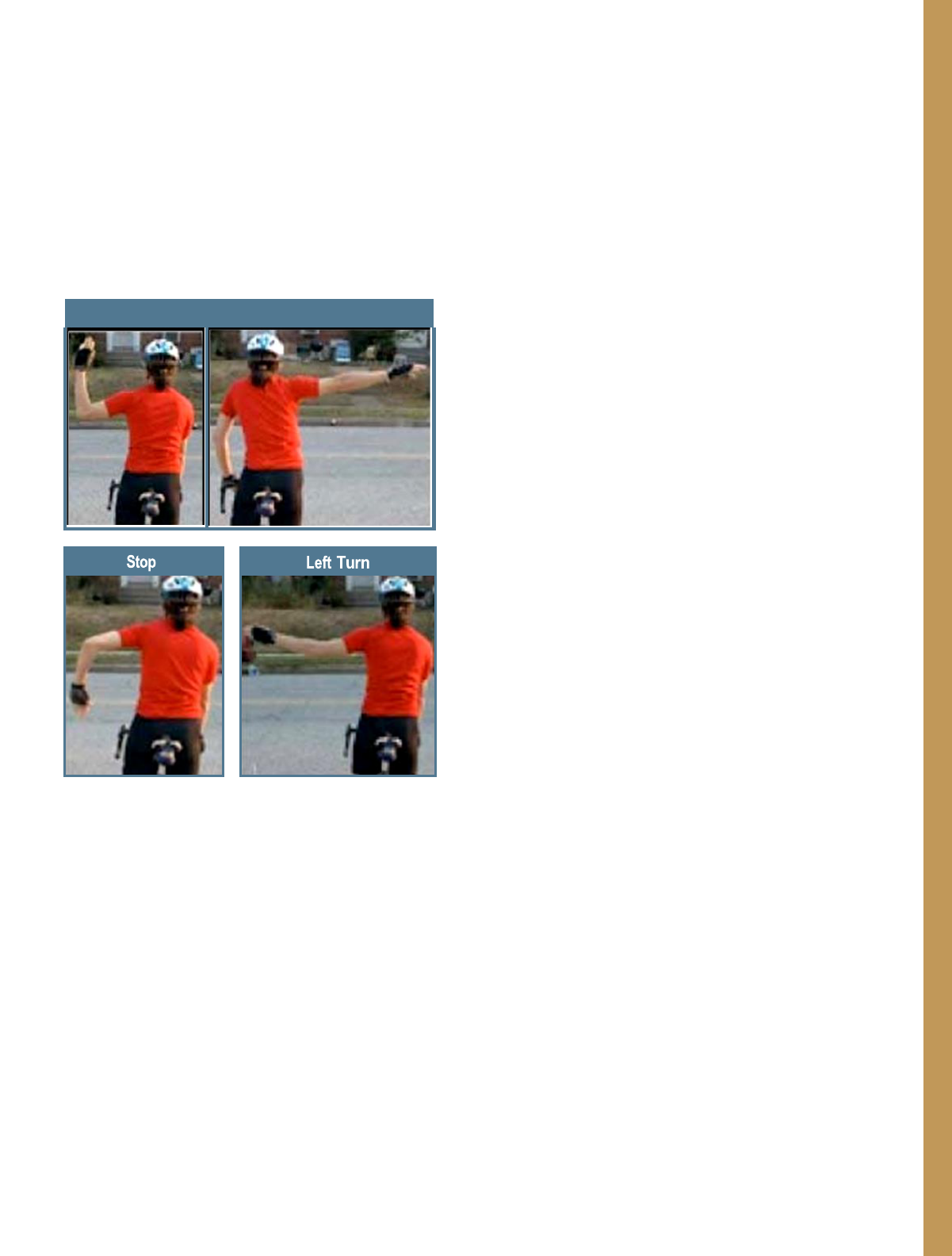
Section Ten: Sharing the Road 60
Cooperate with bicyclists. They are
required to use hand signals when
turning and stopping. However, keep in
mind that bicyclists may be unable to
signal if road or traffic conditions require
them to keep both hands on the handle
bars. Look for other clues of a bicyclist’s
intent, such as turning his or her head or
looking over his or her shoulder before
changing lane position.
When parked on the street, check to the
sides and rear for bicyclists before you
open your vehicle door.
You should check for bicyclists in your
path before backing. Be especially
cautious near schools or residential
areas where bicyclists may be present.
When passing a bicyclist, slow down and
allow as much space as possible, and
consider the bicyclist’s speed when you
pass. At least three feet of space is
recommended when passing bicyclists
and the passing vehicles should move
back into the right lane only when well
clear of the bicyclist.
Some counties have local ordinances.
These control the operation and parking
of bicycles within city limits. As a driver, it
is important for you to know what they
are and to obey them at all times.
Rules for Bicyclists
Never ride on interstates and parkways.
Use hand signals to communicate your
actions to other vehicles.
Obey the instructions of official traffic
control signals and signs. Stop at stop
signs and for stop lights just like a motor
vehicle.
Operate a bicycle within posted speed
limits or at a rate reasonable for existing
conditions.
Ride a bicycle on the right side of the
road with traffic.
Yield to pedestrians in crosswalks and on
sidewalks. Give an audible warning (bell
or horn) before passing pedestrians.
When riding at night, operate the bicycle
with a white light visible from the front
and a red reflector or light visible from the
rear.
All slower-moving vehicles, including
bicycles, shall drive as closely as
practical to the right-hand boundary of
the highway. Extreme caution should be
used when moving out into the center of
the road to avoid road debris, to pass
another vehicle, or to make a left turn.
DO NOT RIDE ON THE SIDEWALK.
Never park a bicycle on a sidewalk in
such a way as to interfere with pedestrian
traffic.
Ride on a bike path adjacent to the
roadway, if one is provided.
Right Turn or Right Turn
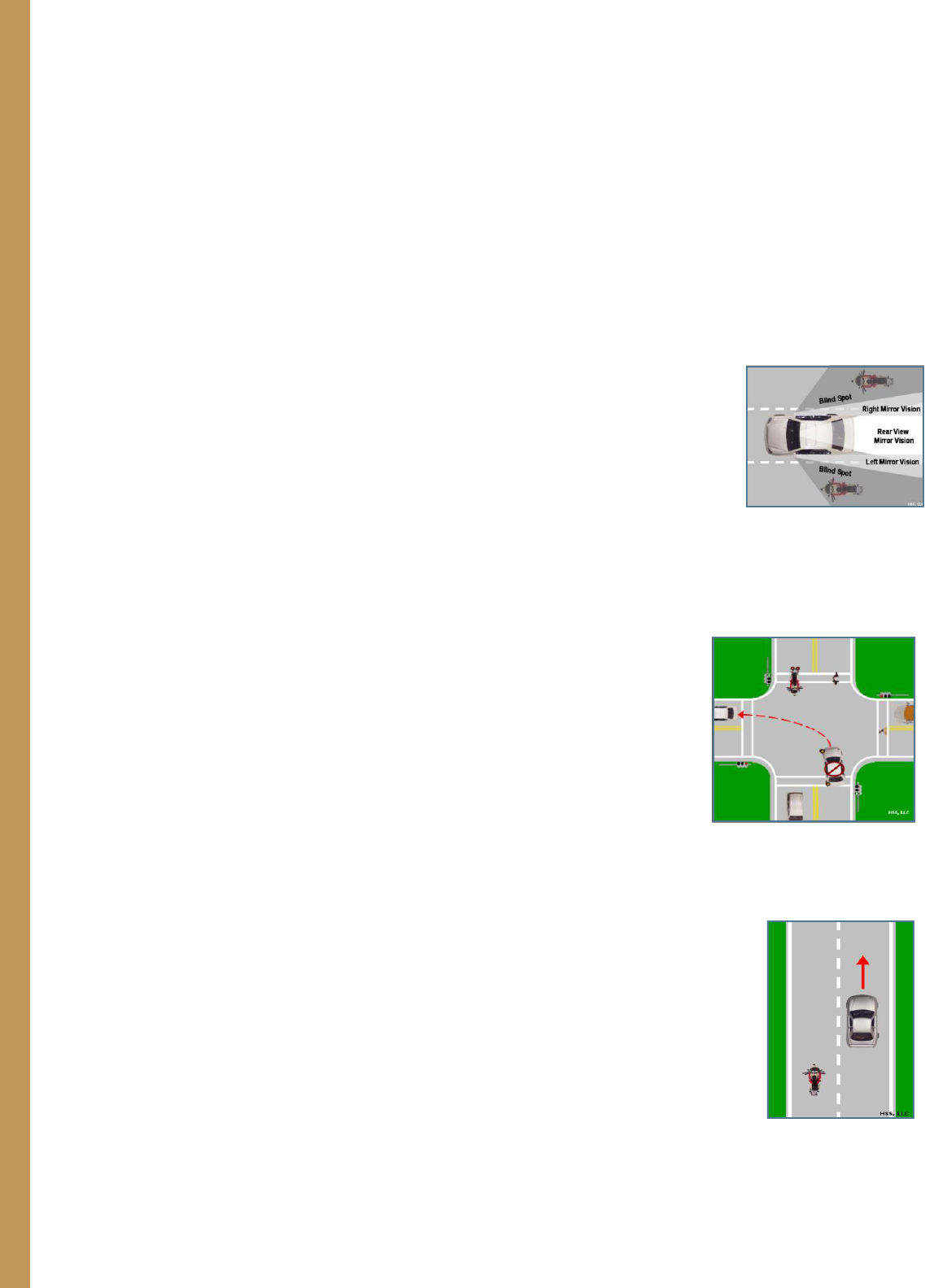
61 Section Ten: Sharing the Road
Carry no more persons than the number
for which the bicycle is designed and
equipped.
Never ride more than two abreast so as
to interfere with the normal movement of
traffic.
Electric Low-Speed Scooter
An electric low-speed scooter is defined as a
device that weighs less than one hundred
(100) pounds and is equipped with wheels,
handlebars, and a brake adequate enough
to stop and park the device. It is designed to
be stood or sat upon and propelled by an
electric motor, human power, or both.
Regardless of the type of propulsion, an
electric low-speed scooter is designed to
operate at a maximum speed of twenty (20)
miles per hour on a paved level surface.
A person sixteen (16) years of age or
older, may operate an electric low-speed
scooter on a highway, bicycle lane, or
bicycle path.
Electric low-speed scooters shall be
subject to traffic regulation in the same
way that bicycles are required to obey
traffic laws, and motorists shall use
caution around them in the same way as
well.
An electric low-speed scooter shall be
equipped with at least one (1) headlamp,
and at least one (1) rear red light. These
lights shall be illuminated from one-half
(1/2) hour after sunset to one-half (1/2)
hour before sunrise or at other times
when there is low visibility.
An electric low-speed scooter may be
parked on a sidewalk if it does not
impede the reasonable movement of
pedestrian or other traffic.
Compliance with all local government
ordinances is required.
Motorcyclists
Motorcyclists have the same rights and
responsibilities as other drivers. However, it
may be more difficult to see them. There are
special situations and conditions we need to
be aware of so we can safely share the road
with motorcycles:
Allow a motorcyclist a full lane width. Do
not share the lane. The motorcycle needs
space for the motorcyclist to react to
other traffic.
Motorcycles are
small and therefore
more difficult to see.
Be aware that
motorcycles can be
part of the traffic
mix. Always check
your mirrors and blind spots for them.
Before turning left, be alert for
motorcycles by looking carefully to the
front and sides of your vehicle.
Do not assume
a motorcycle is
turning when
you see its turn
signal flashing.
Motorcycle turn
signals may not
self-cancel, and
the motorcyclist
may have forgotten to turn them off. Wait
to be sure the rider is going to turn before
you proceed.
When following a
motorcyclist, allow for
a minimum 4-second
following distance or
more in wet
conditions, or you may
not have enough time
or space to avoid a
crash.

Section Ten: Sharing the Road 62
Motorcycle riders may suddenly need to
change speed or adjust lane position to
avoid hazards such as potholes, gravel,
wet or slippery surfaces, pavement
seams, railroad crossings, and grooved
pavement, which can be deadly to a
motorcyclist.
Keep in mind that scooters and mopeds
travel at much lower speeds than
motorcycles.
Commercial Vehicles
More than 250,000 crashes occur between
cars and commercial vehicles each year.
Many of these crashes could be avoided by
keeping these points in mind:
Commercial vehicles are generally larger
and less maneuverable than cars.
These vehicles have much larger blind
spots than cars.
They have longer stopping and
accelerating distances and need more
room to turn.
The No Zone
The no zone is the area around large trucks
or buses where vehicles disappear from the
commercial driver’s view into blind spots.
These blind spots are on the sides, rear, and
front of the large vehicle.
Side No Zones – Large trucks and buses
have big no zones on both sides. They are
much larger than your vehicle’s blind spots.
Trucks have a larger blind spot on their right
side starting behind the cab and extending
up to the length of the truck.
If you cannot see the driver’s face in the side
view mirror, he or she cannot see you. When
possible, avoid driving alongside large
vehicles. If the driver needs to swerve or
change lanes, the chances of a crash are
greatly increased.
Front No Zones –
Because of a large
vehicle’s size and
weight, they take
longer to stop than
cars.
A loaded truck with good tires and properly
adjusted brakes, under ideal conditions,
traveling at 55 mph requires at least 335 feet
before coming to a complete stop, or greater
than 1½ times the stopping distance of a car.
Therefore, it is essential not to change lanes
in front of a large vehicle or enter a roadway
in front of a large vehicle. When passing a
large vehicle, look for the whole front of the
vehicle in your rear-view mirror before
pulling in front and maintaining speed.
Rear No Zones –
Unlike cars, large
vehicles have huge
blind spots directly
behind them that
extend up to 200 feet. If
you are too close, the
large vehicle cannot see your car, and you
cannot see what is ahead of you. If the large
vehicle brakes or stops suddenly, you have
no place to go and could run into the vehicle.
To prevent this, you need to pay close
attention when following a large vehicle.
Avoid following the vehicle too closely and
position your vehicle so the driver can see it
in his or her side mirrors. When traveling up
or down steep hills, large vehicles must drive
slowly, approximately 35 mph and therefore
use the right lane. Avoid driving in the right
lane, if possible, when traveling up or down
hills, as well as near truck weigh stations,
where large vehicles will be attempting to re-
enter faster moving traffic. By avoiding the
right lane in these areas, you will reduce the
possibility of a crash.

63 Section Ten: Sharing the Road
Turning
Pay close attention
to large vehicles
turn signals and
give them plenty of
room to maneuver.
When a truck or bus
needs to make a
right turn, the driver will sometimes swing
the vehicle wide to the left to safely turn right
and clear the corner of a curb or other
obstruction. Sometimes space from other
lanes is used to clear corners. If you try to
get in between the truck or bus and the curb,
you will be squeezed in between the vehicle
and could suffer a serious crash. To avoid a
crash, do not turn until the truck or bus has
completed its turn.
Keep in mind:
When you meet a truck coming from the
opposite direction, keep as far as
possible to the right side of the roadway
to avoid a side-swept crash and to
reduce the wind turbulence between the
two vehicles, which pushes the vehicles
apart.
Many crashes with large vehicles occur
at intersections because motorist are
unable to judge accurately the speed of a
truck approaching before making a left
turn. When in doubt about the speed of
an oncoming truck or bus, do not turn left
in its path. The truck or bus may be going
faster than you think, and it takes longer
for the truck or bus to stop than a car.
Many intersections are marked with stop
lines to show where you must come to a
complete stop. These stop lines help to
set you farther back at an intersection to
give larger vehicles more turning space.
Always stop behind stop lines.
Do not cut off a large vehicle in traffic or
on the highway to reach an exit or turn or
to beat a truck into a single-lane
construction zone. The few seconds that
might be saved are not worth a life.
On mountain roads or downgrades,
watch for fast-approaching trucks. If one
seems out of control or unable to slow
down, get out of the way.
On long downgrades, there are
sometimes special “escape” or “runaway”
ramps for trucks. These ramps are for
use only by large vehicles that are out of
control or cannot stop because of brake
failure. Never stop or park in the vicinity
of these ramps.
When stopped behind a truck on an
upgrade, stay to the left of your lane
where the driver can see you. Allow extra
space between you and the truck in case
the truck drifts backwards slightly.
Avoid driving in the right lane in the
vicinity of truck weigh stations where
slow-moving trucks will be attempting to
reenter faster-moving traffic. You will
reduce the possibility of rear-ending or
being rear-ended by a large vehicle.
Avoid driving near vehicles carrying
hazardous materials. These vehicles will
be clearly marked with the type of
hazardous materials they are
transporting. Vehicles carrying hazardous
materials must stop at all railroad
crossings. Be prepared.
Emergency Vehicles
Emergency vehicles will be equipped with
sirens, flashing lights, and special horns to
help them move through traffic.
As a driver, you must yield right-of-way to an
emergency vehicle when the flashing lights
and siren are on by pulling over to the edge
of the road so the emergency vehicle(s) may
pass. Avoid blocking intersections. Kentucky
law specifically requires drivers to yield the
right-of-way to any vehicle displaying a
flashing red or blue light or sounding a siren.

Section Ten: Sharing the Road 64
When you become aware of the approach of
a vehicle displaying a flashing red or blue
light, or when you hear a siren, you must
immediately drive to the right side of the
road or to the curb, clear of any intersection,
and stop. You must remain stopped until the
emergency vehicle has passed, unless you
are directed by a police officer or a firefighter
to move.
It is also unlawful to follow any emergency
vehicle closer than 500 feet.
Police and Traffic Stops
What to do and expect when pulled over by
law enforcement:
In order to pull you over, the police will
activate the lights and siren on the police
vehicle. Stay calm if this occurs, and do
not bring your vehicle to an abrupt stop
on the travel portion of the roadway.
Turn off your engine. Turn on your
hazard flashers and, if at night, your
interior lights to help the officer see that
everything is in order inside the vehicle.
Completely roll down your window so that
you and the officer can communicate.
Remain calm and keep your safety belt
fastened. Ask your passenger(s) to do so
as well.
Do not start gathering your driver’s
license, registration, and insurance.
Instead, keep your hands on the steering
wheel and limit movements so the officer
does not think you are hiding or
searching for something.
When requested, locate, and provide
your driver’s license, proof of insurance
and vehicle registration. Before reaching
for these documents, first tell the officer
where they are located. Then reach for
them slowly with one hand on the wheel.
Answer the officer’s questions fully and
clearly. Remain in the vehicle unless
requested to get out.
If you receive a citation, remain calm and
do not argue with the law enforcement
officer. Roadside traffic stops are not the
proper or safe place to lodge complaints
or resolve disputes.
There are various reasons why an officer
could ask you to stop or to get out of your
vehicle. Listen carefully, follow all
instructions given, and be patient with the
investigative process.
Never try to run from law enforcement. It
is very dangerous, and many fatal
crashes occur from police chases. The
consequences of running from law
enforcement are often more severe than
the initial traffic citation.
Once the officer has indicated the traffic stop
is finished, please follow these steps while
driving away to ensure your safety and that
of the officer:
Wait for the officer to return to the law
enforcement vehicle;
Be aware of traffic and your surroundings;
Watch for departing police vehicle;
Use your turn signal to reenter traffic; and
Obey all traffic laws.
Note: What to Do and Expect When Pulled Over by Law
Enforcement was developed by the AAMVA (American
Association of Motor Vehicle Administrators) Law
Enforcement Standing Committee. Additional information
can be found at https://www.aamva.org/law-
enforcement/what-to-do-when-stopped-by-law-enforcement
Move-Over Laws
The incidents of law enforcement officers,
emergency medical services, and fire
department personnel being struck while
performing duties at the roadside are
increasing at a frightening pace.
To lessen the problem, move-over laws have
been enacted, which require drivers to slow
and change lanes when approaching a
roadside incident. Signs are posted on
roadways in states that have such laws.
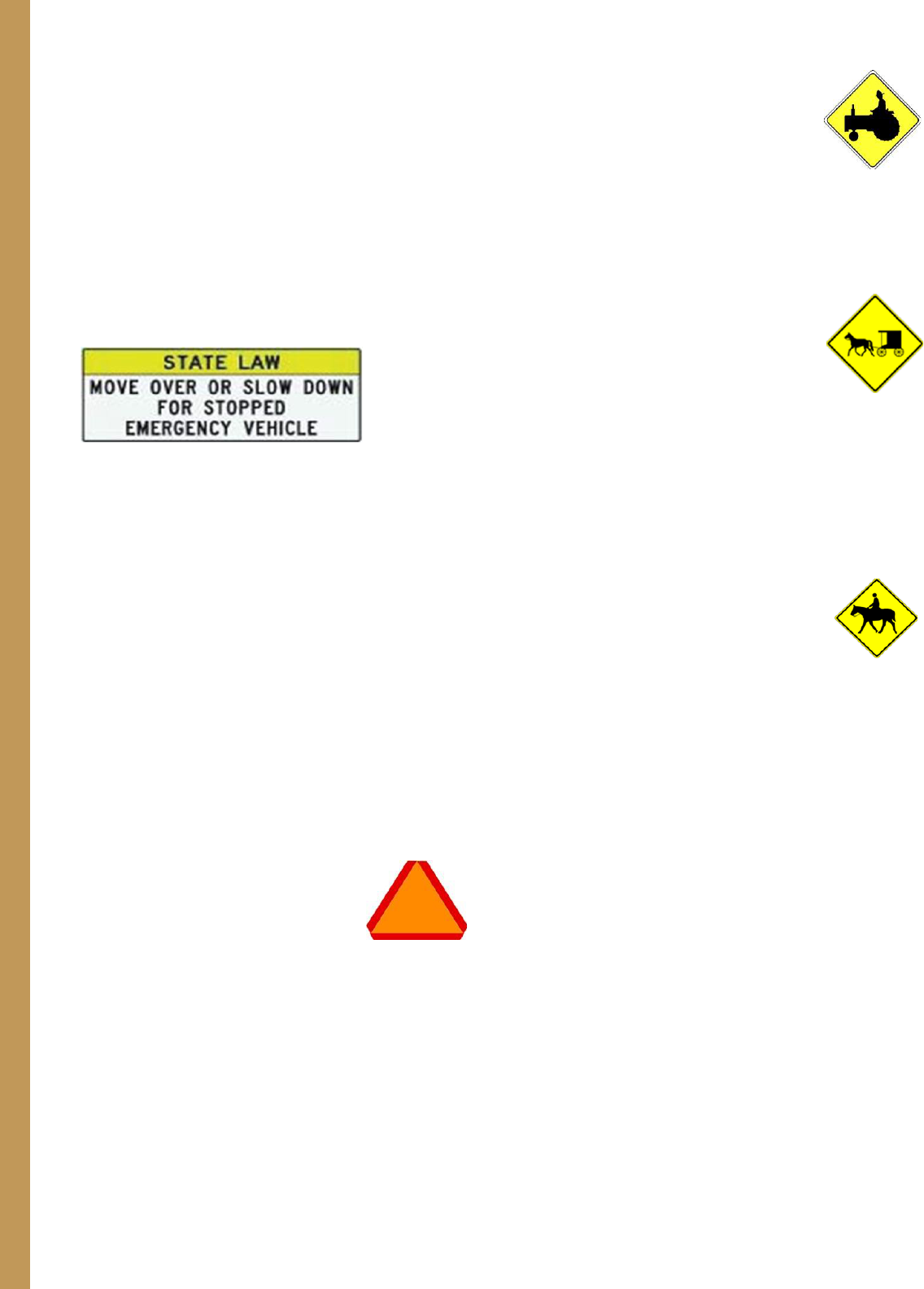
65 Section Ten: Sharing the Road
When approaching an authorized
emergency vehicle stopped on the roadside,
you should proceed with caution by slowing
and yielding the right-of-way by making a
lane change into a lane not next to that of
the authorized emergency vehicle if safety
and traffic conditions permit. If a lane
change is unsafe, slow down and proceed
with caution while maintaining a safe speed
for traffic conditions.
Kentucky Move-Over Laws
Kentucky law provides additional clarity to
move-over laws:
Drivers are required to exercise due
caution when approaching police or other
emergency vehicles stopped on the
shoulder of the roadway.
Approach slowly and move into the left
lane on four-lane highways if it is safe to
do so.
On two-lane highways, approach slowly
and pass with caution.
Slow-Moving Vehicles
Be alert for slow moving vehicles,
especially in rural areas. A
fluorescent or reflective orange
and red triangle displayed on the
rear of vehicles drawn by animal, farm
equipment, or construction equipment means
the vehicle is traveling less than 25 mph.
During the day, you will see the fluorescent
orange triangle in the center of the symbol.
During night driving, you will see the reflective
red boarder of the symbol. Use caution when
approaching a slow-moving vehicle and be
sure it is safe before you pass.
Farm machinery – Watch for
tractors, combines, and other farm
equipment moving across the road
and traveling on state highways in
rural areas. Pass with caution and
remember that the operator of the farm
machinery cannot hear approaching vehicles.
Animal-drawn vehicles and horseback
riders – In some rural areas, you
may be sharing the road with
animal drawn vehicles and
horseback riders. They have the
same rights to use the road as a
motor vehicle and must follow the same rules
of the road. They are subject to heavy damage
and injury to the occupants if hit by a vehicle.
Pass with caution and do not use your horn or
“rev” the engine because this may scare the
horse and cause a crash. To avoid other
possible crashes, you should anticipate left
turns made by animal-drawn vehicles into
fields and driveways. Warning
signs will be posted in areas where
you are likely to find animal-drawn
vehicles and horseback riders, so
be alert.
All-Terrain Vehicles (ATVs)
Kentucky law defines an all-terrain vehicle
(ATV) as any motor vehicle used for
recreational off-road use. A person shall not
operate an ATV upon any public highway or
roadway or upon the right-of-way of any public
highway or roadway. There are some
exceptions to this restriction, and drivers
should be aware that they may need to share
the road with an all-terrain vehicle. Similarly,
any operator of an all-terrain vehicle should
become familiar with all laws and restrictions
before operating the vehicle.

Section Ten: Sharing the Road 66
Restrictions and Exceptions
A person shall not operate an ATV on
public or private property without
consent, or without wearing
Transportation Cabinet approved
protective headgear at all times when in
motion on public property.
If under sixteen (16) years of age shall
not operate an ATV except under direct
parental supervision, and not without
approved protective headgear at all times
the vehicle is in motion.
A parent or legal guardian of a minor who
is under the age of sixteen (16), or who
does not possess an instruction permit,
an intermediate license, or an operator’s
license, shall not knowingly allow that
person to carry a passenger while
operating an ATV.
A person may operate an ATV on any
two-lane public highway to cross the
highway. While crossing, the operator
shall cross at as close to a ninety (90)
degree angle as is practical and safe and
shall not travel on the highway for more
than two-tenths (2/10) of a mile.
A person may operate an ATV on any
two-lane public highway, if the operator is
engaged in farm or agricultural related
activities, construction, road
maintenance, or snow removal.
A person who operates an ATV on a
public highway must have:
■
A valid operator’s license and comply
with all traffic regulations;
■
Must have at least one headlight and
two taillights illuminated at all times;
■
May only operate during daylight
hours, unless engaged in snow
removal efforts or emergency road
maintenance.

67 Section Eleven: Special Driving Situations
Section Eleven
Special Driving
Situations
Night Driving
Driving at night is more difficult and
hazardous than daytime driving. The
distance you can see in front is limited by
light provided by your headlights. You can
do these things to help with night driving:
Use your high beams
whenever there are no
oncoming vehicles. High
beams let you see twice
as far as low beams.
Dim your high beams for
approaching traffic. If a
vehicle comes toward you
with their high beams on,
look toward the right side
of the road to keep from
being distracted or
momentarily blinded by their headlights.
Use your low beams
when following another
vehicle, and in fog, rain,
or snow. Light from your
high beams may cause
glare, making it more
difficult to see ahead.
Some vehicles have fog lights that you
can use in fog, snow, or rain.
Avoid looking directly into oncoming
headlights. Keep your eyes searching the
road in front of your vehicle.
Try to search well ahead of your
headlight beams, looking for dark shapes
on the roadway.
Dim your lights whenever you come
within 500 feet of oncoming vehicles, and
within 300 feet of any vehicle you are
following.
Glance occasionally to the right and left
to determine the location of the edge of
the pavement and hazards that may
come from the sides.
Do not wear sunglasses or colored
lenses when driving at night or on
overcast days. Tinted or colored lenses
reduce your vision.
Increase your following distance by
adding at least one additional second for
night driving conditions and at least two
additional seconds for driving on
unfamiliar roadways at night.
The best rule to remember is to turn your
headlights on whenever you have trouble
seeing other vehicles. If you have trouble
seeing another vehicle, chances are the
driver is having trouble seeing your
vehicle.
Funeral Processions
A funeral procession has the right-of-way at
an intersection and may pass through the
intersection if the procession is led by an
escort vehicle displaying flashing yellow, red,
or blue lights. The only exceptions are when
the right-of-way is required by an emergency
vehicle, when vehicles in the procession are
directed otherwise by a police or safety
officer, or when the vehicle is a train or
locomotive. You must not drive your vehicle
between the vehicles of a funeral procession
except when authorized to do so by a police
or safety officer. Do not turn on your
headlights or engage in any other act for the
purpose of securing right-of-way. Do not
pass or overtake any vehicle in the
procession unless directed to do so by a
police or safety officer, or unless the
procession is on a street, road, or highway
outside the city, town, or urban-county limits
This Section Covers
•
Night Driving
•
Funeral
Processions
•
Work Zones
•
Rural Road
Driving
•
Autocycles
•
Safe Trailering

Section Eleven: Special Driving Situations 68
or unless the procession is on an interstate
highway or state parkway. If you violate this
law, you may receive a $250 fine or 90 days
in jail.
Work Zones
A work zone is an area where roadwork
takes place and may involve lane closures,
detours, and moving equipment.
Work zones have become increasingly
dangerous for both workers and drivers.
Approximately 40,000 people per year are
injured as a result of motor vehicle crashes
in work zones.
When approaching a work zone, watch for
signs, cones, barrels, large vehicles, and
workers. Work zone signs have an orange
background and black letters or symbols.
Always reduce your speed in a work zone,
even if there are no workers. The
narrower lanes and rough
pavement can create a
hazardous condition.
Note that Kentucky law allows for fines to be
doubled in a highway work zone when signs
are displayed informing drivers of the
existence of a highway work zone and that
fines are double in it. Additionally, at least
one (1) bona fide worker must by present.
As a driver, in a work zone, you should:
Reduce your speed, increase your
following distance, watch the traffic
around you, and be prepared to stop.
Use extreme caution when driving
through a work zone at night whether
workers are present or not.
Adjust your lane position to allow space
for workers and construction vehicles.
Observe the posted work zone signs until
you see “End Road Work.”
Expect delays, plan for them, and leave
early to reach your destination on time.
When you can, use alternate routes and
avoid work zones.
Rural Road Driving
Driving on rural highways can be dangerous.
Stay alert, watch for warning signs, and obey
the speed limit. Some road conditions and
driving hazards are unique to rural roads. It
is important to understand the different road
conditions that you may experience on rural
roads:
Gravel or dirt – Traction can be reduced on
gravel or dirt roads. You should reduce your
speed, increase your following distance and
realize you may skid when trying to stop
your vehicle.
Narrow roads – Rural roads are generally
narrower and may have ditches or drop offs
instead of shoulders. You should reduce
your speed, center your vehicle in your lane,
and watch for oncoming traffic that may
attempt to share your lane.
Narrow and single-lane bridges – You
should look for warning signs identifying
narrow or single-lane bridges. Take turns
crossing the bridge; generally, the first driver
to the bridge has right of way.
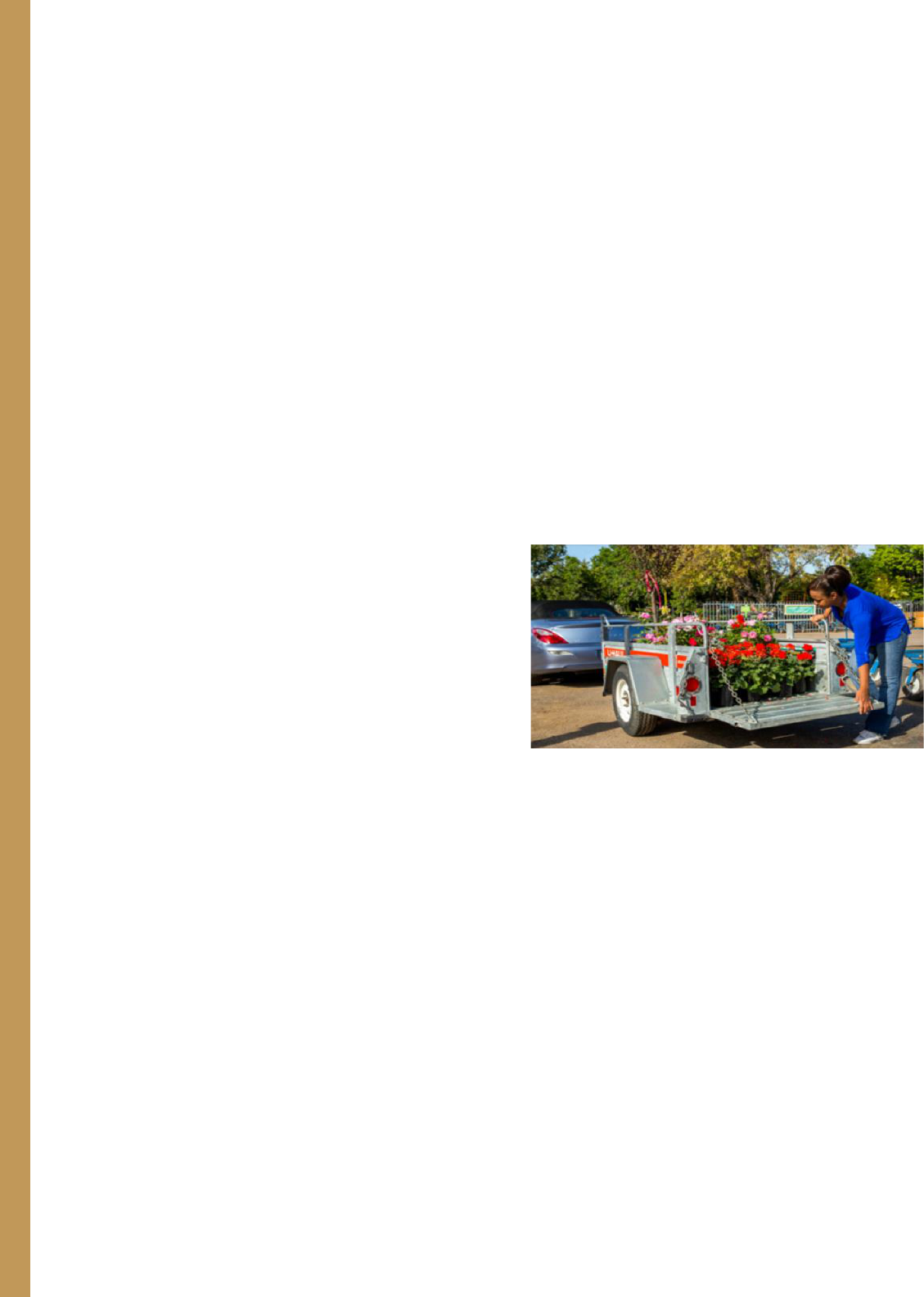
69 Section Eleven: Special Driving Situations
Open bridge gratings or steel bridges –
Can reduce your traction. Reduce your
speed, increase your following distance, and
maintain a firm grip on the steering wheel.
Areas of reduced vision – Blind corners
created by wooded areas, crops growing in
fields and steep hills can limit how far you
can see. In areas with reduced vision always
reduce your speed and be prepared to stop.
Uncontrolled intersections – Some rural
intersections are not controlled by yield or
stop signs. These intersections can be very
dangerous, so approach them with caution.
When approaching an uncontrolled rural
intersection, slow down and be prepared to
stop for crossing or oncoming traffic.
Autocycles
An autocycle is a motor vehicle that is
uniquely defined, placing it in a category all
by itself. An autocycle has the following
characteristics:
Any operator or passenger is seated as
they would be in a passenger car;
Autocycles travel with three (3) wheels in
contact with the ground;
Autocycles operate at a speed that
exceeds forty (40) miles per hour;
The operator and passenger ride either
side-by-side or in tandem in a seating
area that may be enclosed with a
removable or fixed top;
Is equipped with a three (3) point safety
belt system;
May be equipped with manufacturer-
installed air bags or a roll cage;
Is designed to be controlled with a
steering wheel and pedals; and is not an
alternative-speed motorcycle.
An autocycle is a special case because it is
considered to be a motorcycle and shall
comply with all traffic regulations. However,
an operator of an autocycle is not required to
obtain a motorcycle license or endorsement,
and may operate the vehicle if the operator
is in possession of a valid operator’s license.
An operator of an autocycle is also exempt
from any headgear requirements.
Safe Trailering
Towing a Trailer
Many people are surprised at the extent of
trailer towing. Trailers are towed billions of
miles every year. Mobility, increased leisure
time, popularity of do-it-yourself projects and
cost consciousness have created a need
which can be best satisfied by vehicles
towing trailers. Thus, even though towing a
trailer may be an occasional practice for
individuals, it is a common occurrence
everyday across the nation.
The Most Important Part…You
Your judgement and common sense are key
to a safe trailering experience. Driver error is
a contributing factor in the large majority of
collisions and crashes involving vehicle-
trailer combinations. It is vital that you make
sure to hook up, load, and operate the
vehicle-trailer combination properly.
Loading a Trailer
Trailers must be loaded heavier in the front.
Loading heavier items in the front of the
trailer reduces the possibility of sway. Failure
to load the trailer heavier in the front is a
leading cause of vehicle-trailer mishaps.
Sixty percent of the cargo weight of a trailer
should go in the front (nearest the towing
vehicle) and 40 percent in the back.

Section Eleven: Special Driving Situations 70
If the trailer begins to sway or whip, steer
straight and reduce speed gradually, do not
apply the brakes. Never increase speed.
Stop as soon as you can safely get
completely off the roadway. Check the cargo
first to be sure the trailer is loaded heavier in
front. Reload if necessary. Keep heavy items
on the floor of the trailer, not packed on top
of other items. Pack your cargo tightly and
secure any partial loads with tie-downs.
Safe Driving With a Trailer
Safe trailering simply involves adopting a
good compensatory attitude. Even the most
experienced drivers will compensate for the
peculiarities of the vehicle they are driving.
Trailering is no different. No matter how
much experience people have, they cannot
change the vehicle they are operating to fit
their driving habits, but instead must change
their driving to fit the vehicle. The mind must
be adjusted to accept a slower pace of
travel. Drive more slowly when towing. The
maximum recommend speed for most
vehicle-trailer combinations is 55 mph.
Driving slower also saves fuel and reduces
your chances of losing control. Never
exceed the posted speed limit. If driving
conditions worsen, you must reduce speed
even more. When going down a grade, slow
down BEFORE starting down the hill.
A vehicle-trailer combination requires more
distance to stop. Allow extra space between
your vehicle and the vehicle ahead of you
when towing. When driving in rain, snow, or
fog, allow even more space. When towing,
your vehicle will require more distance to
pass on hills or curves. When making turns
while towing a trailer, remember that the
trailer does not follow directly behind the car.
The trailer may require extra room to safely
turn.
When backing up a trailer, go slowly. Keep
your hand at the bottom of the steering
wheel. To move the trailer left, move your
hand to the left. To move to the right, move
your hand to the right. If the trailer starts to
jackknife – STOP – and pull ahead to
straighten out; then start again.
“Pro” Driving Tips
If you are unsure how to properly
hookup, load, or drive with a trailer, seek
advice from a trailer professional.
Recognize you are no longer driving a
vehicle but a vehicle-trailer combination.
Before driving and at each fuel stop, walk
around the vehicle-trailer combination
and recheck the hitch and coupler
tightness, safety chains attachment,
lights, and tire pressures.
If, while driving, you hear an unusual
noise or suspect trouble, stop at a safe
place off the roadway to check on the
problem.
If you are driving a long distance, do not
attempt to drive “straight through.” Plan a
rest stop so you can drive in daylight
while rested and alert.
Safe Trailering Checklist
Load Heavier in Front
Hitch Tight
Chains Attached
Lights Working
Tire Pressures OK
Reduce Speed
Think Ahead
Stop Often for Rest
Inspect Often
Load Secure
Wear Your Seat Belt

71 Section Twelve: Test Your Knowledge
Section
Twelve
Test
Your
Knowledge
Select the alternative (a, b or c) that best
answers the question.
1. Alcohol and other impairing drugs
a. reduce your judgment.
b. decrease your reaction time
.
c. improve your ability to focus
.
2. A yellow dashed line on your side of the
roadway only means
a. passing is prohibited on both sides
.
b. passing is permitted on both sides
.
c. passing is permitted on your side
.
3. If you arrive at a four-way intersection
controlled by stop signs at the same time
as another driver, you should
a. continue through the intersection
.
b. yield the right of way to the driver on
your right
.
c. let the driver on your left go first
.
4. Which sign warns a divided highway
begins?
5. This road sign means
a. right curve
.
b. curvy road ahead
.
c. sharp curve ahead
.
6. Regulatory signs are:
a. green
.
b.
yellow.
c.
white.
7. If a pedestrian is crossing in the middle of
the street, not at a crosswalk (also known
as jaywalking), even if it is illegal, you
a. must stop for them
.
b. do not have to stop for them
.
c. should honk your horn at them
.
8. Motorcycle operators have the right to
a. use a complete traffic lane
.
b. share a traffic lane with a vehicle.
c.
use the shoulder of a roadway
.
9. When approaching or passing a bicyclist,
you should
a. slow down and allow as much space
as possible
.
b. sound your horn to alert your
presence
.
c. speed up and quickly pass the
bicyclist
.
10. When driving at night use your high
beams when
a. fog, rain, or snow is present.
b. following another vehicle.
c. there is no oncoming traffic
approaching.
11. A distraction is anything that takes your
attention away from
a. traffic lights and signs.
b. driving
.
c. the road in front of you.
Correct Answers:
1
.
a; 2
.
c; 3
.
b; 4
.
a; 5
.
c; 6
.
c; 7
.
a; 8
.
a; 9
.
a; 10
.
c 11. b
This
Section
Covers
•
Sample Knowledge Test Questions

72
American Association of Motor Vehicle Administrators. (2021, February).
Strengthening distracted driving education, legislations, and enforcement: A
whitepaper augmenting safe testing and deployment of vehicles equipped with
automated driving systems guidelines. Retrieved from: Distracted-Driving-
Education-Legislation-and-Enforcement-Whitepaper_Final.pdf (aamva.org)
National Highway Traffic Safety Administration (NHTSA), Department of
Transportation (DOT). (2016, December). Visual-manual nhtsa driver
distraction guidelines for portable and aftermarket devices. p. 67-69. Retrieved
from: Federal Register :: Visual-Manual NHTSA Driver Distraction Guidelines for
Portable and Aftermarket Devices
Virginia Tech Transportation Institute. (2013, May, 2
nd
edition). New vtti study results
continue to highlight the dangers of distracted driving. Retrieved from: New
VTTI study results continue to highlight the dangers of distracted driving – Virginia
Tech Transportation Institute
2022 © Copyright All Rights Reserved
American
Association
of
Motor
Vehicle
Administrators
This manual is a supplement to the state’s driver manual which covers rules of the road, signs,
signals, roadway markings and safe driving
practices.
Graphics and pictures contained within this manual are provided courtesy of Motorcycle Safety
Foundation and Highway Safety Services, LLC
American
Association of
Motor
Vehicle Administrators
4401
Wilson Blvd, Suite 700
Arlington, Virginia 22203
703.522.4200
I
aamva.org
